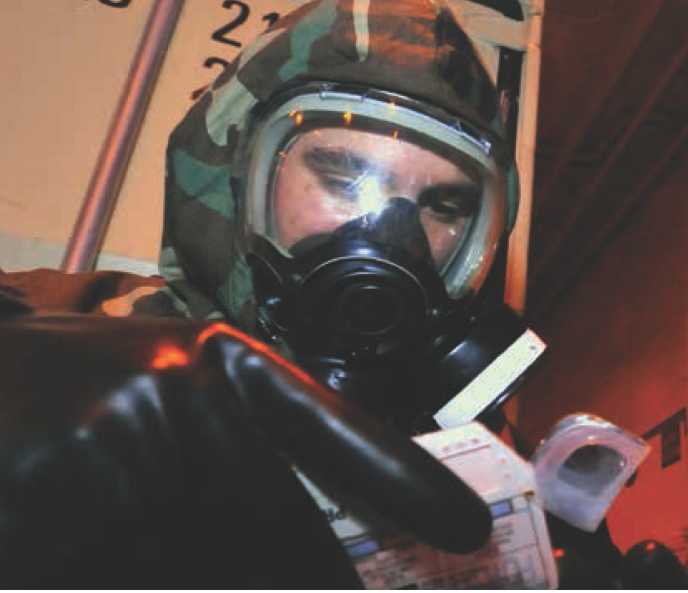
Description
The Individual Protective Equipment-Readiness Improvement Program for forces afloat manages millions of individual pieces of equipment for Sailors deploying into potential chemical, biological, radiological, and nuclear (CBRN) threat environments. Through centralized management, this program ensures that afloat and deployed expeditionary Sailors are provided with correctly maintained and properly fitted individual protection ensembles and a chemical protective mask, ready for immediate retrieval in response to the mission-oriented protective-posture condition. Historically, maintenance and logistics functions required to maintain the material readiness of this equipment required an extraordinary number of organizational man-hours that could be better used supporting operations and training. Ninety-day pre-deployment readiness visits by the Naval Sea Systems Command RIP Team relieve the ships of this burden. The cornerstone of the RIP is the NAVSEA Consolidated Storage Facility located at Ft. Worth, Texas.
Status
This program continues to improve fleet CBR readiness. In addition to IPE and gas masks, the RIP manages interceptor body armor, dorsal auxiliary protective systems, and lightweight helmets for expeditionary forces; provides protective CBRN equipment to Navy individual augmentees as they process through designated Army training centers; and manages CBR and nuclear-defense IPE for the Military Sealift Command as well as medical counter-measures for BUMED. In addition, the Navy has shifted from its traditional lifecycle replacement program and has implemented a condition-based obsolescence program to better sustain fleet CBRN-defense equipment. The Joint Program Executive Office for Chemical and Biological Defense Programs (JPEO CBDP) has adopted this efficiency plan for implementation across the entire CBDP enterprise.
Developers
Battelle Memorial Institute Columbus, Ohio
General Dynamics Information Technology Fairfax, Virginia Gryphon Technologies Washington, D.C.
Naval Surface Warfare Center Panama City, Florida
* * * * * * * * * * * *
Improved (Chemical Agent) Point Detection System (IPDS)-Lifecycle Replacement
Description
The Improved (Chemical Agent) Point Detection System-Life-cycle Replacement is a it, form, and function life-cycle replacement for legacy IPDS systems providing naval ships an automated chemical (vapor) point-detection capability afloat with enhanced detection and reliability. The system is designed to automatically detect and identify chemical vapors by agent class (nerve, blister, and blood) and type agent within a specified concentration level and time period. Successful detection of a chemical vapor at the required threshold concentration warns a ship of an imminent chemical attack to provide sufficient time for the crew to seek shelter inside a collective protected zone or don personal protective equipment, including a filtered mask, before the concentration reaches a critical level.
Status
IPDS-LR achieved initial operational capability in March 2013 with more than 30 systems fielded for ships, training facilities, and spares. IPDS-LR achieved 17 installs in FY 2016, and 18 installs are scheduled for FY 2017.
Developers
Bruker Billerica, Massachusetts
* * * * * * * * * * * *

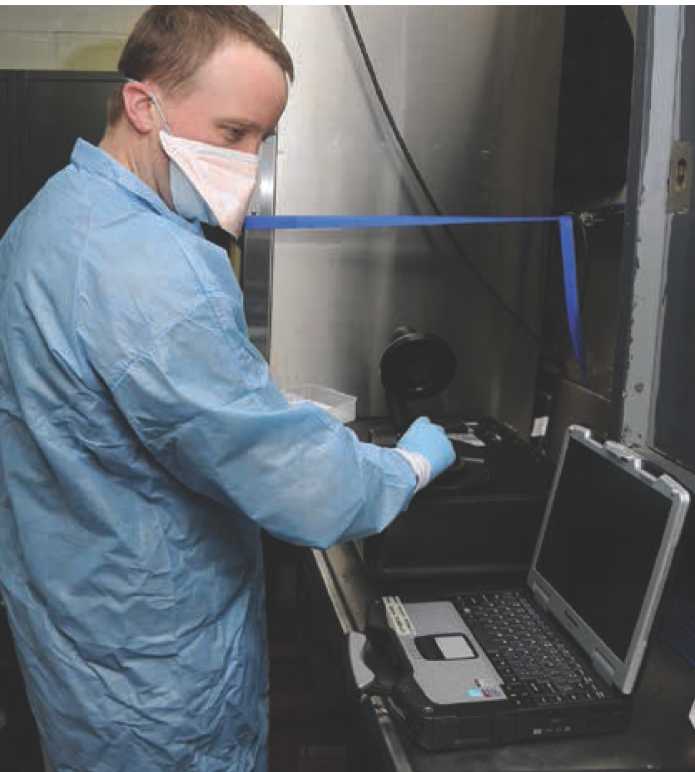
Joint Biological Tactical Detection System (JBTDS)
Description
The Joint Biological Tactical Detection System Acquisition Category III program will be a lightweight biological agent system that will detect, warn, and provide presumptive Identification and samples for follow on confirmatory analysis. JBTDS will provide a local alarm and when networked a cooperative capability with reduced probability of false alarms. JBTDS will provide a biological detection capability to detect, collect, and identify biological aerosol hazards to support mission-oriented protective-posture decisions and downwind hazard warning at the tactical and operational levels. JBTDS will be operable across the full spectrum of operations in multiple environments. The system will support naval forces during periods of increased biological threat, as well as during routine biological surveillance operations, by providing near real-time detection of biological attacks and notification to personnel in the potential hazard area. JBTDS will ultimately support force protection and survivability and maximize combat effectiveness by enhancing medical response decision making.
Status
JBTDS Milestone B was achieved May 2014 and will reach Milestone C in FY 2018 with fielding planned for numerous ship classes (e.g., aircraft carriers, cruisers, destroyers, small combatants, amphibious ships, mine countermeasures ships, command ships, and combat logistics force vessels), and initial operational capability in FY 2020.
Developers
Multiple sources.
* * * * * * * * * * * *
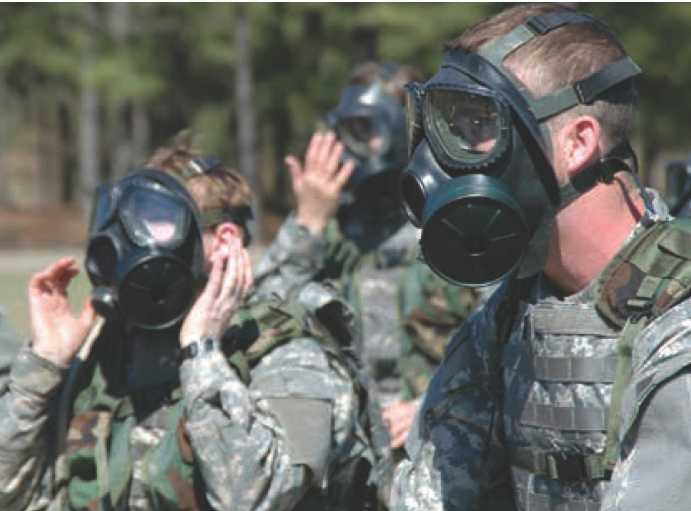
Next-Generation Chemical Detection (NGCD)
Description
The Next-Generation Chemical Detector comprises several detection systems for multi-phase matter sampling, locating of liquid and solids on surfaces, and vapor and aerosol monitoring. NGCD will detect and identify nontraditional agents (NTAs), chemical warfare agents (CWAs), and toxic industrial chemicals (TICs) in the air and on surfaces. NGCD will provide improved CWA/ TIC selectivity and sensitivity on multiple platforms as well as multiple environments. These sensors will improve detection, consequence management and reconnaissance, and weapons of mass destruction interdiction capabilities. The three detectors are as follows: (1) Detector Alarm provides NTA aerosol detection, (e.g., chemical event warning) and improved CWA and TIC vapor detection (e.g., naval ship contamination survey); (2) Survey Detector provides rapid interrogation of NTA and CWA liquid and solid detection on surfaces, (e.g. dismounted reconnaissance/ VBSS operations); and (3) Sample Analysis provides analytical identifier of solids, liquids, aerosols and vapors, (e.g., to support characterization of the residual hazard after a chemical event to inform protection decisions).
Status
The acquisition strategy for this program is technology driven. The Joint Project Manager for Nuclear, Biological and Chemical Contamination Avoidance (JPM NBC CA) is procuring prototypes for the program's technology maturation risk reduction phase with final prototype testing and early operational assessment scheduled for FY 2017. The Joint Project Manager NBC CA will use the final prototype test results to inform the Milestone B decision, engineering manufacturing development, and request for proposal release anticipated in mid-late 2017.
Developers
Multiple sources.
* * * * * * * * * * * *
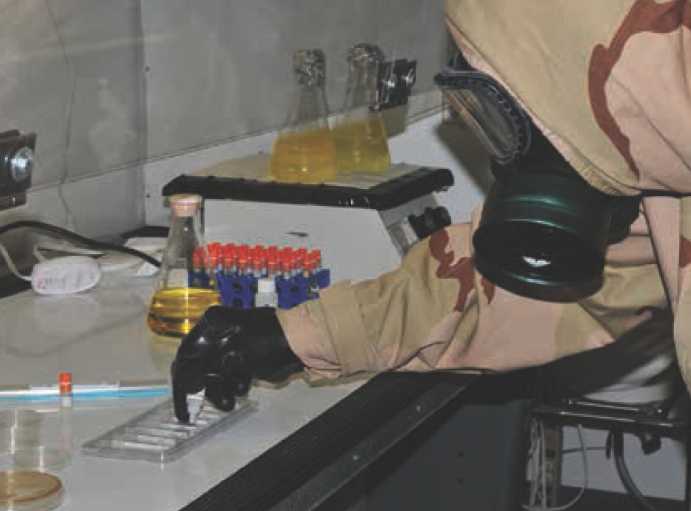
Next-Generation Diagnostics System (NGDS)
Description
The Next-Generation Diagnostics System family-of-systems will provide incremental chemical biological radiological and nuclear (CBRN) diagnostic capabilities across echelons of naval health care and provide common biological Identification materiel solutions across DoD. The NGDS Increment 1 (Inc. 1) Deployable Component is a U.S. Food and Drug Administration cleared reusable, portable biological pathogen diagnostic and identification system capable of rapidly analyzing clinical and environmental samples. NGDS diagnostic capabilities will be employed in Navy (Role 2 and 3) Fleet Deployable Combat Health Support units for the Identification and diagnosis of biological warfare agents and other pathogens of operational concern in support of individual patient treatment decision making, force health protection decision making, and CBRN situational awareness. NGDS Inc. 1 will be capable of connecting to CBRN defense, medical, and bio-surveillance network applications (e.g., Joint Warning and Reporting Network, and Composite Health Care System), if required. The NGDS Inc. 1 technology will be adapted for environmental sample analysis applications through collaboration with the Common Analytical Laboratory System (CALS) and the Joint Biological Tactical Detection System program offices. In collaboration with the CALS program for environmental capability requirements, NGDS Inc. 1 will replace the Joint Biological Agent Identification and Diagnostic System. NGDS Inc 2 will expand the program's CBRN assay capabilities and push some of the capabilities far-forward for enhanced diagnostics at the "point of injury/care" as part of the NGDS family-of-systems strategy.
Status
NGDS Inc. 1 is in its technology development phase with an initial operational capability (IOC) planned for FY 2018. NGDS Inc. 2 is scheduled to achieve IOC in FY 2021.
Developers
BioFire Diagnostics, Inc. (BFDx) Salt Lake City, Utah
* * * * * * * * * * * *

Total Ship Training Capability (TSTC)
Description
Total Ship Training Capability consists of the Advanced Training Domain, Battle Force Tactical Trainer, Aegis Combat Training System, Battle Force Electronic Warfare Trainer scenario generators, and numerous Aegis and Ship Self-Defense System (SSDS) interfaces and display systems. Together, the capability provides realistic combat systems tactical scenario training supporting both unit level and strike group integrated training and certification.
Status
Training systems are installed on 128 in-service systems on Aegis and SSDS warships. Established in 2012, the TSTC program of record was created to address reliability, simplicity, functionality, and fidelity shortfalls within these systems and the supporting ships' weapon systems. TSTC has demonstrated through pier-side integrated training events an achieved savings compared to at-sea live exercises. A continual TSTC investment is required to maintain constant alignment between tactical modernization, warfare training capabilities, and operator and crew weapon system proficiency.
Developers
Lockheed Martin Chesapeake, Virginia
Naval Surface Warfare Center Dam Neck, Virginia
NOVONICS Arlington, Virginia
SYS Technologies San Diego, California
* * * * * * * * * * * *
The Submarine Force supports all priorities identified in the Chief of Naval Operations' 2016 Navigation Plan: sustaining superior warfighting capability with ready and trained crews and superior submarines, weapons, and sensors. The start of the Ohio Replacement Program, coupled with the superior readiness of the 14 in-service Ohio-class nuclear-powered ballistic missile submarines, will ensure the Nation's sea-based strategic deterrent remains invulnerable and completely credible in the eyes of our allies and friends as well as potential adversaries and aggressors. At the same time, the highly successful Virginia-class fast-attack submarines generate a stealthy global presence and conduct warfighting operations in an increasingly "high end" competition at sea. In short, our submarine force continues to be the superior force that it has been since the dawn of the nuclear age.
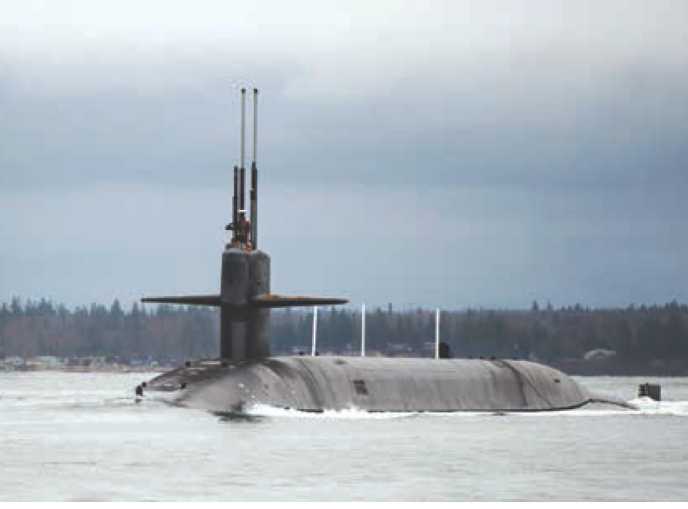
SUBMARINES AND UNDERSEA VEHICLES
SSBN 726 Ohio-Class Replacement (OR) Fleet Ballistic-Missile Submarine (SSBN)
Description
The Navy's nuclear-powered fleet ballistic-missile submarines support the Nation's strategic nuclear triad—long-range strategic bombers, land-based intercontinental ballistic missiles, and SSBNs armed with long-range submarine-launched ballistic missiles (SLBMs)—by providing a flexible and survivable deterrent with an assured-response capability. The sea-based strategic deterrent mission remains the Navy's top priority, and maintaining and modernizing the undersea "leg" of the strategic deterrent triad is the Navy's number-one acquisition priority. The 2017 force of 14 Ohio-class SSBNs begins to retire at a rate of one hull per year starting in 2027. Prudent engineering practices prevent further extending their operational lives without incurring unacceptable risk.
The Navy is focused on ensuring a seamless and successful transition to the Columbia-class OR SSBN to meet U.S. Strategic Command requirements in the 2030s and beyond. The 12 OR SSBNs will provide a survivable strategic deterrent capability well into the 2080s at a responsible cost. The Navy is designing the Columbia class to ensure survivability against threats into the late 21st Century. Concurrent with the U.S. OR program, the United Kingdom (U.K.) will recapitalize its sea-based strategic-deterrent platforms, the Vanguard-class SSBNs, which also employ the Trident II/D5 SLBM. The OR SSBN incorporates the Common Missile Compartment (CMC), which is under joint development with the United Kingdom to reduce design and construction costs, thus continuing the long-standing SSBN partnership between the U.S. and Royal navies. Additional ownership and production cost-reduction initiatives include a life-of-ship reactor core, modular construction techniques, and the re-use of selected Virginia (SSN 774)- and Ohio-class submarine systems.
Status
The OR program achieved Milestone A in 2011 and in 2017 is in the technology development phase. The Joint Requirements Oversight Council validated the OR SSBN Capability Development Document in August 2015, which documents the platform's requirements and guides the technology development effort. The Navy Gate 4 Review in November 2015 locked the technical baseline of the OR design, allowing for proper design maturity prior to construction start in FY 2021. Early research and design efforts include prototyping and demonstrating construction techniques for the first new-design SLBM tubes since the delivery of the USS Louisiana (SSBN 743) in 1997. Specifications for the U.S. and U.K. CMC quad pack were approved in August 2012, and quad pack construction commenced in August 2016. U.S. and U.K. CMC design and construction efforts remain synchronized. The OR lead ship is on track for a FY 2021 construction start to support its first strategic deterrent patrol in October 2030.
Developers
General Dynamics Electric
Boat Corporation Groton, Connecticut
Huntington Ingalls Industries-Newport News Newport News, Virginia
* * * * * * * * * * * *
SSN 774 Virginia-Class Nuclear-Powered Attack Submarine (SSN)
Description
The Virginia-class submarine is specifically built for multi-mission operations in the littoral while retaining the Submarine Force's strength in traditional open-ocean anti-submarine and anti-surface missions. These submarines have advanced acoustic stealth technology that allows unimpeded operation within an adversary's defensive perimeter, defeating his warfighting strategies and operations. Using these asymmetric advantages, Virginia-class submarines are configured to conduct sea control, land attack, mine reconnaissance, Special Operations Forces (SOF) insertion/extraction, intelligence collection, and surveillance missions that enable successful access and follow-on operations by larger general-purpose forces. The Virginia class can serve as host for various SOF delivery methods, including mini-submersibles and raiding craft via an embarked dry-deck shelter, or directly to sea via integral lockout chambers.
Virginia-class submarines are built under an innovative teaming arrangement between General Dynamics Electric Boat and Huntington Ingalls Industries-Newport News using a modular construction process in which each shipyard builds portions of each ship, with integration and delivery of completed submarines alternating between the shipyards. Modular construction also allows for assembly and testing of systems prior to installation in the hull, thereby reducing costs, minimizing rework, and simplifying system integration. The modular design and extensive use of open-architecture electronics systems facilitate technology insertion in future submarines during new construction and those already in the Fleet, enabling each Virginia-class submarine to keep pace with emerging threat capabilities throughout its 33-year service life.
Status
In 2008, the Navy negotiated a multi-year procurement contract for a total of eight submarines between 2009 and 2013. In 2010, the Virginia-class program completed Milestone C review, receiving full-rate production authority and achieving full operational capability. In 2011, the Navy increased the procurement rate to two submarines per year, the first time the Navy has procured two submarines in the same year since 1991. The USS Mississippi (SSN 782), the ninth Virginia-class submarine, delivered one year early in May 2012, and the USS Minnesota (SSN 783), the tenth ship of the class, also delivered ahead of schedule in June 2013, continuing the positive trend of constructing submarines ahead of schedule and within budget. SSN 784 through SSN 791 comprise the third block of Virginia-class submarines that began construction in 2009. Virginia Block III captures learning-curve efficiency initiatives that will help lower production costs even more. The first Block III ship, the USS North Dakota (SSN 784), delivered early on August 29, 2014. On April 28, 2014, the Navy awarded the contract for ten Virginia Block IV submarines (SSN 792 through SSN 801) that will include improvements to reduce total ownership costs. The Navy also received funds from Office of the Secretary of Defense for research, development, and design efforts for Virginia Block V, which will incorporate the Virginia Payload Module (VPM). VPM will increase Tactical Tomahawk land-attack cruise missile strike capacity and provide improved capability to support follow-on payloads. The Virginia-class submarine inventory objective is 48 SSNs.

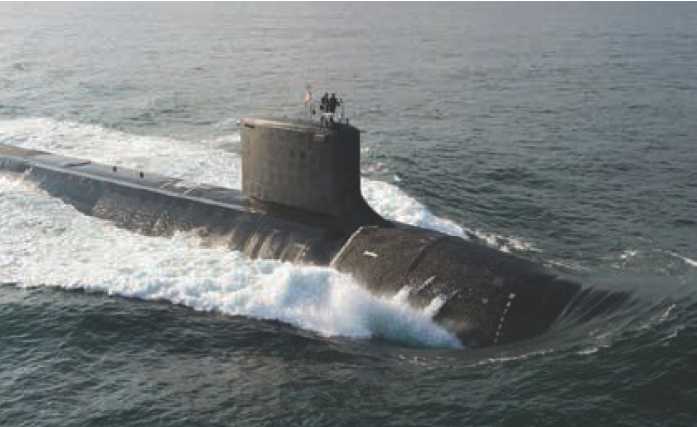
Developers
General Dynamics Electric
Boat Corporation Groton, Connecticut
Huntington Ingalls Industries-
Newport News Newport News, Virginia
* * * * * * * * * * * *

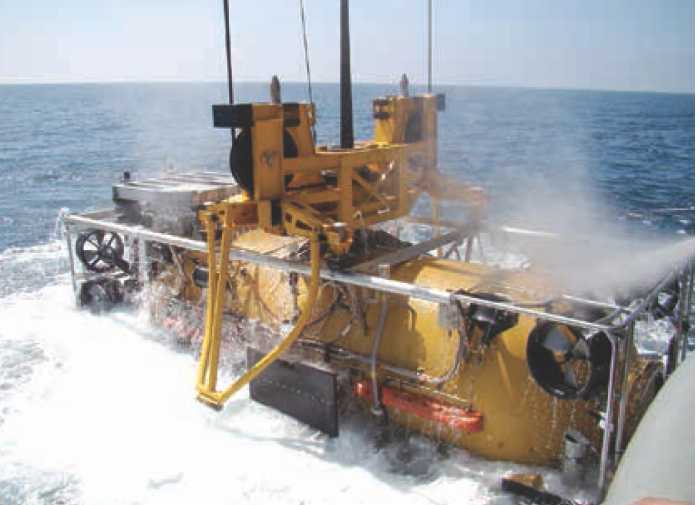
Submarine Rescue Systems
Description
The Navy's submarine rescue capability is provided by two systems: the venerable Submarine Rescue Chambers Fly-away System (SRCFS) and the more capable Submarine Rescue Diving and Recompression System (SRDRS). Both are ground-, sea-, and air-transportable for rapid worldwide deployment on vessels of opportunity in the event of a submarine accident. The SRCFS provides non-pressurized shallow-water rescue to a depth of 850 feet. The SRDRS comprises three distinct systems: (1) Assessment Underwater Work System (AUWS); (2) Pressurized Rescue Module System (PRMS); and (3) Surface Decompression System (SDS). AUWS includes the Atmospheric Diving System (ADS2000), a one-atmosphere, no-decompression manned diving system capable of depths to 2,000 feet, and a remotely operated vehicle (ROV) for clearing and preparing a submarine hatch for seating a rescue platform. The PRMS is a manned, tethered, and remotely piloted vehicle capable of rescuing personnel from a stricken submarine to depths of 2,000 feet. The SRDRS will enable transfer under pressure (TUP) for surface decompression of personnel rescued from a pressurized submarine environment. The SRDRS is a government-owned, contractor-operated system maintained at the Navy's Undersea Rescue Command (URC).
Status
The manned AUWS was introduced to the Fleet in 2007, and URC continues to maintain four ADS2000 suites in support of submarine rescue system requirements. The Navy has approved replacement of ADS2000 with ROVs beginning in FY 2016. The PRMS element of the SRDRS became operational in 2008, replacing the Navy's aging and cost-prohibitive Deep Submergence Rescue Vehicle capability. The PRMS underwent repair from a February 2013 accident until July 2015. The program was then re-baselined in November 2015. The complete SRDRS, including the TUP capability, is expected to reach initial operational capability in FY 2018 and is scheduled for delivery to the Fleet and full operational capability in FY 2019. Meanwhile, the Navy has programmed the legacy SRCFS for continued service.
Developers
Environmental Tectonics
Corporation Southampton, Pennsylvania
Oceaneering International Upper Marlboro, Maryland
OceanWorks International Vancouver, California
Southwest Research Institute San Antonio, Texas
* * * * * * * * * * * *

SUBMARINE WEAPONS
Mk 48 Advanced Capability (ADCAP) Common Broadband Advanced Sonar System (CBASS) Torpedo
Description
The Mk 48 Advanced Capability heavyweight torpedo is the Navy's sole submarine-launched weapon for anti-submarine and anti-surface warfare. The ADCAP torpedo program was authorized for full-rate production of the Mk 48 Mod 5 ADCAP in 1990,
and the final production all-up-round torpedo was delivered to the Navy in 1996. Since then, the Navy has employed an open-architecture model to provide hardware and software improvements to the ADCAP torpedo inventory, converting the Mod 5 to Mod 6 and Mod 7. The ADCAP torpedo features sophisticated sonar, all-digital guidance and control systems, digital fuzing systems, and improved torpedo acoustic stealth compared to the legacy Mk 48 Mod 4 torpedo. The Mod 7 CBASS torpedo with Advanced Processor Build (APB) Spiral 4 software is the latest and most capable configuration of the Mk 48 torpedo. Phase I of the CBASS program introduced the new broadband sonar analog receiver to the Fleet in 2006, and beginning in May 2013 Phase II provided APB Spiral 4 software improvements and common sonar upgrades leveraged from the Mk 54 Lightweight Torpedo program. The CBASS upgrade to the ADCAP torpedo is part of an ongoing Armaments Cooperative Program with the Royal Australian Navy (RAN). In addition to the RAN, the Brazilian, Canadian, and Netherlands navies also acquired versions of the Mk 48 torpedo through the Navy's Foreign Military Sales program.
Status
In FY 2016, the Navy restarted production of the Mk 48 Mod 7 CBASS torpedo to address a warshot inventory shortfall as a result of a FY 2012 warfighting inventory requirement increase. Separately, the Navy continues to procure Mod 7 CBASS upgrade kits for eventual conversion of all Mod 6 torpedoes. In parallel, the APB program continues to improve torpedo performance through software upgrades and hardware technology insertions (TIs) in challenging areas, such as the shallow-water diesel submarine threat. A 2012 approved Capabilities Development Document established requirements for follow-on APB 5 and APB 6/ TI-1 software and hardware upgrades for which APB 5 software is in developmental testing in 2017 and will enter operational testing in FY 2018, with an expected initial operating capability (IOC) in FY 2020. APB 6/TI-1 development began in FY 2016 with a projected IOC of FY 2024. Both APB 5 and APB 6/TI-1 upgrades will receive and field valuable capability improvements developed jointly with the Office of Naval Research.
Developers
Lockheed Martin Sippican Marion, Massachusetts
* * * * * * * * * * * *
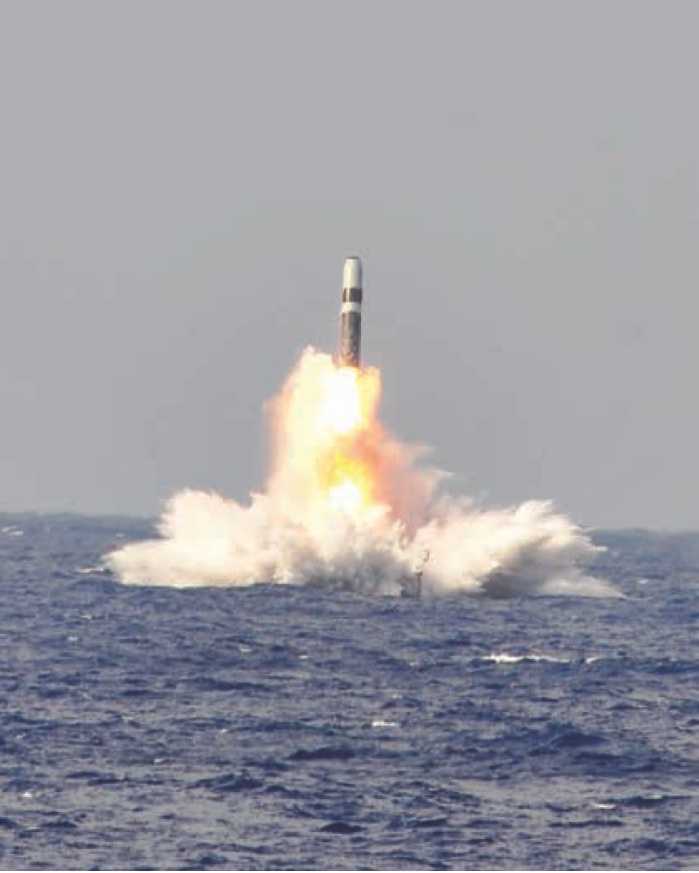
UGM-133A Trident II/D5 Submarine-Launched Ballistic Missile (SLBM)
Description
The Trident II/D5 is the sixth generation of the Navy's Fleet Ballistic Missile program, which started in 1955. The D5 is a three-stage, solid-propellant, inertial-guided submarine-launched ballistic missile with a range greater than 4,000 nautical miles and accuracy measured in hundreds of feet. Trident II/D5 missiles are carried by all 14 Ohio-class fleet ballistic-missile submarines, nuclear (SSBNs). Under the New Strategic Arms Reduction Treaty (New START) requirements, each SSBN is capable of carrying 20 SLBMs. The Navy continues to address future deterrence requirements, and the Trident II/D5 will ensure that the United States has a modern, survivable strategic deterrent. In that regard, the Navy has embarked on a Trident II/D5 Life Extension (D5LE) Program that upgrades missile systems and maintains Trident II/D5s in the Fleet into the 2040s, bridging the transition from Ohio-class SSBNs to Ohio Replacement (OR) SSBNs. The Trident II/D5LE SLBM will be the initial OR payload.
Status
Full missile procurement ended in FY 2012, with a total acquisition of 108 additional missiles. Life extension kits and replacement solid-propellant rocket motors are procured throughout and beyond the FY 2017 future years defense program to refurbish obsolete electronics and expiring rocket motors.
Developers
Lockheed Martin Sunnyvale, California
* * * * * * * * * * * *
SUBMARINE SENSORS AND SYSTEMS
BQQ-10 Submarine Acoustic Systems
Description
Submarine acoustic systems modernization enables rapid warfighting capability enhancements at reduced costs and for affordable sustainment. Acoustic Rapid Commercial Off-the Shelf (COTS) Insertion (ARCI) upgrades legacy sonar systems and significantly expands processing capability for existing sensors and enables future sensors through upgrades/modernizations. During the last 19 years, there have been four phases of A-RCI implementation spanning more than 180 modernizations. Phase I initially upgraded processing for towed arrays and the conformal hull array and Phase IV systems processed all acoustic sensors, including relatively new sensors such as the TB-34 towed array and the BQS-25 Flow Cost Conformal Array being installed on the Improved Los Angeles (SSN 688I)-class submarines. Additionally, the open architecture design of the ARCI system allows for the rapid insertion at minimal cost of new processing techniques and sensor systems such as the hull mounted Large Vertical Array.
Status
BQQ-10 ARCI is common across all submarine classes: Los Angeles/ Improved Los Angeles (SSN 688/688I), Seawolf (SSN 21), and Virginia (SSN 774) attack submarines, and Ohio-class guided-missile and fleet ballistic-missile submarines (SSGN/SSBN). Submarines receive periodic improvements through hardware technology insertions (TIs) and software advanced processor builds (APBs). While TI upgrades are designed and produced biennially, individual submarines nominally receive a TI every-other cycle. This nominal four to six-year refresh of hardware keeps each submarine's processing power on pace with the commercial computing industry while, in turn, ensuring that the COTS components are upgraded before obsolescence. Biennial APBs permit rapid insertion of improved processing algorithms and increased capabilities requested by Navy type commanders to address emerging challenges. Navy research, development, testing, and evaluation will continue to develop processing algorithms from the surveillance, tactical, and advanced R&D communities, as well as to perform laboratory and at-sea testing.
Developers
Applied Research Lab,
University of Texas at Austin Austin, Texas
General Dynamics Advanced
Information Systems Fairfax, Virginia
Lockheed Martin Manassas, Virginia
Progeny Systems Corporation Manassas, Virginia
* * * * * * * * * * * *
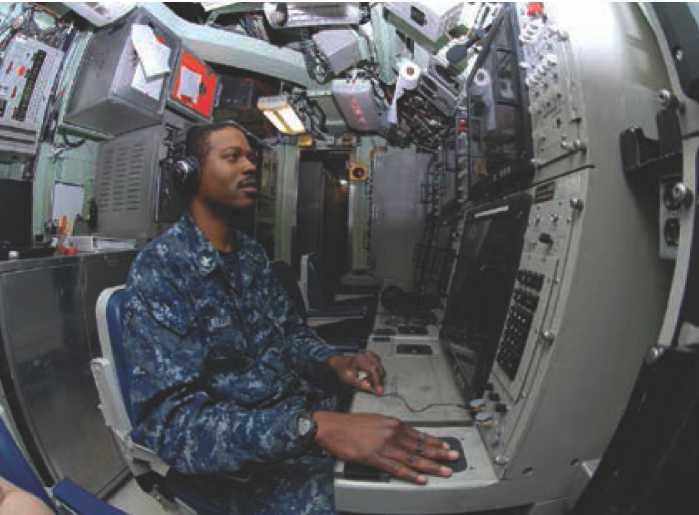
BYG-1 Submarine Combat Control System
Description
BYG-1 is a Commercial Off-the-Shelf (COTS), Open-Systems Architecture (OSA) system that incorporates organic sensor fusion, target solution development, common tactical picture, weapon control, and tactical local-area network functions. The use of COTS/OSA technologies and systems enables frequent updates to both software and hardware with little or no impact on submarine scheduling. COTS-based processors allow computer power growth at a rate commensurate with that of commercial industry. Additionally, the open-architecture design of the BYG-1 system allows for the rapid integration of new sensors and processing techniques at minimal cost. BYG-1 allows the submarine force to update the ship safety tactical picture rapidly, improves torpedo interfaces, and provides Tactical Tomahawk Land-Attack cruise missile capability.
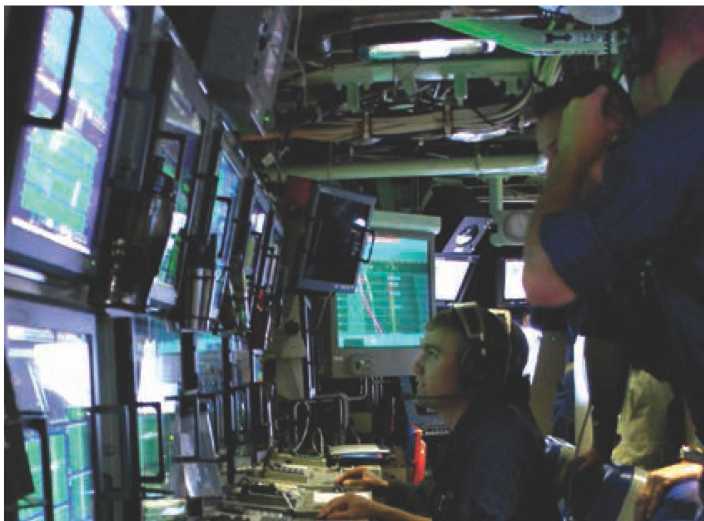
Status
BYG-1 has been installed on all U.S. attack and guided-missile submarines and is scheduled to be installed on the Ohio-class fleet ballistic-missile submarines, with the first installation occurring in FY 2017. Submarines receive periodic improvements through hardware technology insertions (TIs) and software advanced processor builds (APBs). While TI upgrades are designed and produced biennially, individual submarines nominally receive a TI every other cycle. This nominal four-to-six year refresh of hardware keeps each submarine's processing power on pace with the commercial computing industry while, in turn, ensuring that the COTS components are upgraded before obsolescence. Biennial APBs permit rapid insertion of improved processing algorithms and increased capabilities requested by Navy type commanders to address emerging challenges. Navy research, development, testing, and evaluation will continue to develop processing algorithms from the surveillance, tactical, and advanced R&D communities, as well as to perform laboratory and at-sea testing.
Developers
General Dynamics Advanced Information Systems Fair Lakes, Virginia
Pittsfield, Massachusetts
Lockheed Martin Eagan, Minnesota
Progeny Manassas, Virginia
* * * * * * * * * * * *

SUBMARINE EQUIPMENT AND SYSTEMS
Submarine Survivability
Description
Today's submariners use passive means to remove carbon dioxide from a disabled submarine's atmosphere, enabling survival up to seven days. Oxygen-generating chlorate candles and atmosphere-monitoring equipment are also used for submarine survivability. Survival improvements include introduction of new "flat-sheet" lithium hydroxide (LiOH) canisters for high-performance passive scrubbing.
Status
Passive carbon dioxide scrubbing curtains, granular lithium hydroxide, oxygen-generating chlorate candles and atmosphere monitoring equipment are installed on all submarines. Phased outfitting of flat-sheet LiOH canisters on all in-service Virginia (SSN 774)-class submarines is complete.
Developers
Analox Sensor Technology, Ltd. Stokesley, United Kingdom
Casco Manufacturing Solutions, Inc. Cincinnati, Ohio
Micropore, Inc. Newark, Delaware
Tangram Company, LLC Holtsville, New York
* * * * * * * * * * * *
Naval expeditionary warfare forces embody the flexibility, agility, and readiness that we need for today's and tomorrow's operations. Expeditionary forces can project power deep inland to disrupt the enemy, destroy enemy forces, and seize terrain in support of a joint campaign. The capability to operate from the sea base is a "crown jewel" of our forward presence, sea control, and power-projection posture. Marines embarked in amphibious warships, enabled by mine warfare forces, Seabees, and SEALs, enable us to go there, stay there, and fight and win there.

EXPEDITIONARY FORCES
Coastal Riverine Force
Description
In 2012, the Navy Expeditionary Combat Command (NECC) merged the Riverine Force and the Maritime Expeditionary Security Force (MESF) to form the Coastal Riverine Force (CRF). The CRF comprises the Coastal Riverine Group (CRG) 1 and CRG 2. The CRG forces are organized into three active squadrons with three companies each, and four reserve squadrons with four companies each. The primary unit of action for the CRF is the squadron, but the force maintains the capability to disaggregate into companies. The CRF operates in harbors, rivers, bays, across the littoral, and ashore. The CRF mission sets bridge the maritime gap between land forces and the Navy's blue-water forces. The primary mission of the CRF is to conduct maritime security operations across all phases of military operations, around the clock and in all weather conditions and climates. CRF units are manned, trained, and equipped to defend high-value assets, critical maritime infrastructure, ports and harbors inland and on coastal waterways. They can also conduct offensive combat operations—surveillance and reconnaissance, insertion and extraction of small units, and command and control for supporting units. The CRF delivers task-organized units that are effective, flexible, and responsive to fleet and combatant commander littoral demands and seamlessly operate with other Navy, joint, interagency, and coalition partners.
Status
In 2015, the Navy Capabilities Board approved a CRF capabilities-based assessment to inform the update of the Maritime Expeditionary Force Initial Capability Document; this reflected the FY 2013 merger of the Maritime Expeditionary Security Force and Riverine Squadrons. The assessment informed an analysis of alternatives regarding CRF mission sets and the equipment needed to support them. The Navy has procured 12 Mk VI patrol boats; six are deployed, and the twelfth is scheduled for fleet delivery in the third quarter FY 2018. In late 2016, the Navy resource sponsor (OPNAV N957) is working with the NECC on a phased patrol boat recapitalization effort to replace the aging 34-foot patrol boat with a new Patrol Boat-X.
Developers
Multiple sources.
* * * * * * * * * * * *
Explosive Ordnance Disposal (EOD) / Mobile Diving and Salvage (MDS) Description
The Explosive Ordnance Disposal community is organized into two deploying EOD groups, each headed by a Navy captain (O-6). Each group comprises multiple EOD mobile units, a mobile diving and salvage unit (MDSU), training and evaluation unit, and an expeditionary support unit.
EOD units provide the Fleet, joint services, and the interagency community with the capability to detect, identify, render safe, recover, exploit, and dispose of ordnance that has been fired, dropped, launched, projected, or placed in such a manner as to constitute a hazard to operations, installations, people, or materiel. Commonly operating in platoons and smaller elements, EOD units assure access to battlespace by opening lines of communication in the sea-to-shore interface as well as blue-water and land-based operations. This can require diving operations, parachute insertion, or helicopter insertion and extraction. These mobility skills, along with responsibility for all underwater ordnance, make Navy EOD unique in the joint force. The Secretary of the Navy is the Single Manager for EOD Technology and Training, carrying out these duties primarily through the Navy EOD Technology Center and the Naval School Explosive Ordnance Disposal, where all U.S. and select foreign-partner military EOD technicians receive the same initial training to defeat conventional ordnance as well as improvised explosive devices. Navy EOD also has capabilities to render safe chemical, biological, radiological, nuclear, and enhanced-explosive weapons, including terrorist "dirty" bombs.
MDSUs conduct planning, coordinating, and directing combat harbor-clearance, anti-terrorism and force-protection diving missions, salvage and recovery operations, and other assigned tasks. MDSUs operate in direct support of naval, joint, and combined task forces, conducting operations afloat or ashore during combat or national emergencies worldwide, including climate extremes—Arctic, tropical, or desert environments. In addition to expeditionary salvage, search, and recovery operations, they perform harbor clearance to remove obstructions restricting access to ports, piers, and waterways; assist vessels in distress; de-beaching and salvaging of ships, submarines and aircraft; locate and recover other high-value objects; underwater cutting and welding; limited underwater ship repair; ship husbandry; and ATFP dive support for ships in port and port facilities.
Status
In late 2016, the EOD and MDS communities recapitalized their authorized equipment inventories with new tables of allowance (ToA). Based on a complete review of their mission requirements, each ToA aligned with force structures and standardized equipment across the Navy Expeditionary Combat Enterprise. Specialty equipment—e.g. man-transportable robotic systems, unmanned underwater vehicles, and Mk-16 underwater breathing apparatus/ multi-mission underwater breathing apparatus—were included for EOD units.
Developers
Multiple sources
* * * * * * * * * * * *
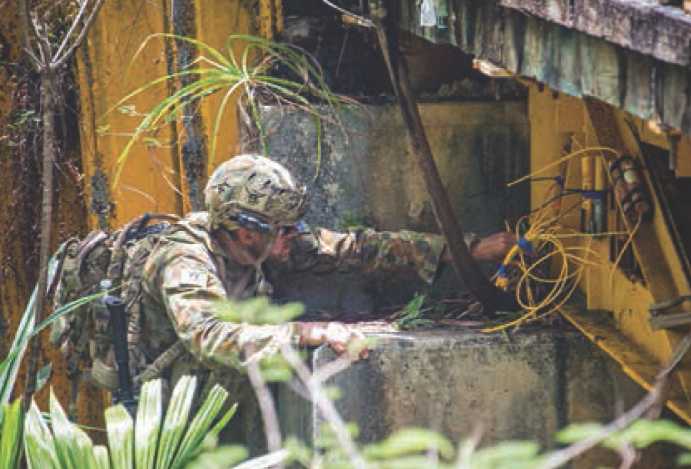
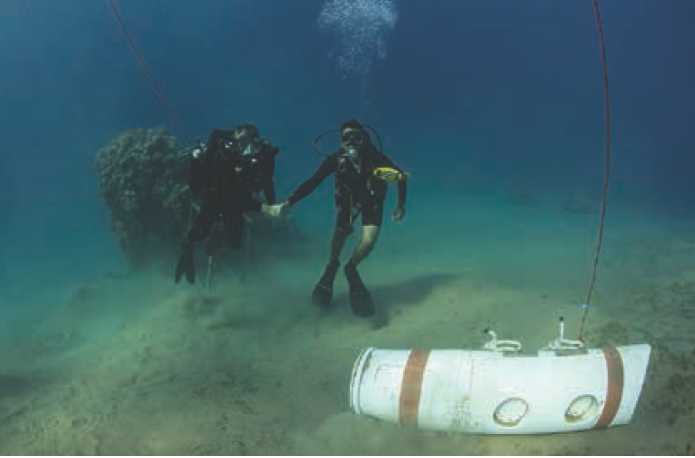
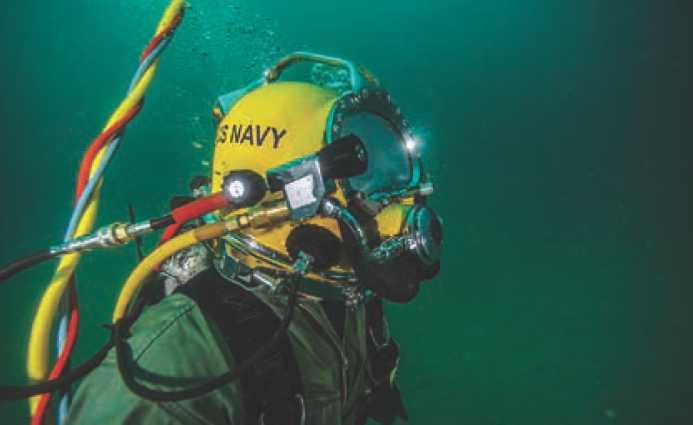
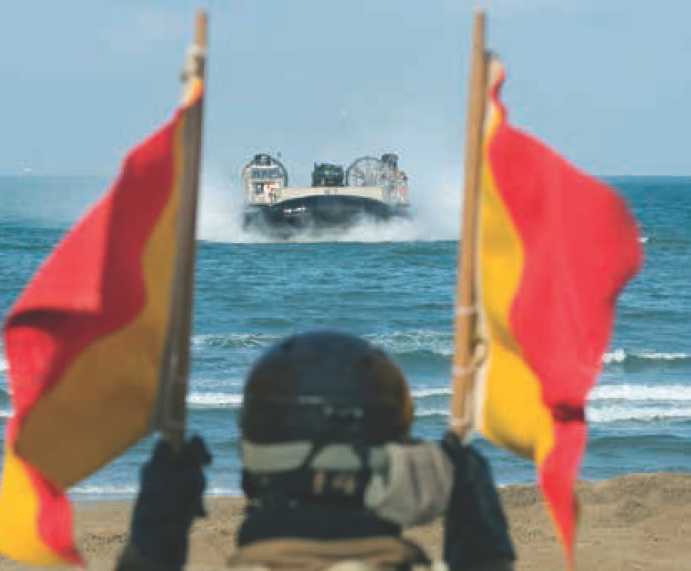
Naval Beach Group
Description
The Two Naval Beach Group Commanders—Naval Beach Group One (NBG 1) and Naval Beach Group Two (NBG 2)—serve as the immediate higher command for all amphibious enabling forces: assault craft units (ACUs) for displacement landing craft and non-displacement assault craft; beach master units (BMUs); and amphibious construction battalions (ACBs). Components of each of these commands can be embarked in amphibious ships in support of landing-force operations or can be deployed on strategic airlift and sealift platforms to support other operations. Naval Beach Groups also provide advocacy for amphibious assault, ship-to-shore movement, and logistics-over-the-shore units, and provide required unit level training and readiness assessments for all amphibious ships. Naval Beach Group 1 is also responsible for this function for all forward-deployed amphibious forces in Sasebo, Japan. The NBG missions, in single or multiple geographic locations, include wartime forward littoral operations supporting Marine Corps amphibious assault and follow-on USMC and joint combat missions, as well as peacetime forward littoral and humanitarian assistance. Each Naval Beach Group Commander can rapidly deploy worldwide to serve as Navy logistics-over-the-shore commander supporting the offload of Navy/ Military Sealift Command maritime prepositioned squadron ships and the offload-in-stream offloading of maritime shipping.
Status
NBG 1 is located in Coronado, California, and has oversight of ACU 1, ACU 5, BMU 1, and ACB 1. NBG 1 also supports NBU 7 in Sasebo, Japan. NBG 2 is located in Little Creek, Virginia, and has oversight of ACU 2, ACU 4, BMU 2, and ACB 2.
Developers
Multiple sources.
* * * * * * * * * * * *
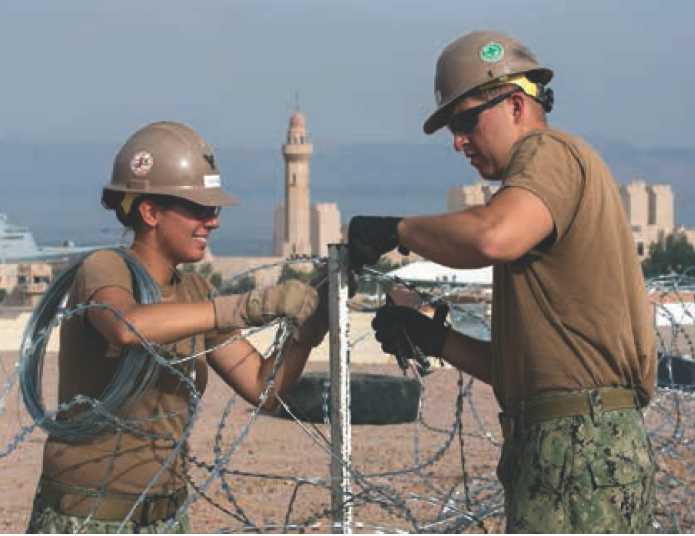
Naval Mobile Construction Battalion (NMCB) "Seabees"
Description
Naval Construction Forces—"Seabees"—are the Navy's deploy-able engineer and construction force providing support to Marine Air-Ground Task Force (MAGTF), Navy commanders, and other joint forces, and combatant commanders. The force comprises naval construction groups, naval construction regiments, naval mobile construction battalions, construction battalion maintenance units, and underwater construction teams. In support of sea-strike and sea-basing missions, the Navy/Marine Corps Team projects power from the sea with a rapid flow of maneuver forces ashore, using roads, expeditionary airfields, force-protection structures, intermediate-staging bases, and advanced logistics bases. Forward-deployed Seabees enable the surge of task-tailored engineer forces and equipment sets to enhance the MAGTF and other naval and joint forces on land. Seabee capabilities include bridge erection, roadway clearing and construction, pier and wharf repair, forward operating base construction, airfield repair and construction, water well installation, and such civilian construction as schools and medical clinics. In operations other than war, forward-deployed naval mobile combat battalions (NMCB) hone construction skills through humanitarian-assistance and disaster-recovery operations, participate in foreign engagement exercises, and complete construction projects that support sustainment, restoration, and modernization of Navy and Marine Corps forward bases and facilities.
Status
The Navy has developed a long-range plan to recapitalize the tables of allowance of all Seabee units. The initial priority is to correct existing inventory deficiencies and replace aging tools and equipment that are no longer parts-supportable. During the next several years, NMCB tables of allowance will be outfitted with modern and recapitalized tactical vehicles, construction and maintenance equipment, communications gear, infantry items, and field-support equipment.
Developers
Multiple sources.
* * * * * * * * * * * *

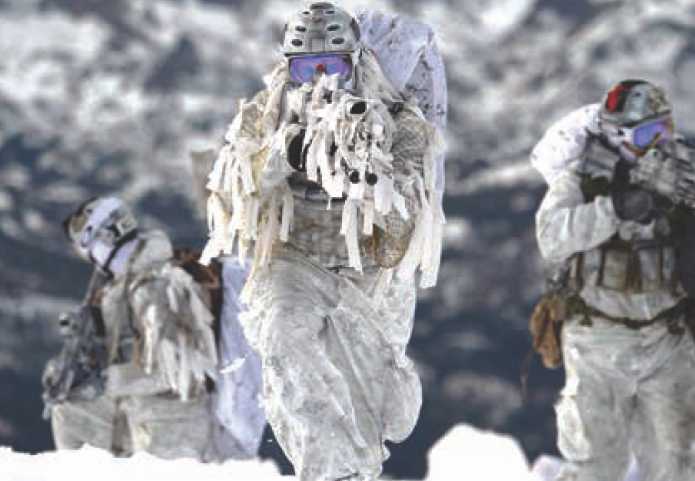
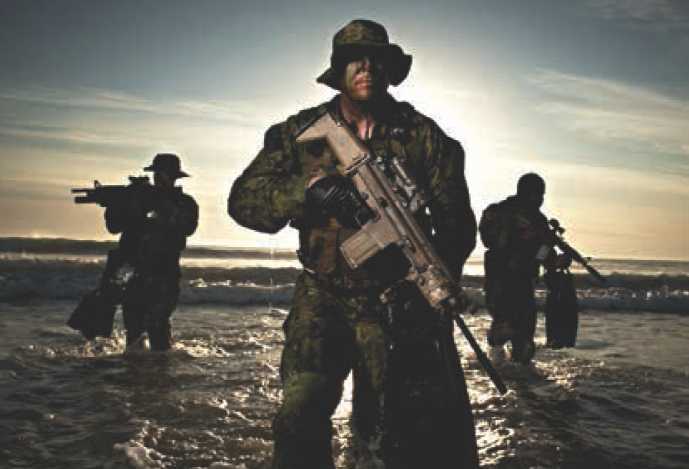
Naval Special Warfare (NSW) "SEALs"
Description
The Naval Special Warfare community—Navy Sea, Air, Land ("SEALs") forces—is the maritime component of the U.S. Special Operations Command and the U.S. Navy Special Operations Component. The Commander, Naval Special Warfare Command is responsible for strategic vision, doctrinal, operational, and tactical guidance, as well as training, organizing, and equipping operational-support components. NSW forces provide a highly effective option across the spectrum of hostilities, from peacetime to global combat operations. Principal NSW operations include counter-terrorism, counter-proliferation, unconventional warfare, direct action, special reconnaissance, military information support operations, and security force assistance and civil affairs. NSW forces also conduct collateral missions, such as counter-drug activities, humanitarian assistance, and personnel recovery.
The NSW community is organized under several major commands, which include five operational commands, one training command, one tactics and technology development command, and one reserve component command. The major NSW operational components are: Naval Special Warfare Groups (NSWGs) One and Eleven in San Diego, California; NSWG Three in Pearl Harbor, Hawaii; and NSWGs Two, Four, and Ten in Little Creek, Virginia. The NSWG mission is to man, train, equip, support, and provide command and control elements as well as trained and ready SEAL platoons/troops, SEAL delivery vehicle platoons, special boat team combatant craft detachments, and other forces to the geographical combatant commanders. Two of the NSWGs also provide administrative control to five NSW units that are home-ported forward, and are under operational control of a theater special operations command. The primary deployable operational component of the community is the NSW task group (NSWTG).
A NSWTG is task-organized and unit-centered on a SEAL team and led by a SEAL team commanding officer. NSWTGs comprise three NSW task units, which are further broken into two-to-three SEAL platoons, or NSW task elements when supplemented with combat support or combat service support enablers. When a NSWTG is provisionally established, the deploying SEAL team will normally be augmented by combatant craft, combat support and combat service support enablers, and special detachments to execute assigned missions.
Status
Resources to support the NSW community are principally provided by U.S. Special Operations Command, but the Navy retains resourcing of responsibilities for service common capabilities.
Developers
Multiple sources.
* * * * * * * * * * * *
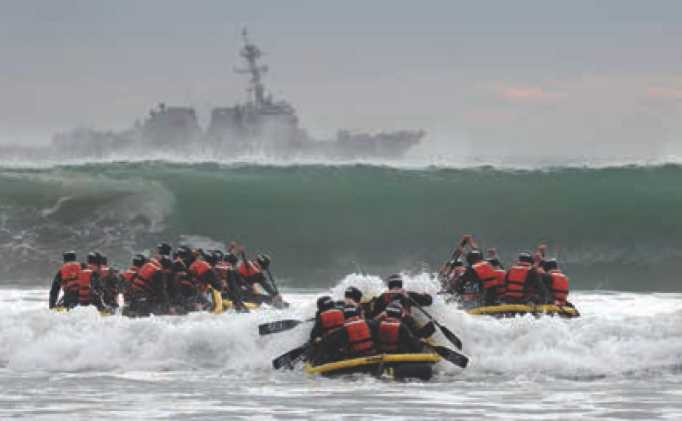
Navy Expeditionary Intelligence Command (NEIC)
Description
Navy Expeditionary Combat Command (NECC) established the Navy Expeditionary Intelligence Command to provide tactical indications and warning, force protection intelligence, sensitive site exploitation, and intelligence preparation of the operational environment, enabling Navy and joint commanders to conduct missions across the full spectrum of expeditionary operations and win decisively in major combat operations. NEIC activities are framed around its overall function to man, train, and equip intelligence exploitation teams (IETs) in support of naval combatant command and joint forces command operational requirements. NEIC components include a command element, command support staff, active component operational units, and reserve units. IETs are multi-intelligence, surveillance, and reconnaissance (ISR)-collection platforms that operate at the tactical level, with unique access to areas and environments— from "blue" to "green'" water, the coastal littoral, and far inland— that constrain more traditional ISR assets. NEIC capabilities give expeditionary, maritime, joint, and combined forces timely, relevant, and actionable intelligence to deny the enemy sanctuary, freedom of movement, and use of waterborne lines of communication while enabling friendly forces to find, fix, and destroy the enemy.
Status
The Commander, NECC approved NEIC's reorganization into integrated teams and, approved NEIC's updated table of allowance. NEIC continues to support the expeditionary and intelligence communities.
Status
Multiple sources.
* * * * * * * * * * * *
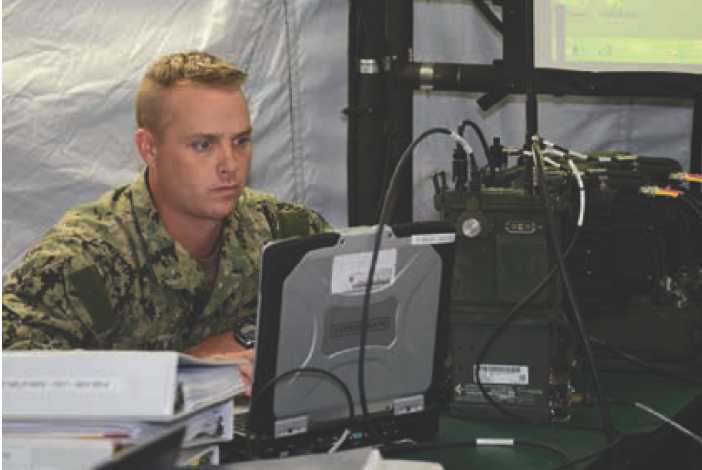
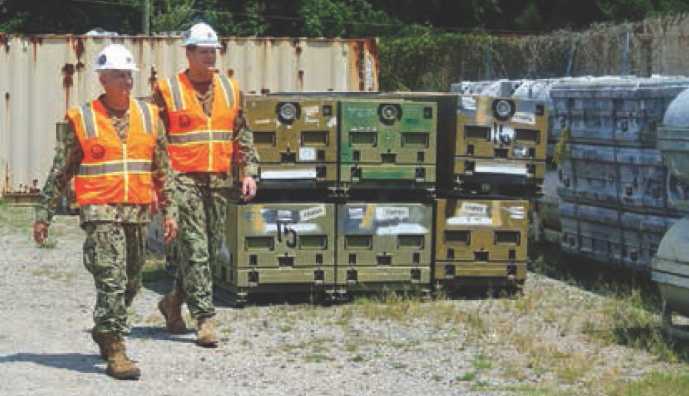
Navy Expeditionary Logistics Support Group (NAVELSG)
Description
The Navy Expeditionary Logistics Support Group comprises Navy expeditionary logistics regiments (NELRs), Navy cargo handling battalions (NCHBs), a training and evaluation unit, and expeditionary support units. NAVELSG is responsible for providing expeditionary logistics capabilities for the Navy, primarily within the littoral maritime domain. The NELRs and NCHBs are capable of rapid, worldwide deployment and are trained and equipped to provide shore-based logistical support to Navy, Marine Corps, and joint force commanders for peacetime support, humanitarian and crisis response, and combat-service support missions. NCHBs can assume control of pier and terminal operations, surface and air cargo handling, and ordnance handling and management. Specialized capabilities include expeditionary fuel operations, pier and air terminal operations, weapons handling, cargo processing (including bulk mail), heavy-lift crane operations, customs inspections, expeditionary communications, short-haul trucking, and expeditionary warehousing.
Status
The ELSG table of allowance (ToA) was approved March 2010. The Navy has developed a long-range plan to recapitalize the ToAs of all expeditionary logistics units. The initial priority is to correct existing inventory deficiencies and replace aging tools and equipment that are no longer parts supportable.
Developers
Multiple sources.
* * * * * * * * * * * *
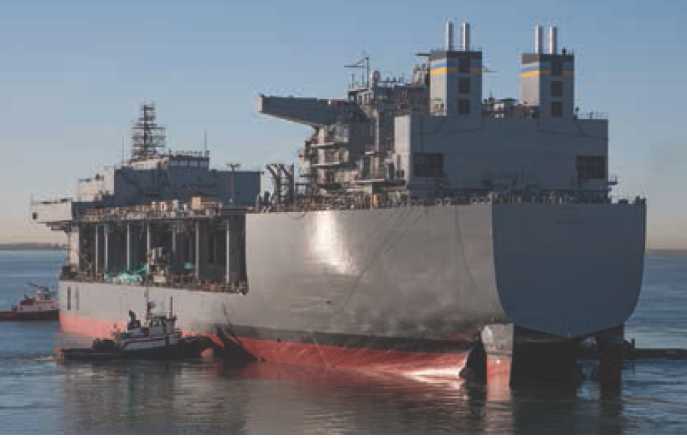
EXPEDITIONARY AND SPECIAL MISSION SHIPS AND CRAFT
Expeditionary Sea Base (ESB)
Description
The Expeditionary Sea Base (ESB) is a variant of the Expeditionary Transfer Dock (ESD) Program (formerly known as the Mobile Landing Platform Program), using the same hull and commercial technology. The ESB will fulfill critical strategic needs to support airborne mine countermeasures (AMCM) and support to Special Operations Forces (SOF) by enabling global access, reach, and persistence. The ESB (formally known as the Afloat Forward Staging Base, AFSB) adds new capability to include a forward deck house with berthing for 250 personnel; command spaces to support command and control, operations and logistics functions; a light deck with four operating spots for several types of aircraft including AH-6, CH-47, MH-53, MH-60, and MV-22; a hangar and ordnance magazines; underway replenishment capability; and deck space for AMCM and SOF boats, sleds, and equipment.
Status
The USNS Lewis B. Puller (ESB-3) was delivered to the Navy in June 2015 and will join the Fleet in 2017. The USNS Hershel Williams (ESB-4) will be delivered to the Navy in March 2018. The yet-unnamed ESB-5 was procured in FY 2016 and will start construction in June 2017. The ship is scheduled to deliver in summer 2019.
Developers
General Dynamics NASSCO San Diego, California
* * * * * * * * * * * *
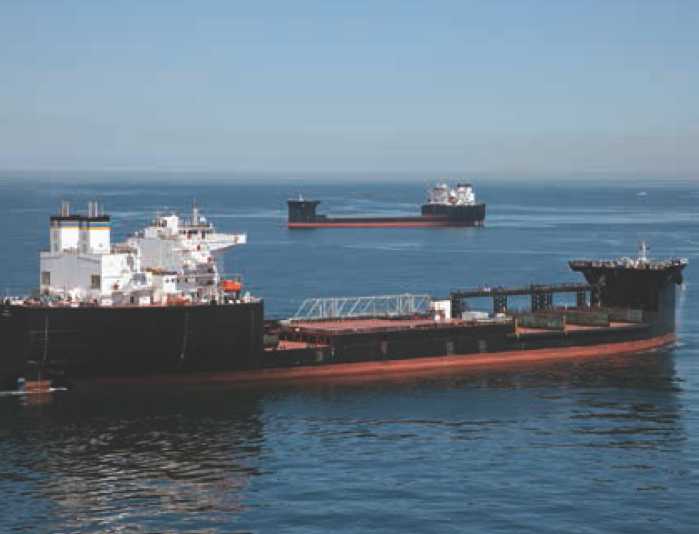
Expeditionary Transfer Dock (ESD)
Description
The Expeditionary Transfer Dock (ESD) program (formerly known as the Mobile Landing Platform, MLP) enhances the maritime prepositioning force throughput capability by providing a surface interface between large, medium speed roll-on/roll-off (LMSR) prepositioning ships and surface connectors including landing craft air cushion vehicle (LCAC), amphibious assault vehicle (AAV), and the future ship-to-shore connector (SSC). With further testing and development, the ESD could also provide surface interface with landing craft utility and the improved Navy lighterage system. The ESD is a highly flexible ship that provides logistics movement from sea to shore supporting a broad range of military operations. The vessel is the catalyst to integrating with amphibious assault assets, such as LCAC, and providing the capability to configure at sea. Although not a forcible-entry operation, the ability to move equipment and supplies rapidly through the T-ESD is a force enabler. The ESD's open, reconfigurable mission deck is outfitted with an elevated vehicle staging area and three LCAC lanes including barriers, lighting, washdown, and fueling services. Numerous skin-to-skin operations have been conducted with LMSR vessels, demonstrating the transfer of vehicles between the two vessels including loading the cargo in LCACs for transfer ashore. With a 9,500 nautical mile range at a sustained speed of 15 knots, these approximately 80,000-ton, 785-foot long ships leverage float-on/float-off technology and are capable of ballasting down. Additionally, the ships' size allows for 25,000 square feet of vehicle and equipment stowage space and 380,000 gallons of JP-5 fuel storage.
Status
The USNS Montford Point (ESD 1) and USNS John Glenn (ESD 2) were delivered to the Navy in May 2013 and March 2014, respectively. Military Sealift Command personnel operate these versatile ships.
Developers
General Dynamics NASSCO San Diego, California
* * * * * * * * * * * *
Landing Craft Air Cushion (LCAC) Description
This high-speed, fully amphibious landing craft is capable of carrying a 60-ton payload at speeds of 35 knots. Range is load- and sea state-dependent, but can approach 200 nautical miles. Its ability to ride on a cushion of air allows it to operate directly from the well decks of amphibious warships. Carrying equipment, troops, and supplies, the LCAC launches from the well deck, transits at high speed, traverses the surf zone, and lands at a suitable place ashore where it quickly offloads and returns to amphibious shipping for follow-on sorties. LCACs provide amphibious task force commanders flexibility in selecting landing sites, permitting access to more than 70 percent of the world's shores, as compared with 17 percent for conventional displacement landing craft. LCACs deliver vehicles and cargo directly onto dry land rather than to the surf zone, and have proved invaluable in support of humanitarian-assistance/disaster-relief missions, including Operation Tomodachi Tsunami Relief in Japan, Hurricane Katrina, and Operation Unified Response in Haiti. Some multi-mission LCACs have been outfitted with radar and radio system upgrades prior to entry into their service-life extension program (SLEP). A SLEP to extend service life from 20 to 30 years for 64 LCACs will be completed by FY 2018. As part of the LCAC SLEP, the Navy will incorporate the following enhancements: (1) hull (buoyancy box) upgrades, improvements, and improved corrosion control; (2) an open-architecture framework, relying on modern commercial off-the shelf equipment that will allow much easier incorporation of technology changes-such as precision navigation and communications systems; (3) engine upgrades (ETF-40B configuration) that will provide additional power and lift, particularly in hot (100° Fahrenheit and higher) environments and reduce fuel consumption and maintenance requirements; and (4) a new deep skirt to reduce drag, increase performance over water and land, and reduce maintenance requirements.
Status
LCAC initial operational capability was achieved in 1986. Contracts for 91 LCACs were approved in FY 1997, with all 91 craft delivered by the end of FY 2001. Disposal of 18 LCACs occurred in FY 2006 for cost reasons; two LCACs are dedicated research and development craft. The LCAC SLEP program began in 2000, and four SLEPs are planned each year through FY 2018.
Developers
Avondale Marine Gulfport, Mississippi
Gryphon Technologies LC Panama City, Florida
Textron Marine & Land Systems New Orleans, Louisiana
* * * * * * * * * * * *
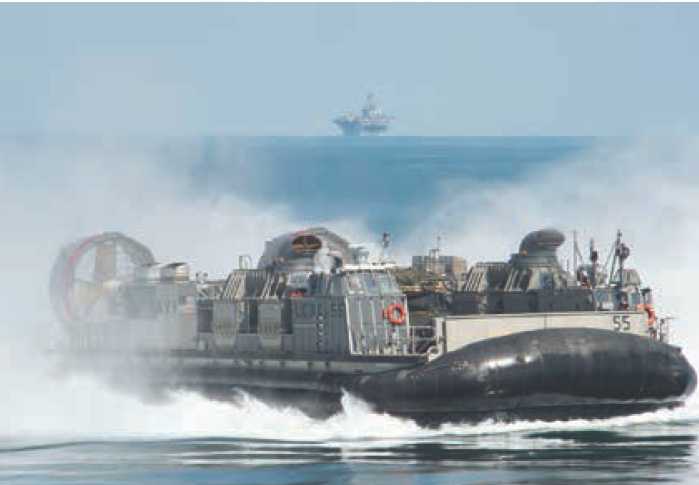
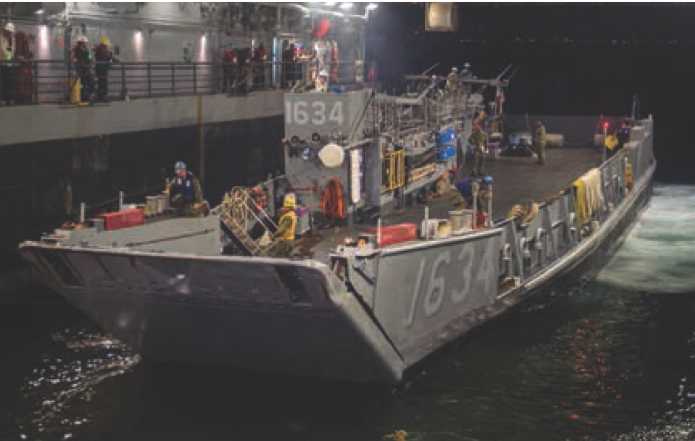
LCU 1610 Landing Craft Utility Vessels
Description
The Landing Craft Utility (LCU 1610)-class vessels are a self-sustaining craft complete with living accommodations and messing facilities for a crew of 14. An adaptation of the designs pioneered during the Second World War, the LCU 1610 class replaced the venerable Landing Craft Tank (LCT) Mk V starting in 1959. The LCU provides a persistent, long-range and high-capacity landing craft to complement the high-speed, over-the-beach delivery capacity of the LCAC. This steel-hulled and diesel-propelled craft is capable of carrying a 125-ton payload to a nominal range of 1,200 nautical miles. These vessels have bow ramps for onload/ offload, and can be linked from their bow to the stern gate of amphibious ships to create a temporary causeway structure for at sea offload of vehicles and equipment. Its welded steel hull provides high durability, accommodating deck loads of 800 pounds per square foot. Arrangement of machinery and equipment has taken into account built-in redundancy in the event of battle damage. The craft features two engine rooms separated by a watertight bulkhead to permit limited operation in the event that one engine room is disabled. An anchor system is installed on the starboard side aft to assist in retracting from the beach.
The LCU's ability to transit intra-theater distances and operate independent of well-deck amphibious warships for up to ten days provides additional operational flexibility and a level of persistence that no other asset smaller than an amphibious warship can provide to the operational commander. Carrying equipment, troops, and supplies in any variation up to its maximum capacity, the LCU launches from a well deck-equipped amphibious warfare ship, transits to the surf zone and lands vehicles and cargo to provide organic mobility for naval forces from the sea base to the shore. LCUs have been adapted for many uses, including salvage operations, ferry boats for vehicles and passengers and underwater test platforms, and have proven invaluable in support of humanitarian-assistance/disaster-relief missions, including Operation Tomodachi Tsunami Relief in Japan, Hurricane Katrina, and Operation Unified Response in Haiti. They have been critical to non-combatant evacuation operations, such as the evacuation of more than 14,000 Americans from Lebanon in 2006. LCUs are multi-mission craft that can also conduct offload of Military Sea-lift Command maritime prepositioned squadron ships via crane loading, and they interoperate with joint-logistics-over-the-shore operations to sustain forces operating inland.
Status
LCU 1610 craft entered service in 1959; the average age of the operational vessel in 2016 is 45 years. Rugged steel hulls and diesel engines have allowed these craft to serve effectively well beyond their initial design service lives of 25 years. There are 32 LCU 1610 vessels stationed at Little Creek, Virginia; Coronado, California; and Sasebo, Japan.
Developers
Multiple sources.
* * * * * * * * * * * *
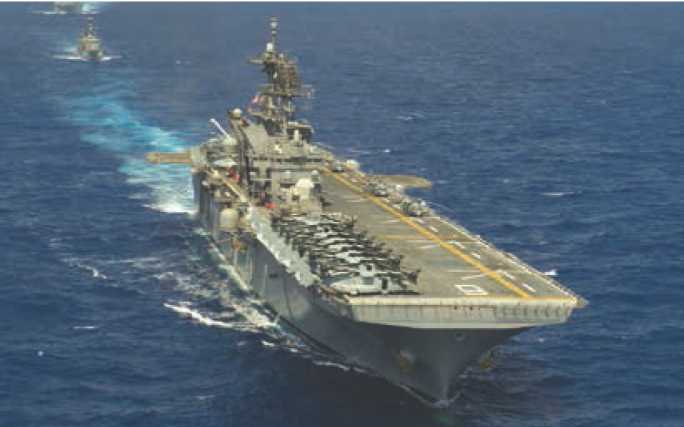
LHA 6 America-Class Amphibious Assault Ship
Description
America-class general-purpose amphibious assault ships—previously designated the LHA Replacement LHA(R) program— provide forward-presence and power-projection capabilities as elements of U.S. expeditionary strike groups. With elements of a Marine landing force, these warships will embark, deploy, land, control, support, and operate helicopters and MV-22 Osprey and F-35B Lightning II aircraft for sustained periods. The LHA 6-class will also support contingency-response and forcible-entry operations as an integral element of joint, interagency, and multinational maritime expeditionary forces. The USS America (LHA 6) is the first of the America class and is a variant of the USS Makin Island (LHD 8). The LHA 6 design includes an LHD 8 gas turbine and hybrid-electric propulsion plant, diesel generators, and all-electric auxiliary enhancements. These improvements represent a significant increase in aviation lift, sustainment, and maintenance capabilities. The Flight 0 (LHA 6 and LHA 7) ship optimization to support Osprey and F-35B aircraft includes: significantly increased JP-5 fuel capacity (1.3 million gallons, compared to 600,000 gallons for the Flight 1 (LHA 8) warships); space to support elements of a marine expeditionary unit or small-scale joint task force staff; an increase in service-life allowances for new-generation Marine Corps systems; and substantial survivability upgrades. The Flight 1 LHA 8 will modify the LHA 6 design to incorporate a well deck capable of supporting two landing craft air cushion vehicles and a reduced-island light deck to unlock seven F-35B spots and include a topside MV-22 maintenance spot. This will increase light deck space, thus retaining aviation capability on par with Flight 0 ships, which were optimized for aviation capability in lieu of a well deck.
Status
LHA 6 was launched June 4, 2012, delivered on April 10, 2014, and commissioned on October 11, 2014 in San Francisco during Fleet Week. The Navy awarded the contract for LHA 7 on May 31, 2012, the keel was laid on June 20, 2012, and the ship will deliver in December 2018. LHA 8 is programmed as a FY 2017 ship with planned delivery in FY 2025.
Developers
Avondale Marine Gulfport, Mississippi
Gryphon Technologies LC Panama City, Florida
Huntington Ingalls Industries, Ingalls Shipbuilding Pascagoula, Mississippi
* * * * * * * * * * * *
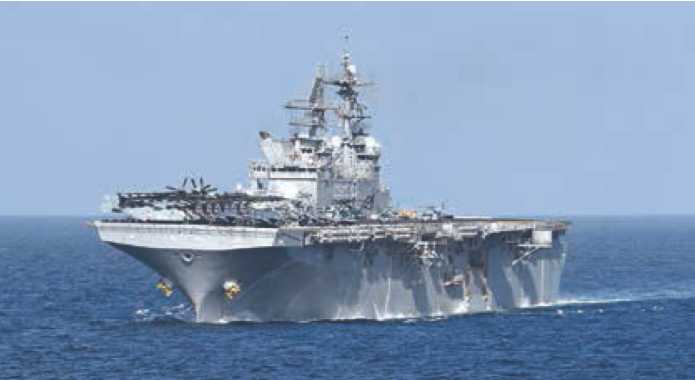
LHD 1 Wasp-Class Amphibious Assault Ship
Description
The Wasp class comprises eight 40,650-ton (full load) multipurpose amphibious assault ships whose primary mission is to provide embarked commanders with command and control capabilities for sea-based maneuver/assault operations as well as employing elements of a landing force through a combination of helicopters and amphibious vehicles. The Wasp-class also has several secondary missions, including power projection and sea control. LHD 1-class ships increase total lift capacity by providing both a light deck for helicopters and vertical/short takeoff and landing aircraft (AV-8B Harrier and the MV-22 Osprey), and a well deck for both air-cushioned and conventional landing craft. Each ship can embark 1,877 troops and has 125,000 cubic feet of cargo for stores and ammunition, and 20,900 square feet for vehicles. Medical facilities include six operating rooms, an intensive-care unit, and a 47-bed ward. LHDs 5 through 7 are modified variants of the class. Design changes include increased JP-5 fuel capacity, fire-fighting and damage-control enhancements, and women-at-sea accommodations. The USS Makin Island (LHD 8) incorporates significant design changes including gas-turbine propulsion, hybrid-electric drive, diesel generators, and all-electric equipment. Two gas turbines, providing 70,000 shaft-horsepower, replace the two steam plants found on earlier ships in the class, and the electric drive propels the ship while operating at flow speeds to increase fuel efficiency. All ships in the class will be modified to support F-35B Lightning II Joint Strike Fighter operations.
Status
Eight LHDs have been delivered to the Fleet. The USS Makin Island (LHD 8), the eighth and final ship of the class, commissioned on October 24, 2009 in San Diego, California. In FY 2014, the USS Wasp (LHD 1) completed modifications to support F-35B operations. The LHD mid-life program is scheduled to begin in FY 2016 with the USS Essex (LHD 2) and will enable LHDs to meet amphibious mission requirements and a 40-year expected service life starting in FY 2029 through FY 2049. The mid-life program is a key component to achieve LHD 1 "Class Wholeness" and includes hull, mechanical and electrical upgrades and C5I (command, control, communications, computers, collaboration, and intelligence); aviation; and training improvements.
Developers
Huntington Ingalls Industries, Ingalls Shipbuilding Pascagoula, Mississippi
* * * * * * * * * * * *
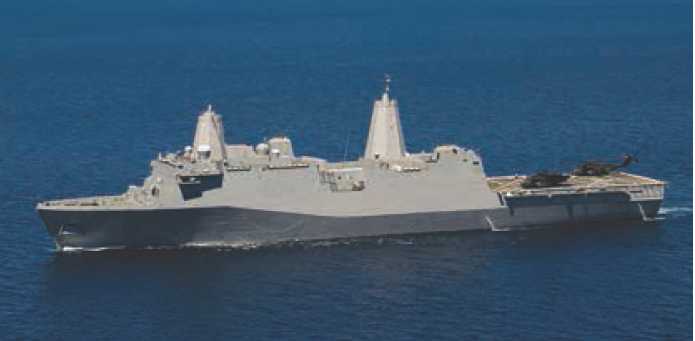
LPD 17 San Antonio-Class Amphibious Transport Dock Ship
Description
The San Antonio LPD is an amphibious transport dock ship optimized for operational flexibility and satisfying Marine Air-Ground Task Force (MAGTF) lift requirements in support of the expeditionary maneuver warfare concept of operations. The San Antonio-class LPDs are 684 feet in length, with a beam of 105 feet, a maximum displacement of 25,000 long tons, and a crew of approximately 380. Four turbocharged diesels with two shafts and two outboard-rotating controllable-pitch propellers generate a sustained speed of greater than 22 knots. Other ship characteristics include 20,000 square feet of space for vehicles—about twice that of the Austin-class (LPD 4), which LPD 17 replaces—34,000 cubic feet for cargo, accommodations for approximately 700 troops (800 surge), and a medical facility comprising 24 beds and four operating rooms (two medical and two dental). The well deck can launch and recover traditional surface assault craft as well as two landing craft air cushion vehicles capable of transporting cargo, personnel, Marine tracked and wheeled vehicles, and tanks. The LPD 17 aviation facilities include a hangar and light deck (33 percent larger than the LPD 4-class) to operate and maintain a variety of aircraft, including current and future fixed- and rotary-wing aircraft. Other advanced features include the advanced enclosed mast/sensor for reduced signature/sensor maintenance, reduced-signature composite-material enclosed masts, other stealth enhancements, state-of-the-art C4ISR (command, control, communications, computers, intelligence, surveillance, and reconnaissance) and self-defense systems, a shipboard wide-area network linking shipboard systems with embarked Marine Corps platforms, and significant quality of life improvements.
Status
The initial contract award to design and build the lead ship of the class was awarded to the Avondale-Bath Alliance in December 1996. The Navy transferred LPD 17 class workload from Bath Iron Works to Northrop Grumman Ship Systems (NGSS, now Huntington Ingalls Industries, Ingalls Shipbuilding) in June 2002. LPDs 17 through 26 have been delivered. Pre-Commissioning Unit Portland (LPD 27) will deliver in FY 2017. An additional ship, Fort Lauderdale (LPD 28), has been authorized and funded. Construction will begin in FY 2017 and delivery is scheduled for FY 2021.
Developers
Huntington Ingalls Industries,
Ingalls Shipbuilding Pascagoula, Mississippi
Raytheon San Diego, California
* * * * * * * * * * * *

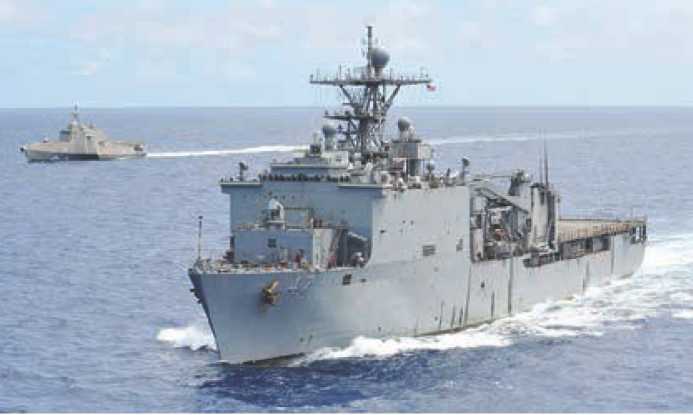
LSD 41 / 49 Whidbey Island / Harpers Ferry-Class Dock Landing Ships
Description
The mission of Whidbey Island/Harpers Ferry dock landing ships is to transport and launch amphibious assault vehicles and landing craft with their crews and embarked personnel. The key difference between the LSD 49-class and the LSD 41-class is that the LSD 49-class cargo variants have significantly expanded cargo and ammunition stowage facilities over those of the LSD 41-class at the cost of decreased landing craft air cushion (LCAC) capacity, from four to two. The LSD 41 Whidbey Island class is the primary support and operating platform for LCACs and can also provide limited docking and repair services as a boat haven for small ships and craft. Both LSD classes have two primary helicopter spots and can support Navy and Marine Corps helicopters as well as MV-22 Osprey tilt-rotor operations. Neither class is configured with a helicopter hangar, with aircraft fueling and rearming conducted on the light deck. LSDs are equipped with a vehicle turning area and tactical logistics communication spaces to facilitate and coordinate troop/vehicle movement and logistics. These ships have a doctor and dentist assigned as ship's company, two dental examination rooms, and one medical operating room.
Status
In late 2016, 12 LSDs were in the fleet: eight LSD 41-class and four LSD 49-class. Mid-life programs are designed around a 52-week maintenance availability with 11 ships already completed or in progress. The USS Tortuga (LSD 46) will receive her mid-life availability during a four-year deep-maintenance and modernization period (2016-2020). The mid-life program will enable both ship classes to meet amphibious mission requirements and a 40-year expected service life (ESL), with the first ship reaching ESL in FY 2025. The mid-life program improves material condition readiness, replaces obsolete equipment, and provides hull, mechanical and electrical systems upgrades. All ships have completed their mid-life availabilities with the exception of the USS Tortuga.
Developers
Avondale Industries, Inc. New Orleans, Louisiana
Lockheed Martin Seattle, Washington
Raytheon San Diego, California
* * * * * * * * * * * *
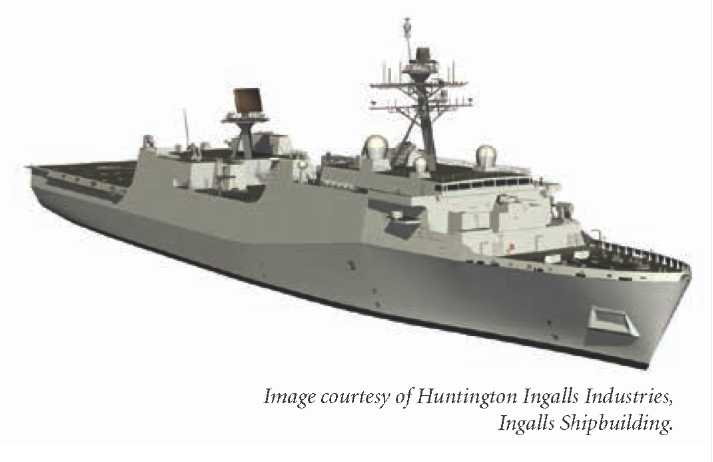
LX(R) Dock Landing Ship Replacement
Description
LX(R) is intended to replace the LSD 41 Whidbey Island and LSD 49 Harpers Ferry classes of dock landing ships when they begin reaching end of service life in 2025.
Status
The Navy's long-range shipbuilding plan associated with the FY 2013 President's Budget identified the LX(R) as an 11-ship program with lead ship procurement in FY 2018. LX(R) will be a recapitalization of the LSD 41/49 class. Planning for a replacement is well underway to ensure necessary lead-time for program development. The LX(R) initial capabilities have been defined, and initial contract design awards were issued to Huntington Ingalls Industries and General Dynamics NASSCO (the two competing shipyards) in June 2016. In September 2016 the Joint Staff approved the LX(R) capabilities development document. Following contract award in 2018, lead ship start of construction is scheduled for FY 2021 and delivery in FY 2025.
Developers
To be determined.
* * * * * * * * * * * *
MCM 1 Avenger-Class Mine Countermeasures Ship Modernization (MCM MOD)
Description
The Avenger-class surface mine countermeasures ships are used to detect, classify, and neutralize or sweep mines in sea lines of communication and naval operating areas. These ships are one leg of the mine countermeasures "triad" comprising surface and airborne MCM and explosive ordnance disposal forces. MCM modernization improvement corrected the most significant maintenance and obsolescence issues in order to maintain the ships through their full 30-year service lives. The modernization package included: product improvement program upgraded the Isotta Fraschini main engines and generators for MCM 3 through MCM 14; replacement of the SLQ-48 mine neutralization vehicle on select hulls, addressed obsolete components; upgraded the SQQ-32 sonar with high-frequency wide-band capabilities; and replaced the acoustic sweep system with the advanced acoustic generator/infrasonic advanced acoustic generator system.
Status
Ship decommissionings have commenced and the entire class will be decommissioned by FY 2024.
Developers
Raytheon Portsmouth, Rhode Island
* * * * * * * * * * * *
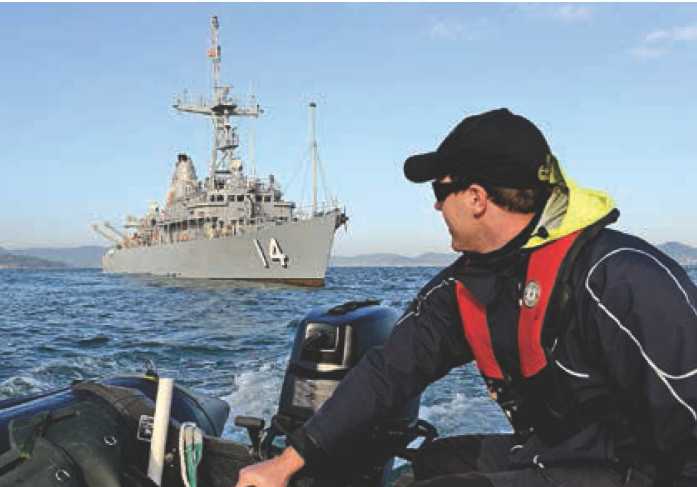
Ship-to-Shore Connector (SSC) / LCAC 100
Description
The Ship-to-Shore Connector/Landing Craft Air Cushion 100 will provide high-speed, heavy-lift for over-the-horizon maneuver, surface lift, and shipping. The SSC/LCAC-100 is addressing the gap in heavy sea-to-shore lift that will emerge as the upgraded in-service LCAC reach their end of extended service lives after FY 2015. The SSC/LCAC-100 payload design will exceed the legacy LCAC payload of 74 short tons. The SSC design improves upon high failure rate and maintenance intensive systems to increase reliability and reduce life cycle costs. SSC/LCAC-100 will also employ enhanced lift fans, propellers, and greater use of composite materials.
Status
The Joint Requirements Oversight Council approved the initial capabilities document in October 2006. An analysis of alternatives was approved in early FY 2008, the capability development document (CDD) was approved in June 2010, and the CDD was accepted in lieu of the capability production document in October 2014. Initial operational capability is scheduled for FY 2020. A contract for the detailed design and construction of the first craft with options to build eight additional craft was awarded in July 2012. The first craft is funded by research, development, test and evaluation funds to serve as an operational test and evaluation platform, as well as a crew-transition training platform to allow for LCAC crews to become familiar with LCAC 100. The options included in the contract enable the Navy to begin flow-rate initial procurement of the first test and training craft plus eight option craft to support fleet introduction in the FY 2020 timeframe. Fabrication of the first SSC/LCAC 100 began in November 2014.
Developers
Alcoa Defense Pittsburgh, Pennsylvania
L-3 Communications New York, New York
Textron Marine & Land Systems New Orleans, Louisiana
* * * * * * * * * * * *
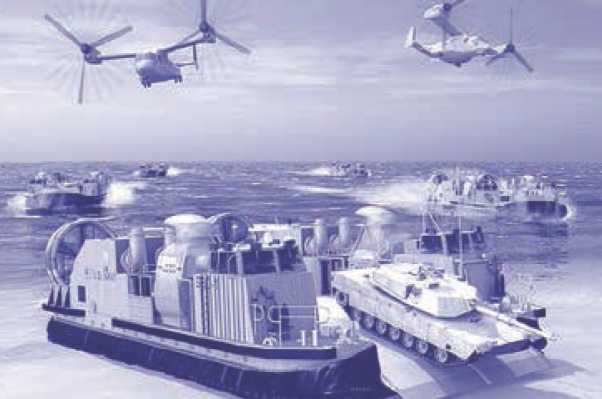
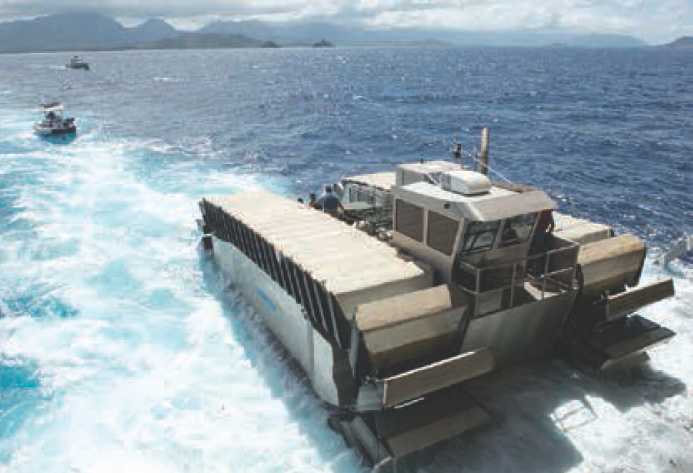
Surface Connector (X) Replacement (SC(X)R)
Description
The Surface Connector (X) Replacement will recapitalize the capabilities provided by the long-serving LCU-1610 craft. SC(X) R will be a self-sustaining craft complete with living accommodations and messing facilities for the crew to enable persistent operations for up to ten days or intra-theater transit of up to 1,200 nautical miles. Like the venerable LCU, the SC(X)R will provide operational flexibility and a level of persistence no other asset smaller than an amphibious warfare ship provides to the operational commander. Carrying equipment, troops, and supplies in any variation up to its maximum capacity of 170 tons, the SC(X)R will launch from a well deck-equipped amphibious warfare ship, transit to the surf zone, and land vehicles and cargo to provide organic mobility for naval forces from the sea base to the shore. The SC(X)R is intended to address the gap in heavy sea-to-shore lift that will emerge as a result of the advanced age and long service of the LCU-1610 craft.
Status
The SC(X)R/LCU 1700 completed the Navy Requirements/ Acquisition Gate Review 1 in 2013. The analysis of alternatives to identify the suitable candidates to replace the LCU-1610 was completed in May 2014 and approved in September 2014. Navy Gate 2 was completed in October 2014, and the capability development document was approved and validated in July 2016.
Developers
To be determined.
* * * * * * * * * * * *
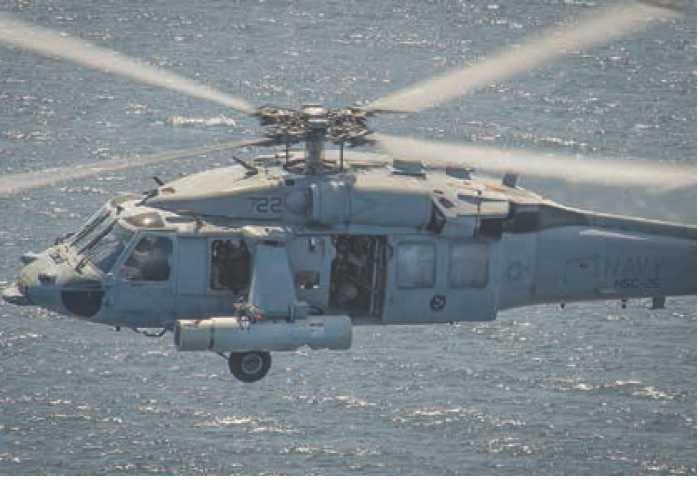
EXPEDITIONARY SYSTEMS
AES-1 Airborne Laser Mine Detection System (ALMDS)
Description
The Airborne Laser Mine Detection System is a light-detection and -ranging airborne mine countermeasures (AMCM) high-area coverage system that detects, classifies, and localizes floating and near-surface moored sea mines. The system is deployed in the MH-60S helicopter and will provide organic AMCM defense to the battle force.
Status
ALMDS completed operational assessment as part of the Littoral Combat Ship mine countermeasure mission package in FY 2015. Pre-planned product improvement delivers in 2018. Initial operational capability is scheduled for FY 2017.
Developers
Arete Associates Tucson, Arizona
Northrop Grumman Melbourne, Florida
* * * * * * * * * * * *
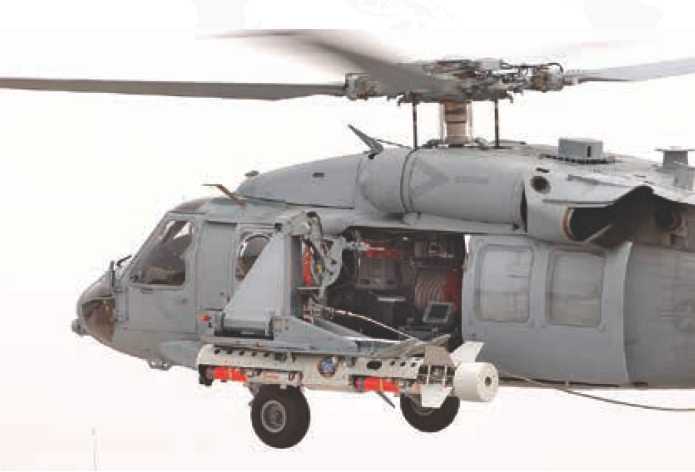
Airborne Mine Neutralization System (AMNS)
Description
The Airborne Mine Neutralization System is deployed from the MH-60S helicopters using an expendable mine neutralization device, the Archerfish, with the capability to neutralize bottom and moored mines. The AMNS will be deployed from the littoral combat ship (LCS) as a key element of the LCS mine countermeasures mission module. This capability will be of critical importance in littoral zones, confined straits, choke points, near shore, and amphibious objective areas.
Status
AMNS successfully completed integrated test in May 2013 and demonstrated operational assessment as part of the LCS mine countermeasure mission package in FY 2015. Initial operational capability is scheduled for FY 2017.
Developers
BAE Systems Portsmouth, England
Raytheon Portsmouth, Rhode Island
* * * * * * * * * * * *
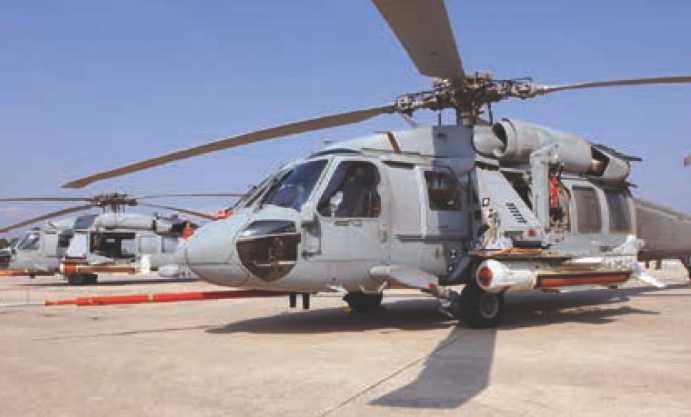
AQS-20A Sonar
Description
The AQS-20A is an underwater mine-detection side- and forward-looking sonar suite that also employs an electro-optic Identification sensor capable of locating and identifying bottom, close-tethered, and moored sea mines. The AQS-20A system will serve as a mine-hunting sensor subsystem of the Littoral Combat Ship mine countermeasures mission package.
Status
Improvements to the computer-aided detection/computer-aided classification and environmental data-collection capabilities are being implemented via enhanced research and development efforts. AQS-20A initial operational capability is projected for FY 2020.
Developers
Raytheon Portsmouth, Rhode Island
* * * * * * * * * * * *
Assault Breaching System (ABS)
Description
The Assault Breaching System program focuses on development of standoff systems to locate and neutralize mine and obstacle threats in the surf and beach zones. The program uses a system-of-systems approach that includes incremental development of the Coastal Battlefield Reconnaissance and Analysis (COBRA) mine/obstacle detection system and precision craft navigation and lane marking. The Joint Direct-Attack Munition Assault Breaching System (JABS) provides in-service neutralization capability against "proud" (i.e., not buried) bottom mines and obstacles in the beach and surf zone. The platform for the COBRA system is the Fire Scout vertical take-off unmanned aerial vehicle. Platforms for deploying neutralization systems include Navy strike aircraft and Air Force bombers.
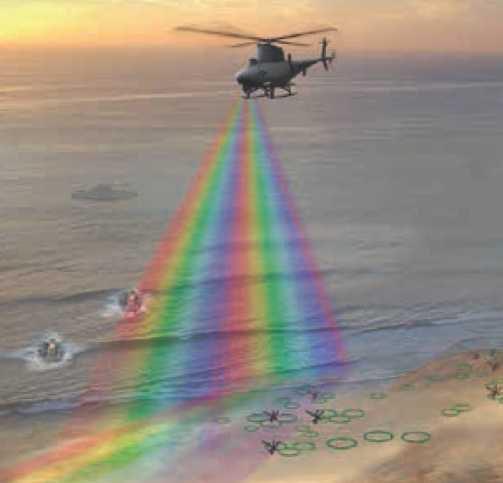
Status
The COBRA Block I system achieved Milestone C in FY 2009, and initial operational capability is scheduled for FY 2017. JABS is a fielded capability in the beach and surf zone with ongoing testing to expand its capability into the very-shallow water zone.
Developers
Arete Tucson, Arizona
The Boeing Company St. Louis, Missouri
* * * * * * * * * * * *
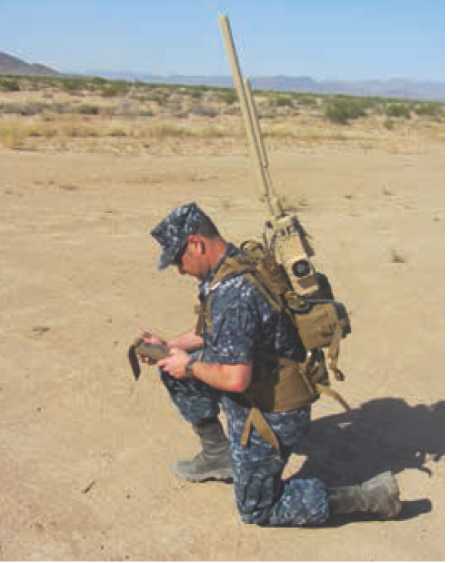
Joint Counter Radio-Controlled Improvised Explosive Device (RCIED) Electronic Warfare (JCREW)
Description
Improvised explosive devices (IEDs) continue to present a significant threat to U.S. and coalition forces throughout the world. The Counter Radio-Controlled IED Electronic Warfare (CREW) program encompasses mobile, man-portable, and fixed-site protection systems employed to counter IEDs that are either armed or initiated by radio signals. Fielded first- and second-generation CREW systems were acquired largely by non-developmental urgent operational need initiatives to address immediate warfighter requirements. Joint CREW (JCREW) is a Navy-led program to develop the next generation of joint-service CREW systems. JCREW will correct deficiencies in existing CREW systems and address emerging worldwide RCIED threats. Additionally, JCREW has an open architecture, facilitating the system's evolution as new threats, advances in technology, and new vehicle requirements are introduced.
Status
JCREW Increment 1 Block 1 (I1B1) program management remains with the Navy through the program life cycle, integrating joint service requirements. Milestone C was approved on September 9, 2014 and the acquisition program baseline was approved on October 5, 2014. The Navy and Air Force combined flow-rate initial production contract was awarded September 30, 2015. The Navy is responsible to upgrade JCREW techniques to defeat evolving global threats and improved capability is developed and fielded through a technology insertion program.
Developers
Northrop Grumman Systems Corporation San Diego, California
* * * * * * * * * * * *
KSQ-1 Amphibious Assault Direction System (AADS)
Description
The Amphibious Assault Direction System, with Enhanced Position Location Reporting System, integrates the NAVSTAR global positioning system to form a jam/intercept-resistant, friendly force-tracking and command and control system that supports the surface assault ship-to-shore movement in amphibious operations. It provides the capability to launch, monitor, track, record, and control landing craft air cushion (LCAC), landing craft utility (LCU) vessels, Naval Beach Group/seabasing craft conducting amphibious assaults from up to 100 nautical miles over the horizon (OTH) via radio relay group configuration. It integrates with the Marine Corps tactical radio (PRC-117G) and the Global Command and Control System-Maritime during ship-to-objective-maneuver operations.
Status
AADS satisfies operational requirements for an OTH amphibious assault command and control system. AADS is installed in 32 amphibious ships, 78 LCACs and 32 LCUs, in addition to Assault Craft Units 4 and 5 control towers, and Expeditionary Warfare Training Group (Atlantic and Pacific) Amphibious Boat Control Team Trainer (ABCTT) classrooms. ABCTT upgraded with AADS Simulator to properly train Amphibious Boat Control Team as per fielded boat control configurations. The AADS program Office is executing the AADS modernization plan, which addresses program IT risk assessment issues, Windows XP to Windows 7 migration and other upgrades to improve system integrity. The AADS program Office is also working to provide a coalition common operating picture with Australian and Canadian Forces using the KOK-23 Crypto Key Generator.
Developers
Naval Surface Warfare Center - Panama City Division Panama City, Florida
* * * * * * * * * * * *
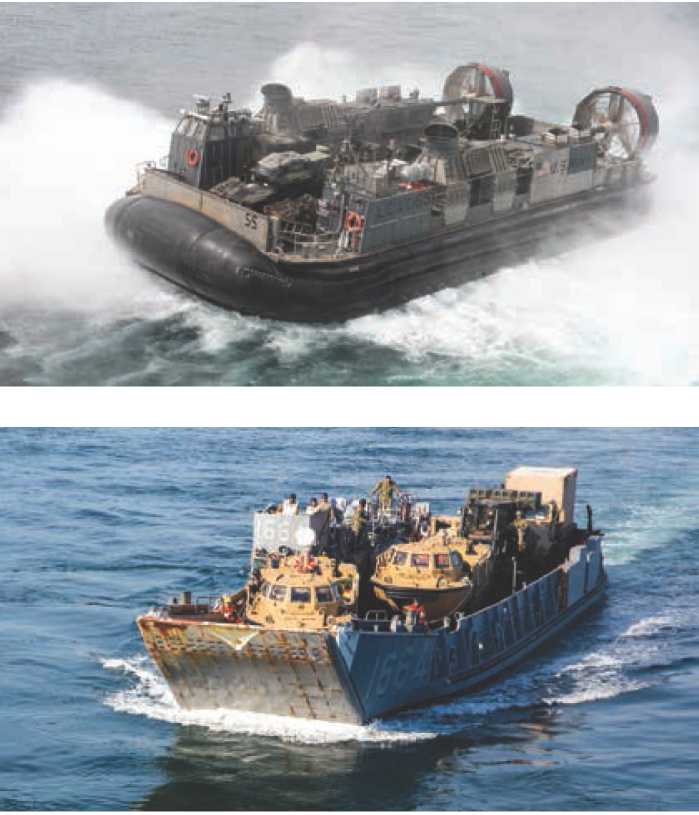
Mk 62/63/65 Naval Quickstrike Mines
Description
The in-service Quickstrike family of aircraft-delivered bottom mines is being enhanced significantly by procurement of the programmable Target Detection Device (TDD) Mk 71. Engineering development efforts include new advanced algorithms for ship detection, classification, and localization against likely threats, including quiet diesel-electric submarines, mini-subs, fast patrol boats, and air-cushioned vehicles. The Quickstrike mines include one dedicated thin-wall mine—the 2,300-pound Mk 65 weapon—and two mines converted from conventional bombs using the Conversion Kit Mk 197: the Mk 62 500-pound and Mk 63 1,000-pound mines.
Status
In-service support continues for current inventories, and funding is in place for algorithm development and procurement of the TDD Mk 71 and associated hardware for Conversion Kit Mk 197. Aircraft integration and testing are ongoing to certify this new configuration for use on various Air Force and Navy aircraft.
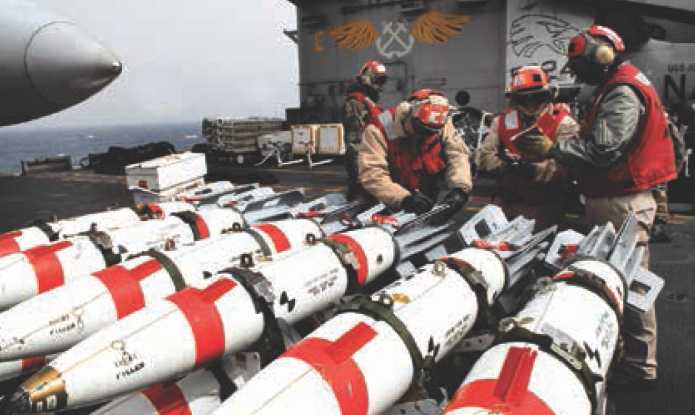
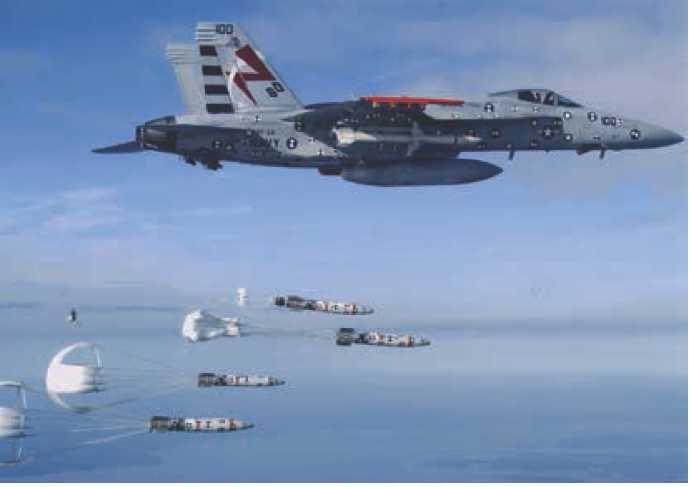
Developers
SECHAN Electronics, Inc. Lititz, Pennsylvania
* * * * * * * * * * * *
Submarine Launched Mobile Mine (SLMM) Description
The submarine launched mobile mine is a bottom influence mine that is launched from Los Angeles/Improved Los Angeles (SSN 688/688I)-class submarines, using a Mk 37 torpedo propulsion system and the Target Detection Device (TDD) Mk 57 as its sensing mechanism. SLMM provides the Navy's only clandestine mining capability. The SLMM has been in-service since 1983 and was originally scheduled to be phased out by the end of 2012. However, in December 2012, the Chief of Naval Operations directed retention of a specific quantity of SLMMs in a Ready for Issue status—the exact number is classified.
Status
SLMM support and maintenance continues, provided by the Naval Munitions Command Unit Guam. All in-service weapons are maintained in an all-up round status and as Ammunition Condition Code A: Ready for Issue. Future efforts will certify the Navy's advanced Mk 71 TDD into the weapon system to add greater targeting flexibility.
Developers
Multiple sources.
* * * * * * * * * * * *
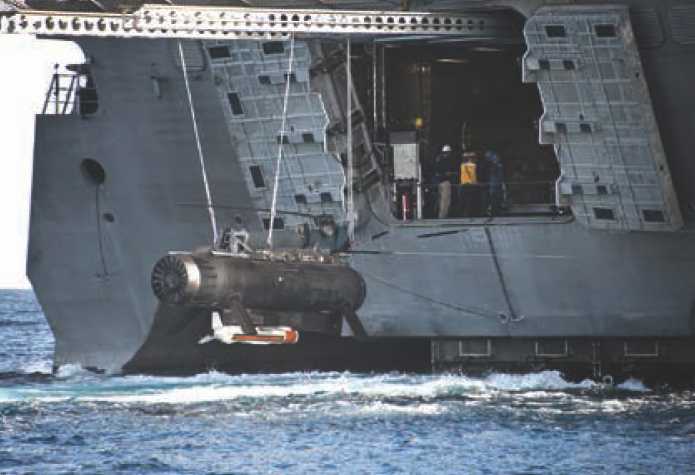
WLD-1 Remote Minehunting System (RMS)
Description
The WLD-1 Remote Minehunting System consists of one remote multi-mission vehicle and one AQS-20A variable-depth sonar. RMS is a high-endurance, semi-submersible, unmanned, off-board, flow-observable vehicle operated from the littoral combat ship (LCS). RMS is launched with a pre-programmed search pattern and will search detect, classify, and identify non-mine objects and mine threats. RMS is capable of line-of-sight and over-the-horizon operations. Once the mission is completed, RMS will return to the ship and data will be downloaded for post-mission analysis in which targets classified as mines are passed to follow-on systems for neutralization.
Status
To support LCS integration, RMS is being used as a surrogate tow platform for the AQS-20 sensor until the common unmanned surface vehicle has completed development and testing for LCS mine countermeasure mission package integration in FY 2020.
Developers
Lockheed Martin Riviera Beach, Florida
* * * * * * * * * * * *

The Navy's Information Warfare Force comprises cryptologic warfare, meteorology and oceanography, intelligence, and information professionals. By combining those elements the Navy has aligned the Information Warfare Force with Air Warfare, Surface Warfare, and Undersea Warfare, and underscores efforts to identify information warfare as one of four predominant naval warfare areas. That alignment will help the Navy achieve mastery in the "information age" warfighting arena. Capabilities and programs include Consolidated Afloat Networks and Enterprise Services (CANES), Global Command and Control System-Maritime, and various unmanned aircraft systems, advanced data links, decoys, and more that contribute to broad-spectrum maritime domain awareness.
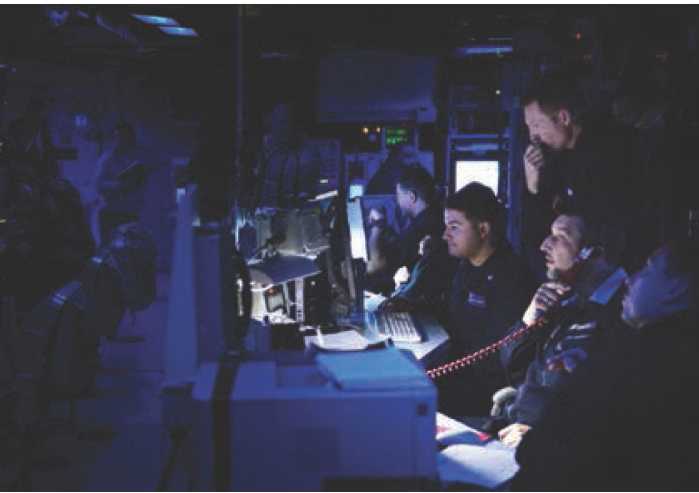
ASSURED COMMAND AND CONTROL
Afloat Electromagnetic Spectrum Operations Program (AESOP)
Description
The U.S. Navy's Afloat Electromagnetic Spectrum Operations Program is the only fielded operational spectrum planning tool that integrates surface radars, combat systems, and communications frequencies to de-conflict and reduce the electromagnetic interference (EMI) impacts for ships and strike groups. AESOP also develops the Operational Tasking Communication (OPTASK COMM) and OPTASK Electronic Warfare (EW) Annex K Radar Frequency Plans that support strike groups and coalition navies in joint exercises and operations, to ensure all systems interoperate and missions are successful. AESOP uses U.S. Navy-approved propagation models that include all strike group emitters—Navy and coalition partners—to identify and mitigate potential interoperability issues. In addition, AESOP helps to ensure that systems are in compliance with both national and international spectrum allocations and regulations. AESOP provides many benefits and enables the warfighter to maximize the performance of their systems by reducing system susceptibilities to interference or unintentional jamming, resulting in clear communications, increased detection ranges and intercepts, and enhanced awareness for emission control. AESOP is a man-in-the-loop fleet capability. Using sophisticated models and algorithms, the program creates OPTASK plans in minutes versus a manual process that would require days to complete.
Status
In 2016 196 ships were using AESOP 3.2 and 194 ashore commands. Accompanying the AESOP software programs are the EMC Criteria for Navy Systems Revision 3 and the Littoral Spectrum Restrictions Revision 4.The next progression for AESOP is to integrate and automate this capability with shipboard sensors to develop a real-time spectrum operations (RTSO) capability, a key tenet and enabler of electro-magnetic maneuver warfare (EMW). It is foundational to the EMW framework: electromagnetic resource control and allocation, EM awareness, EM agility, signature control, and EM engagement. RTSO will provide ships and strike groups the ability to sense, control, and plan the use of spectrum, detect electromagnetic interference, notify the operators of spectrum issues, and provide recommended actions allowing for command and control of the spectrum. It will be a networked collection of firmware, software, and hardware that continuously monitors the spectrum via direct connections to existing shipboard systems as well as antennas receiving the external environment. Once deployed, it will share this information across the strike group and be cognizant of global frequency restrictions. RTSO will execute the Navy's vision for information warfare and EMW by controlling the electromagnetic spectrum terrain and mitigating EMI. RTSO will enable the Navy to transition from its legacy static spectrum operations through three major incremental improvements embracing a dynamic, automated, real-time spectrum operations approach. RTSO will provide real-time dynamic command and control of the spectrum terrain. This transition from a static, assignment-based spectrum management system to a fully automated, real-time system is outlined in the Navy's Information Warfare Roadmap for Electromagnetic Spectrum (EMS) Usage. The EMS Usage Roadmap provides plans of action with timelines to drive Navy policy, engagement, and investment decisions regarding the operationalization of the electromagnetic spectrum.
Developers
EOIR Corporation Dahlgren, Virginia
Naval Surface Warfare Center
Dahlgren Division Dahlgren, Virginia
SENTEL Corporation Dahlgren, Virginia
* * * * * * * * * * * *

Automated Digital Network System (ADNS)
Description
The Automated Digital Network System is the key enabler for delivering net-centric capabilities that depend upon robust, dynamic, adaptable, survivable, and secure communications. ADNS is the shipboard network interface that enables connectivity between the ship's internal network and the outside world via radio frequency (RF) spectrum and landline when pier side. ADNS is also installed in Navy network operations centers (NOCs), enabling the NOCs to transmit and receive voice and data to and from ships. ADNS provides capability that enables unclassified, secret, top secret, and various joint, allied, and coalition services to interconnect to the Defense Information Systems Network.
ADNS Increment I combined data from different enclaves for transmission across available communications paths. ADNS Increment II added the capability to manage traffic from multiple enclaves simultaneously over multiple transit paths, including RF and terrestrial links, but still did not satisfy the Fleet's need for higher throughput. Increased throughput and converged internet protocol (voice, video, and data) capabilities were delivered to the Fleet with the deployment of Increment IIa/IIb. ADNS Increment III brings a protected core, reducing the exposure to cyber warfare network infiltration. It supports 25 megabits per second (mbps) aggregate throughput for submarines and unit-level ships and 50 mbps aggregate throughput for force-level ships. ADNS Increment III is a key enabler of the Navy's maritime security posture.
Status
ADNS is fully deployed and is undergoing sustainment and improvement efforts while migrating legacy increments are being migrated to ADNS Increment III. ADNS Increment III reached initial operational capability in FY 2010; ashore NOC installs were completed in FY 2010. Increment III will be installed on all ships and submarines and their respective shore facilities. ADNS Increment III is planned to reach full operational capability in FY 2020 and is synchronized with Consolidated Afloat Networks Enterprise Services deployment.
Developers
PEO C4I San Diego, California
Science Applications
International Corporation Arlington, Virginia
Space and Naval Warfare Systems
Center Pacific San Diego, California
* * * * * * * * * * * *
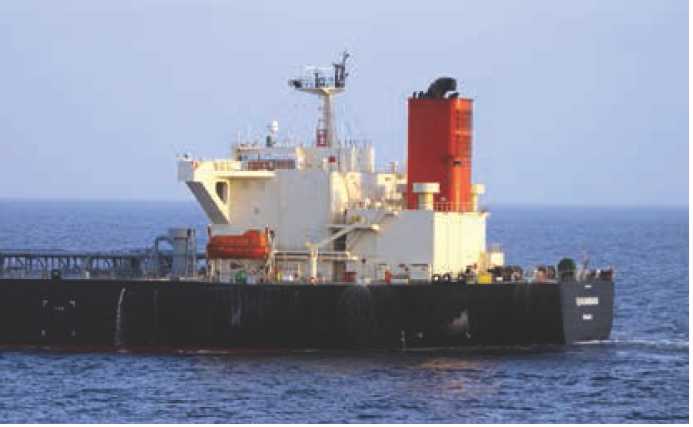
Automatic Identification System (AIS)
Description
The Automatic Identification System is a maritime digital broadcast system that continually exchanges voyage and vessel data among network participants over very-high-frequency radio in support of regional and global maritime domain awareness (MDA) requirements. The data include vessel identity, position, speed, course, destination, and other information of critical interest for navigation safety and maritime security. The International Maritime Organization and the 1974 International Convention for the Safety of Life at Sea require commercial vessels greater than 300 gross tons and all passenger ships to use AIS. Warships are exempt. The Navy AIS program collects open-source AIS data broadcast from AIS transceivers on commercial vessels. Open-source AIS data, combined with other government intelligence and surveillance data, is used by Navy ships and submarines to improve safety of navigation and is integrated into the common operational picture to enhance situational awareness. The AIS data collected by Navy platforms is also aggregated within the MDA/AIS Sensor/Server (MASS) capability at several operational shore sites. The MASS then provides the data to unclassified and classified users in support of MDA efforts, with particular focus on improving the Nation's maritime security.
Status
Navy AIS began as a rapid deployment capability, transitioned to a program of record on December 24, 2008, and was designated as an Acquisition Category IV program. The Space and Naval Warfare Systems Command Program Executive Office C4I is the milestone decision authority. As of October 2016, Increment I AIS systems were installed on 170 unit-level and group-level ships (e.g., patrol craft, cruisers and destroyers), 20 force-level ships (e.g., aircraft carriers and large-deck amphibious assault ships), 37 submarines, and four shore sites (Third Fleet, Fifth Fleet, Pacific Fleet, and Fleet Forces Command). The systems include a laptop computer display on the bridge and connectivity to send unclassified AIS data to shore sites. They also enable the direct transfer of AIS track information. The Navy is implementing a firmware upgrade to add encrypted capability on submarine AIS systems to improve safety of navigation for submarines operating in close proximity to Coast Guard vessels that routinely encrypt their AIS position reports.
Developers
L-3 Communications Orlando, Florida
SAAB Transponder Technologies Sterling, Virginia
* * * * * * * * * * * *
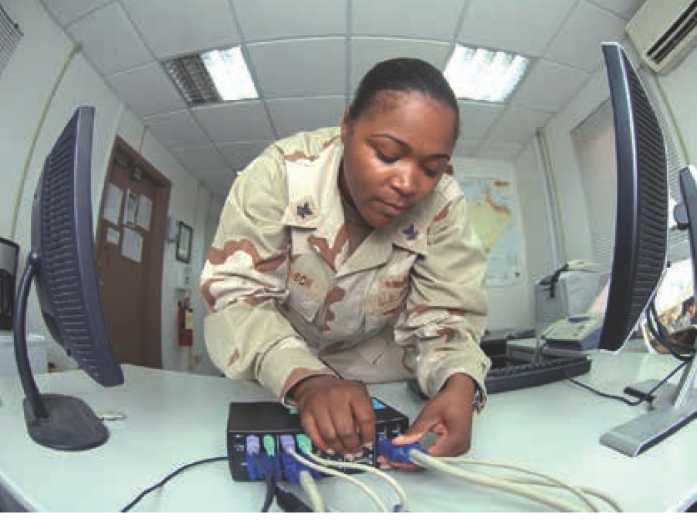
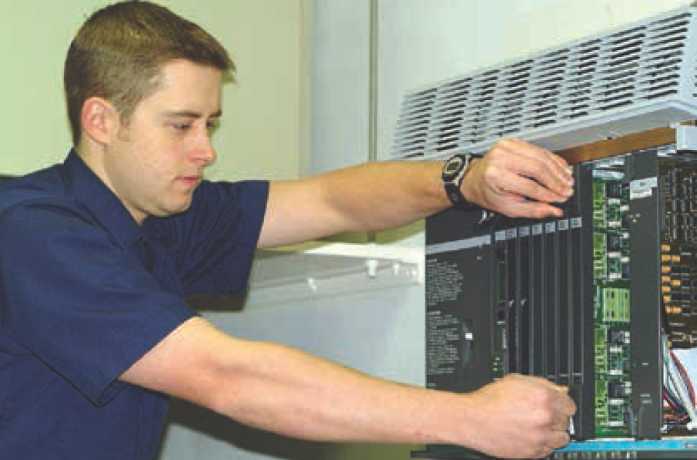
Base Communications Office (BCO)
Description
Base Communications Office provides: (1) operations and maintenance—manage telephone switching networks and outside cable plant infrastructure; (2) telephone services—operate, maintain, and manage government and commercial service delivery points providing connectivity to Defense Switch Network (DSN), Public Switched Telephone Network (PSTN), and General Services Administration commercial long-distance service; (3) audio conferencing services—operate and maintain ad-hoc unclassified audio conferencing services; (4) billing support—provide telephone invoice validation and customer billing, and process customer requests for services; (5) voicemail services—operate and maintain standard business-class voicemail services; (6) customer support; (7) requirements definition and planning; (8) review of military construction and special projects; and (9) move, add, and change telephone services. The Fleet Cyber Command/Tenth Fleet manages the program, and the PEO-C4I/PMW790 Shore Telephony Program Office provides acquisition support to the BCO program, which serves more than 350,000 Navy personnel worldwide. Lifecycle switch replacement provides voice over internet protocol capability.
Status
Naval Computer and Telecommunications Area Master Stations BCOs provide base communications services and support to approximately 3,890 Navy and non-Navy shore activities and deployable units. BCOs operate, maintain, and manage the communications infrastructure supporting the transport of switched voice, video, and data in support of 49 BCOs worldwide. BCOs provide services at 114 campuses (base/station/other) and manage 109 government-owned telephone switches and 13 commercial dial-tone central exchange switches. This program responds to about 70,000 customer service requests worldwide each year, and its operators and automated attendants handle some 320,000 calls per month.
Developers
Science Applications
International Corporation Arlington, Virginia
Space and Naval Warfare Systems
Center Pacific San Diego, California
* * * * * * * * * * * *
Base Level Information Infrastructure (BLII)
Description
Base Level Information Infrastructure provides a fully integrated, interoperable, and secure information technology (IT) infrastructure that enables the rapid and reliable transfer of voice, video, and data to bases, stations, homeports, and piers outside of the continental United States (OCONUS). BLII area of responsibility includes 14 major OCONUS fleet bases, stations, and other remote locations. BLII provides the infrastructure, hardware, and software for the Fleet Cyber Command/Tenth Fleet-managed
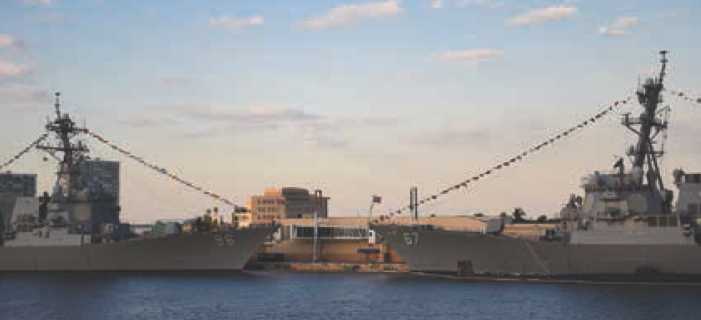
* * * * * * * * * * * *
OCONUS Navy Enterprise Network (ONE-NET) Operations.
BLII also sustains Navy CONUS/OCONUS pier IT infrastructure capability, which includes maintaining pier fiber runs, conduits, junction boxes, brow umbilicals, and associated electronics. Modern pier IT infrastructure enables forward-deployed ships to maintain situational awareness, receive operational and intelligence traffic, and perform maintenance or training on their radio frequency systems while pier-side.
Status
This program provides IT services to 28,000 BLII/ONE-NET seats, supporting approximately 51,000 forward-deployed OCONUS Navy users. Additionally, all piers/maintenance will be brought under a single program manager to centralize maintenance functions and accountability. This program is expected to transition into the Next-Generation Enterprise Network follow-on contract by the end of FY 2018. This merger will realize standardization and efficiencies associated with a centrally managed program.
Developers
Booz Allen Hamilton San Diego, California
Computer Sciences Corporation San Diego, California
Deloitte San Diego, California Science Applications International
Corporation San Diego, California
* * * * * * * * * * * *
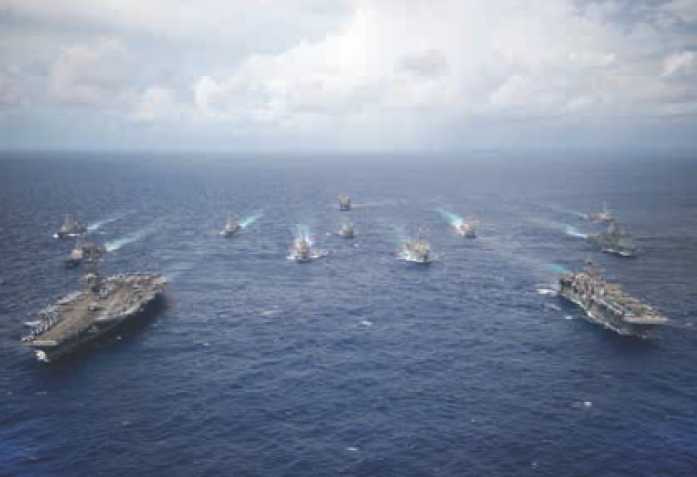
Battle Force Tactical Network (BFTN)
Description
The Battle Force Tactical Network is the Navy's program of record for high-frequency internet protocol (HFIP) and subnet relay (SNR) communications, providing command and control in a satellite communications-denied environment and serves as a primary backup for SIPRNET (Secret Internet Protocol Router Network) in the absence of satellite communications. The HF component of BFTN is HFIP, which is capable of data rates of 9.6 kilobits per second (kbps) in single side band and 19.2 kbps in independent side band. The UHF component of BFTN is SNR, which is capable of data rates up to 64 kbps. BFTN also provides critical non-satellite line of sight and beyond line of sight transmission control protocol/internet protocol intra-aircraft carrier strike group connectivity among U.S. and coalition ships, submarines, and aircraft.
Status
BFTN is installed on 65 ships, 24 aircraft (aHFIP), and four submarines in late 2016. Baseline program strategies refocused efforts toward completing the initial operational testing and evaluation in FY 2017, adhering to fleet operational requirements to procure and install an additional eight baseline systems in FY 2016-2017 to support the forward-deployed naval forces and enhancements to the baseline system with higher data rates and shore reach-back capability. The program is also conducting market research for BFTN-Enhanced to accommodate fleet-requested baseline system enhancements.
Developers
Quatech Hudson, Ohio
Rockwell-Collins Cedar Rapids, Iowa
Space and Naval Warfare
Systems Center Pacific San Diego, California
* * * * * * * * * * * *
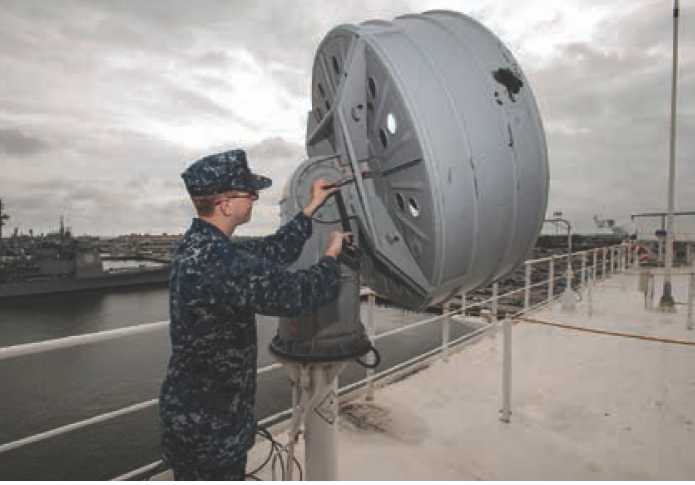
Commercial Satellite Communications (COMSATCOM)
Description
The Commercial Satellite Communications program augments military satellite communications capabilities in support of surface combatants and includes two elements: the new Commercial Broadband Satellite Program (CBSP) and the legacy Commercial Wideband Satellite Program (CWSP). CWSP will continue in the Fleet until replaced by CBSP. The CBSP terminal is the USC-69; the CWSP terminal is the WSC-8. The CBSP
USC-69 terminal has three variants for force-level, unit-level, and small ships. All terminal groups transport voice, video and data, e.g. NIPRNET (Non-secure Internet Protocol), SIPRNET (Secret Internet Protocol Router Network), JWICS (Joint Worldwide Intelligence Communications System), DCGS-N (Distributed Common Ground System-Navy), and other requirements. The CBSP program also includes the worldwide space segment and end-to-end architecture. The Navy use of Iridium on surface combatants is for emergency communications. Separate from the emergency communications requirement on ships, the Navy has more than 15,000 Iridium devices total that are used for various purposes at shore command locations and afloat to meet flow-bandwidth voice and video requirements.
Status
CBSP was established as a rapid deployment capability in March 2007, achieved program Milestone C September 2009, initial operational capability in June 2010, and full rate production in September 2011. The Navy expects full operational capability will be achieved in FY 2020. As of December 31, 2011, all ships reliant on INMARSAT transitioned to CBSP. The approved CBSP terminal objective is 177 ships. As of the end of FY 2016, 85 ships were operational with the CBSP terminal. The legacy CWSP WSC-8 will continue in the Fleet until replaced by the CBSP terminal in the FY 2019 timeframe.
Developers
CBSP: CVG, Inc. Chantilly, Virginia
CBSP/CWSP: Harris Corporation Melbourne, Florida
IRIDIUM: IRIDIUM, LLC McLean, Virginia
JEOD VSAT: L3 Communications Victor, New York
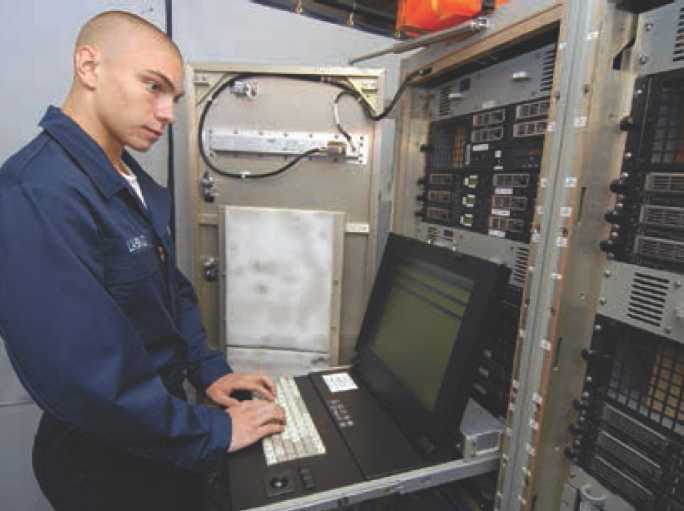
Consolidated Afloat Networks and Enterprise Services (CANES)
Description
Consolidated Afloat Networks and Enterprise Services is the Navy's program of record to replace existing afloat networks and provide the necessary infrastructure for applications, systems, and services required for the Navy to dominate the cyber warfare domain. CANES is the technical and infrastructure consolidation of existing, separately managed afloat networks including Integrated Shipboard Network Systems (ISNS), Combined Enterprise Regional Information Exchange System-Maritime (CENTRIXS-M), Sensitive Compartmented Information (SCI) Networks, and Submarine Local Area Network (SubLAN). CANES is replacing these legacy, obsolete afloat network designs. CANES provide capacity for enterprise information assurance management. It also reduces total ownership cost through consolidation and normalization of products and services while employing constant competition to enable efficient acquisition of new fleet requirements and capabilities.
The fundamental goal of CANES is to bring "Infrastructure as a Service" (IaaS) and "Platform as a Service" (PaaS), within which in-service and future iterations of Navy Tactical Network computing and storage capabilities will reside. CANES will provide complete infrastructure inclusive of hardware, software (including Agile Core Services for the Navy Tactical Cloud), processing, storage, and end-user devices for unclassified, coalition, secret, and sensitive compartmented information for all basic network services (email, web, chat, and collaboration) to a wide variety of Navy surface combatants, submarines, aircraft, maritime operations centers, and regional network operations and security centers. CANES will develop updates on a rolling four-year hardware baseline and a two-year software baseline.
CANES is based on the overarching concept of reducing the number of afloat network baselines and providing enhanced efficiency through a single engineering focus on integrated technical solutions. Navy-validated applications, systems, and services that use the CANES infrastructure and services include the Distributed Common Ground System-Navy, Global Command and Control System-Maritime, Naval Tactical Command Support System, and Undersea Warfare Decision Support System.
Status
CANES full deployment decision was achieved October 2015, authorizing the program to field the remainder of its target inventory objective. At the full deployment decision, milestone decision authority was delegated to the Assistant Secretary of the Navy for Research, Development and Acquisition, and the program was designated as an Acquisition Category IAC program. This decision was granted based on a successful initial operational test and evaluation on a unit level platform, and the system was declared as operationally effective, suitable, and survivable by Director, Operational Test and Evaluation. In late 2016, follow-on force-level plat
form test and evaluation was in progress on board the USS John C. Stennis (CVN 74) and expected to be completed in FY 2017. CANES is planned to reach full operational capability in FY 2023.
Developers
Naval Undersea Warfare Center Newport, Rhode Island
Space and Naval Warfare Systems
Center Atlantic Charleston, South Carolina
Space and Naval Warfare Systems
Center Pacific San Diego, California
* * * * * * * * * * * *
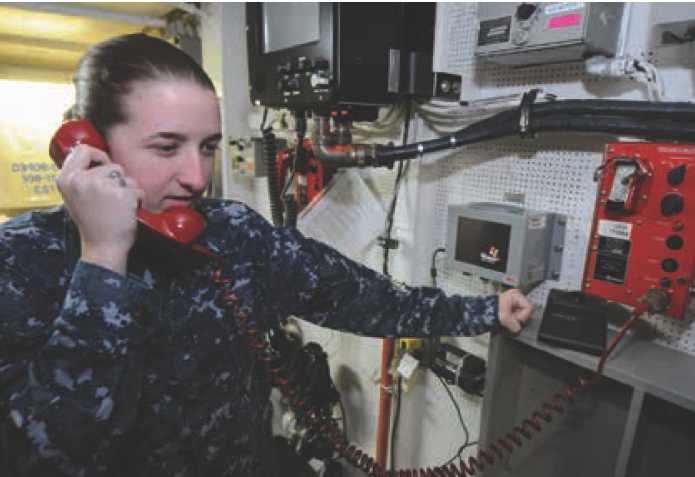
Defense Red Switch Network (DRSN)
Description
The Defense Red Switch Network is the secure circuit-switched element of the Defense Information System Network, providing reliable and high-quality secure voice, data, and conferencing capabilities to senior national, combatant commander, and fleet commander decision-makers. The DRSN program ensures that operational commanders have immediate access to a flash-precedence, robust, multi-level secure, physically diverse, and survivable voice network. The Department of Defense and select federal agencies have a continuing operational requirement for a separate, controlled, and interoperable multi-level secure communications and conferencing network to support command, control, and crisis-management activities. The DRSN capability satisfies that requirement and comprises a network of circuit switches interconnected by the DISN backbone and commercial transmission links as well as gateway access to the voice over secure internet protocol network.
Status
As assigned by the Joint Staff, the Navy has responsibility for operations and maintenance of five switches in the DRSN network: (1) Joint Staff Detachment (Former Commander, Joint Forces Command, Norfolk, Virginia); (2) Commander, Pacific Command (Camp H.M. Smith, Hawaii); (3) Commander, Pacific Fleet (Pearl Harbor, Hawaii); (4) Commander, Naval Forces Europe (Naples, Italy); and (5) Commander, U.S. Naval Forces Central Command (Manama, Bahrain). The Fleet Cyber Command is responsible for personnel, training, logistics, security and accreditation, and command policy for DRSN assets under Navy operational control.
Developers
Raytheon Waltham, Massachusetts
* * * * * * * * * * * *
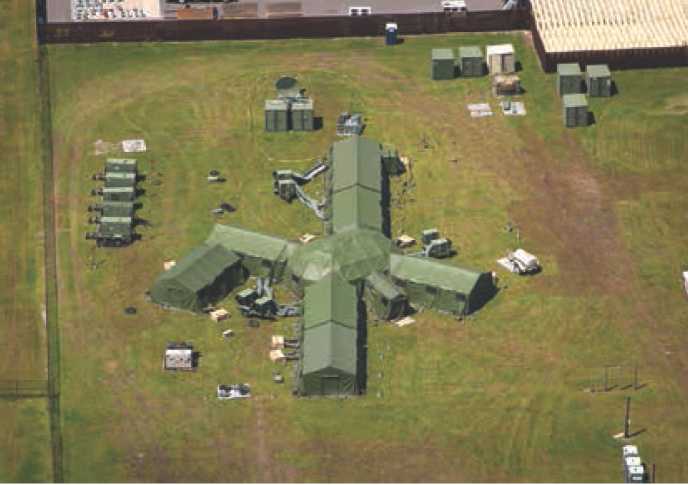
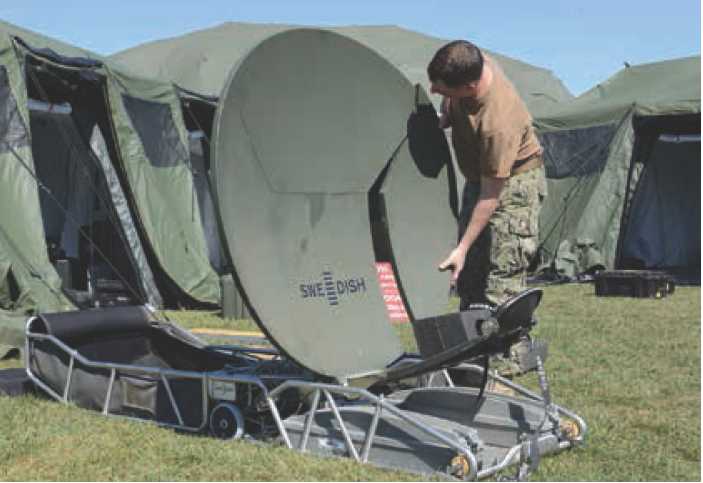
Deployable Joint Command and Control Capability (DJC2)
Description
The Deployable Joint Command and Control program provides a standardized, rapidly deployable, scalable, and reconfigurable C2 and collaboration capable combat operations center that can be set up anywhere in the world in six-to-24 hours after arrival in theater to support geographic combatant commanders and their joint component commands in the rapid standup of a joint task force (JTF) headquarters. DJC2 can be employed when executing operations ranging in scale from a first responder or small early-entry, forward-component operations center to a full JTF headquarters. DJC2 extends the joint sea base ashore for rapid, dynamic joint operations.
DJC2 has been used for humanitarian-assistance and disaster-response operations, including: Operation Damayan after Typhoon Haiyan in the Philippines; Superstorm Sandy relief in New Jersey and New York; Operation Tomodachi after the earthquake and tsunami in Japan; JTF Unified Response after the earthquake in Haiti; JTF Caring Response after Cyclone Nargis in Myanmar; and JTF Katrina after Hurricane Katrina in New Orleans, Louisiana. Additionally, the systems are used extensively for JTF headquarters joint exercises and training.
The DJC2 system has three modular tent/mobile shelter configurations, which iteratively build up C2 capability during the phases of a joint operation. Configurations include: an autonomous Rapid-Response Kit (five to 15 seats); Early Entry (20 to 40 seats); and Core (60 seats). An Early Entry configuration can be set up and operational with three networks and communications in less than six hours. The fully fielded DJC2 configuration in a footprint of approximately 40,000 square feet can be set up and operational with five networks in less than 24 hours. The number of users supported can be expanded by lashing together two or more Cores, or by adding Core Expansion Kits (three available, adding 60-seats each, 180 total). A fully fielded DJC2 includes self-generated power, environmental control, shelters (tents), infrastructure, limited communications equipment, C2 applications, and Office automation and collaboration software applications with operator workstations (laptop computers, chairs, and tables), displays, intercommunications, local-area networks, and access to wide-area networks.
Status
In September 2008, the DJC2 program attained full operational capability with the delivery of six operational Core systems to: the U.S. Southern Command (SOUTHCOM), two Core systems, with one transferred to U.S. Army South; U.S. European Command (EUCOM); U.S. Pacific Command (PACOM), two Core systems, with one transferred to III Marine Expeditionary Force; and U.S. Africa Command (AFRICOM). A seventh system was provided to Naval Forces Central Command (CENTCOM) in support of an urgent operational needs statement and their continuity of operations plan requirements. In October 2016, three of the six DJC2s transferred custody to Joint Communications Support Element, U.S. Transportation Command, from SOUTHCOM, AFRICOM, and EUCOM. Two are held at MacDill Air Force Base and one at Ramstein AFB. Programmed funding supports hardware sustainment, information technology refresh, and technology-insertion efforts (based on warfighter input as technologies mature) across the future years defense program. The DJC2 program is in the operations and support phase and has successfully fielded several cycles of technology insertion (delivered in "spirals") since September 2008. Because of its open architecture and modular design, the DJC2 system can be reconfigured to meet a wide variety of form/fit/functions.
Developers
ARINC Panama City, Florida
Georgia Tech Research Institute Atlanta, Georgia
ISPA Technology Panama City, Florida
Naval Surface Warfare Center Panama City, Florida
* * * * * * * * * * * *
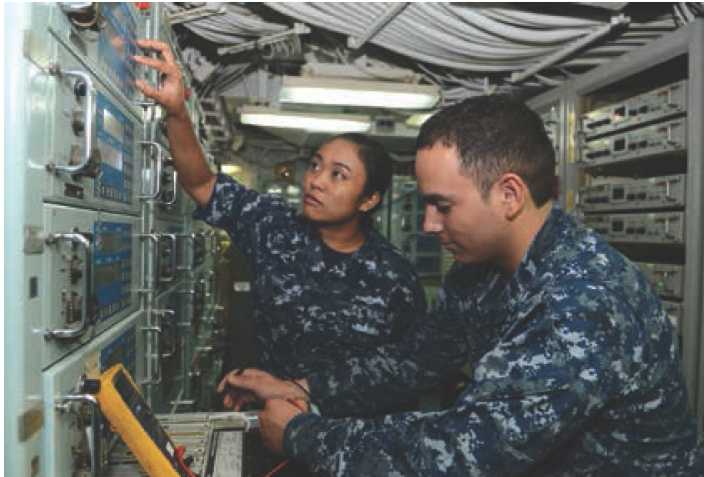
Digital Modular Radio (DMR)
Description
The USC-61(C) Digital Modular Radio is the Navy's first software-defined radio to have become a communications system standard for the U.S. military. DMR has four independent, full-duplex channels that provide surface ships, submarines, and shore commands with multiple waveforms and associated internal multilevel information security for voice and data communications. A single DMR is capable of replacing numerous existing Navy and Coast Guard legacy radios in the high frequency, very high frequency, and ultra-high frequency (UHF) line-of-sight and UHF satellite communications (SATCOM) frequency bands. The DMR is software configurable and programmable with an open system architecture using commercial off-the-shelf/non-developmental item hardware. DMR is the Navy's primary solution for providing the UHF SATCOM Integrated Waveform (IW) and Mobile User Objective System (MUOS) waveform to the Fleet.
Status
The Navy has procured 645 DMR systems through FY 2016. The DMR is installed on various platforms, including the Nimitz (CVN 68)-class aircraft carriers, Arleigh Burke (DDG 51)-class guided missile destroyers, the Makin Island (LHD 8) and America (LHA 6) amphibious assault ships, San Antonio (LPD 17)-class amphibious transport dock ships, Lewis and Clark (T-AKE)-class ships, submarines as part of the common submarine radio room, and select shore communications stations. DMR is the Navy and Coast Guard's radio/terminal solution for implementing the IW and MUOS waveforms. For Navy new construction, DMR is also used to provide an HF capability as part of the High-Frequency Distribution Amplifier Group (HFDAG). With the introduction of IW, MUOS and HFDAG, DMR is the Navy's complete tactical communication solution for the radio-frequency spectrum from 2 MHz through 2 GHz. IW/MUOS-capable DMRs are planned to start fielding in FY 2017.
Developers
General Dynamics Scottsdale, Arizona
* * * * * * * * * * * *
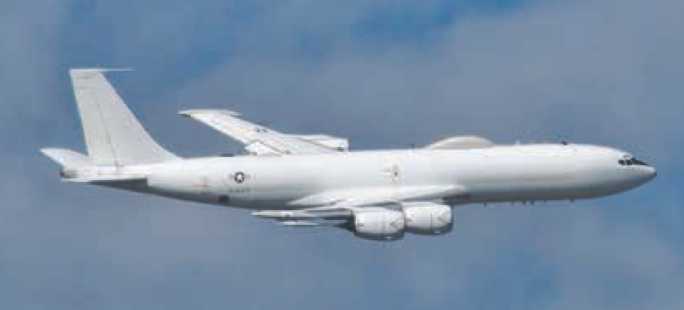
E-6B Mercury
Description
Derived from the Boeing 707, the E-6B platform provides the Commander, U.S. Strategic Command (USSTRATCOM), with the command, control, and communications capability needed for execution and direction of strategic-nuclear forces. Designed to support a robust and flexible nuclear deterrent posture well into the 21st Century, the E-6B performs very flow frequency (VLF) emergency communications, the U. S. Strategic Command airborne command post mission, and airborne launch control of ground-based inter-continental ballistic missiles. It is the Navy's only survivable means of nuclear command and control (C2).
Status
The Block I modification program will sustain and improve E-6B capability and is focused on several aircraft deficiencies identified by USSTRATCOM. The contract for Block I was awarded to Rockwell Collins in March 2004, and became operational in 2013 with the last Block I modification scheduled for completion in 2019. In March 2012, the Navy awarded to Northrop Grumman the contract for Multi-Role Tactical Common Data Link (MR-TCDL) integration and installation into one E-6B aircraft and the E-6B Systems Integration Lab. The Internet Protocol and Bandwidth Expansion (IP/BE), MR-TCDL, and Family of Advanced Beyond Line-of-Sight Terminal/Presidential National Voice Conferencing (FAB-T/PNVC) programs will support USSTRATCOM's migration of nuclear C2 to a distributed, network/internet protocol-based global C2 system as an airborne node. Planned initial operational capabilities for MR-TCDL and FAB-T/PNVC programs are in 2018 and 2019, respectively.
Developers
The Boeing Company Wichita, Kansas
Northrop Grumman Herndon, Virginia
Rockwell Collins Richardson, Texas
* * * * * * * * * * * *
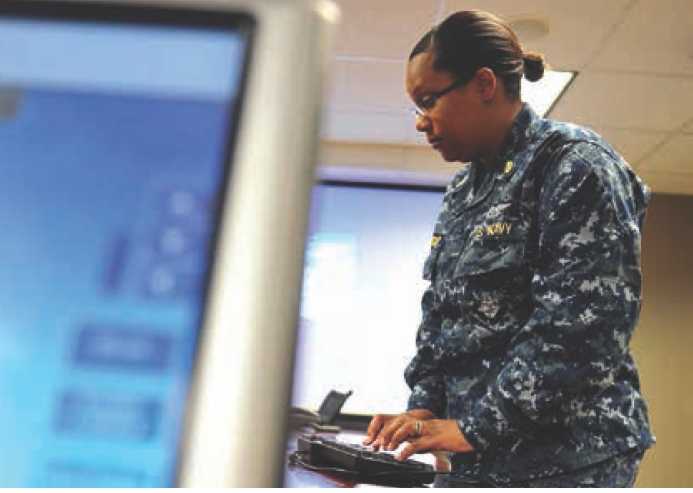
Enterprise Services
Description
Enterprise Services establish Navy's enterprise-level information technology (IT) services that provide opportunities and enhance user capabilities to meet Navy needs while increasing security and achieving cost efficiencies. Enterprise Services provide the capabilities to manage and deliver the Navy's IT services centrally, enabling it to: reduce total ownership costs; promote information sharing and interoperability in the Department of the Navy (DoN) and Department of Defense (DoD); ensure compliance with DoD and congressional IT mandates; and significantly improve the Navy's information assurance posture. This allows seamless access to resources no matter where they connect to the Navy or DoD. Initial efforts in Enterprise Services focus on consolidating data centers, as well as establishing enterprise software licensing agreements. Managing services at the enterprise level provides an opportunity to eliminate stovepipe systems that do not communicate with each other and enhances the Navy warfighters' capability to access mission-critical information. The DoN has made significant progress eliminating legacy networks, servers, systems, applications, and duplicative data environments. These Enterprise Services will be leveraged across the DoN and joint partners to provide seamless connectivity to mission-critical information. Future technological demands warrant higher levels of interoperability with our joint partners and allies to achieve operational efficiency and success. Enterprise Services are critical enablers to help the DoN achieve its information warfare strategy offering significant advantages operationally while enhancing our cyber security posture.
Status
The Navy is in the process of consolidating its data centers dispersed throughout the continental United States. The Navy Data Center Consolidation (DCC) initiative is leveraging DoN, Space and Naval Warfare Systems Command, Defense Information Systems Agency, commercial data centers and Cloud service providers to provide enterprise capabilities to satisfy system, application, and database hosting requirements for the Navy. The Navy is engaged in implementing various IT infrastructure modernization and cost saving consolidation initiatives in preparation for transitioning to the joint information environment. In addition to DCC, the Navy is actively engaged in other IT efficiency efforts, including enterprise software licensing (ESL), Navy portal consolidation, help desk consolidation, and application rationalization. The Navy established enterprise service license agreements with major software manufacturers and continues to analyze requirements for software applications used throughout the DoN to generate further efficiencies. ESL is a strategic effort to leverage the combined buying power of the Navy and Marine Corps to improve the DoN's IT/cyberspace investment decision practices by providing DoN enterprise-level evaluation and management.
Developers
Multiple sources.
* * * * * * * * * * * *
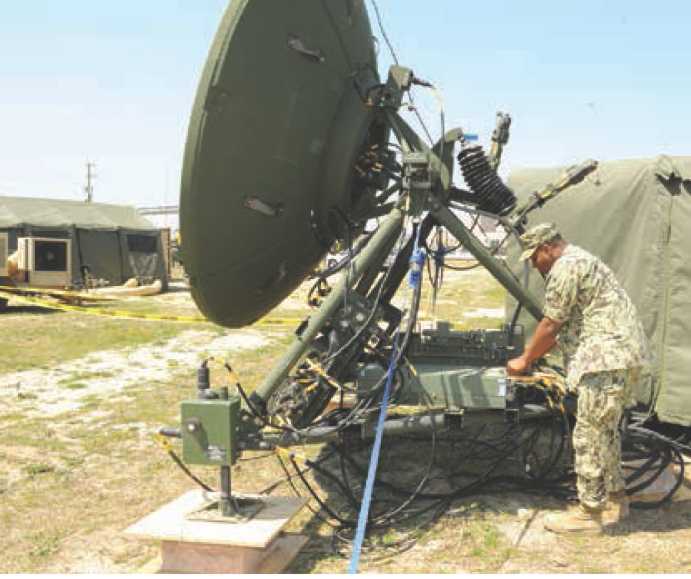
Global Broadcast Service (GBS)
Description
The Global Broadcast Service is a military satellite communications (MILSATCOM) extension of the global information grid that provides worldwide, high-capacity, one-way transmission of voice, data, and video supporting fleet command centers and joint combat forces in garrison, in transit, and deployed to global crisis and combat zones. Specific products include unmanned aerial vehicle feeds, imagery, intelligence, missile-warning, weather, joint and service-unique news, education, training, video, and various other high-bandwidth services. GBS is a joint Acquisition Category (ACAT) 1 program overseen by the Air Force, and Navy GBS is an ACAT 3 program that aligns to joint development. GBS interfaces with other communications systems in order to relieve overburdened and saturated satellite networks and provide information services to previously unsupportable (due to flow bandwidth) users. It provides fleet and strike group commanders the highest broadband data rate available afloat, up to 23.5 megabits per second (mbps) per channel on ultra-high-frequency follow-on satellites and 45 mbps with the Wideband Global SATCOM constellation. GBS also enables critical delivery of information products required to provide assured command and control in crisis and combat environments.
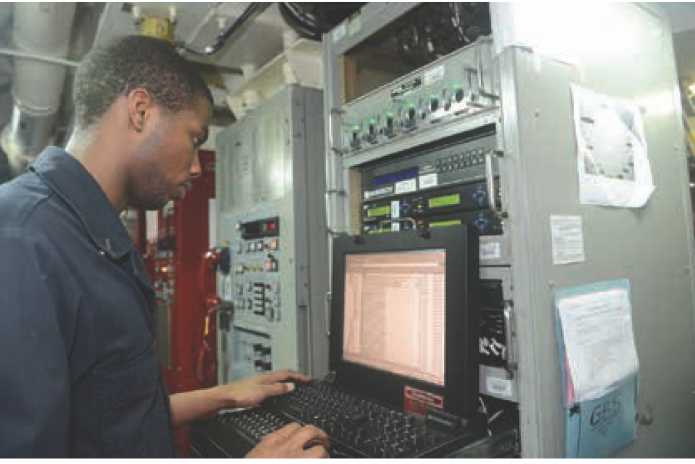
Status
Navy GBS is fully deployed and is undergoing sustainment and improvement efforts. Architectural enhancements permit improved sharing and reallocation of broadcast coverage and bandwidth between users, information products, media types, and security levels. Worldwide SIPRNET (Secret Internet Protocol Router Network) Split Internet Protocol capability was established on all GBS-equipped platforms in FY 2011, enabling users to request real-time data via an alternate off-ship system for delivery via GBS and significantly enhancing the warfighter's situational awareness. Sustainment efforts include the upgrade of the Receive Broadcast Manager GBS application software and the shift to a Digital Video Broadcasting-Satellite-Second Generation (DVB-S2) transmission security-enabled broadcast architecture using a standardized modem to replace in-service integrated receiver decoders. All cruisers and destroyers will be equipped with GBS by FY 2021, with installations concurrent with the AN/W SC-9 Navy Multiband Terminal that will provide the antenna for GBS.
Developers
Raytheon Reston, Virginia
Space and Naval Warfare Systems Command
PEO C4I and PMW/A 170 San Diego, California
USAF Space and Missile Systems Center El Segundo, California
* * * * * * * * * * * *
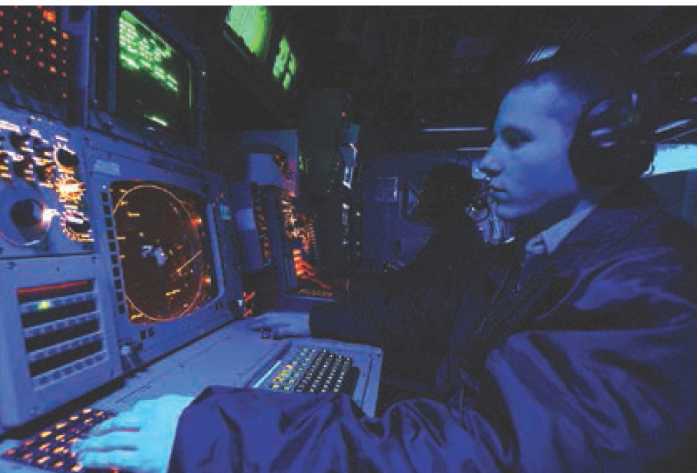
Global Command and Control System-Maritime (GCCS-M)
Description
Global Command and Control System-Maritime is the maritime implementation of the Department of Defense GCCS family of systems. It supports decision making at all echelons of command with a single, integrated, scalable C4I (command, control, communications, computers, and intelligence) system. The C4I system fuses, correlates, filters, maintains, and displays location and attribute information on friendly, hostile, and neutral land, sea, and air forces, integrated with available intelligence and environmental information. It operates in near real-time and constantly updates unit positions and other situational-awareness data. GCCS-M also records data in databases and maintains a history of changes to those records. System users can then use the data to construct relevant tactical pictures using maps, charts, topography overlays, oceanographic overlays, meteorological overlays, imagery, and all-source intelligence information coordinated into a common operational picture that can be shared locally and with other sites. Navy commanders review and evaluate the general tactical situation, plan actions and operations, direct forces, synchronize tactical movements, and integrate force maneuver with firepower. The system operates in a variety of environments and supports joint, coalition, allied, and multinational forces. GCCS-M is implemented afloat and at select ashore fixed command centers.
Status
The GCCS-M program is designated an Acquisition Category IAC evolutionary acquisition program, with development and implementation progressing in increments. The acquisition strategy calls for each GCCS-M increment (major release) to proceed through acquisition milestone reviews prior to fielding. The program is operating in two simultaneous acquisition increments: Increment 1 (GCCS-M Version 4.0 and prior) is in sustainment; and Increment 2 (GCCS-M Version 4.1) completed a fielding decision review (FDR) on August 16, 2011, resulting in authorization of full fielding of Increment 2 force-level (e.g., aircraft carriers) and unit-level (e.g., guided-missile cruiser) configurations. The Increment 2 group-level configuration completed FDR in December 2014 and full fielding is in progress. Full operational capability is expected in 2023. As of August 2016, the following software variants are in the Fleet: 3.x (1 ship); 4.0.2 (10 ships/9 shore); 4.0.3 (87 ships/44 subs/4 shore); and 4.1 (64 ships/28 subs/9 shore). GCCS-M includes efforts necessary to ensure synchronization and interoperability with the GCCS family of systems.
Developers
Space and Naval Warfare
Systems Center San Diego, California
* * * * * * * * * * * *

Information Systems Security Program (ISSP)
Description
The Navy's Information Systems Security Program ensures protection of Navy and joint cyberspace systems from exploitation and attack. Products and capabilities are provided through development, testing, certification, procurement, installation, and lifecycle support of network and host-based security products and systems. ISSP includes computer network defense (CND), communication security/cryptography, key management infrastructure (KMI), public key infrastructure, cybersecurity services, SHARKCAGE, and Navy cyber situational awareness. Cyberspace systems include wired and wireless telecommunications systems, information technology systems, and the content processed, stored, or transmitted therein. The ISSP includes protection of the Navy's National Security Systems and Information implementation, and provides for procurement of secure communications equipment for Navy and Military Sealift Command ships, shore sites, and aircraft, and Marine Corps and Coast Guard assets. This program also provides cybersecurity capabilities to protect information systems from unauthorized access or unauthorized modification and against the denial of service to authorized users.
Technologies provide greatly improved cyber threat intelligence and situational awareness from external boundaries to tactical edge infrastructures while reducing the complexities of monitoring, assessing, and detecting adversary activities across multiple enclaves. Cybersecurity programs comprise a layered protection strategy using commercial off-the-shelf and government off-the-shelf hardware and soft-ware products that collectively provide multiple levels of security mechanisms to detect and react to intrusions and assure the confidentiality and integrity of information. Cybersecurity is critical in protecting our ability to wage network-centric warfare and in protecting the entire naval cyberspace domain that includes mobile forward-deployed subscribers, shore information infrastructures, and interconnections with other cyberspace domains. Effective cybersecurity capabilities must evolve quickly to meet rapidly evolving advanced threats and new vulnerabilities. The Navy's ISSP will continue to provide tools, technology, cryptographic equipment, security products, operations, people, and services in alignment with the Department of Defense Cybersecurity Program.
Status
The Navy's ISSP is a collection of related abbreviated acquisition programs and projects that provide the full spectrum of cyber-security capabilities. These programs are in various phases of the acquisition process, from concept development through capability sustainment. The ISSP provides Navy warfighters the essential information security characteristics of availability, confidentiality, integrity, authentication, and non-repudiation. CND Increment 2 reached initial operational capability (IOC) in FY 2012 and full operational capability (FOC) in FY 2016. KMI Spiral 2 reached IOC in FY 2016, with FOC scheduled for FY 2018. VINSON/ANDVT (Advanced Narrowband Digital Voice Terminal) Cryptographic Modernization (VACM) reached IOC in FY 2016.
Developers
Georgia Tech Research Institute San Diego, California
MITRE San Diego, California
Raytheon Largo, Florida Space and Naval Warfare
Systems Center Atlantic Charleston, South Carolina
* * * * * * * * * * * *
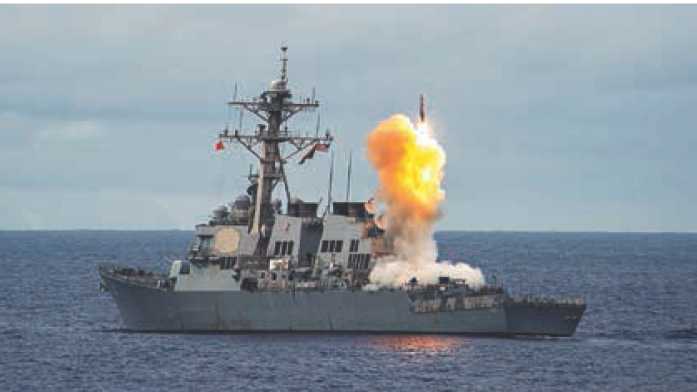
Integrated Broadcast Service / Joint Tactical Terminal (IBS/JTT)
Description
The Integrated Broadcast Service is an integrated, interactive dissemination system that provides Navy commanders and forces with real-time/near-real-time all-source, multiple-intelligence, intelligence, information, and data allowing for continuous prior-to-mission execution; indications and warning, strategic and threat warning/intelligence, tactical warning and intelligence, time-sensitive targeting, and situational awareness during mission execution; and post-mission assessment and analysis. Legacy IBS will migrate into the Joint Service IBS Common Interactive Broadcast (CIB) waveform incorporating the Common Message Format (CMF). The IBS will send data via communications paths such as ultra-high frequency satellite communications and networks over super-high-frequency, extremely high-frequency, and Global Broadcast Service. The JTT is a multi-channel transmit and receive radio with onboard capabilities to encrypt/ decrypt, filter, process, and translate the IBS data for shipboard use on tactical data processors. The Navy is upgrading in-service fleet inventory of JTT-Maritime systems to implement the CIB waveform and CMF, and demand assigned multiple access integrated waveform capabilities for improved bandwidth use.
Status
The Navy commenced initial shipboard installations of JTT in FY 2001, and 133 JTT-M systems have been fielded as of the end of CY 2016. In order to support the addition of new ships requiring access to near-real-time over-the-air IBS special intelligence, the Navy contracted with Raytheon Space and Airborne Systems to reopen the JTT-Senior production line. This met the increasing fleet, Aegis ballistic missile defense, and Aegis Ashore requirements before ending in FY 2016. The transition to the next-generation Common Interactive Broadcast services began in FY 2013 with the installation of JTT Upgrade Kits for legacy systems, procured from Raytheon via a joint-service contract.
Developers
IBS: L-3 Communications Fairfax, Virginia
JTT: Raytheon Systems St. Petersburg, Florida
* * * * * * * * * * * *

Maritime Operations Center (MOC)
Description
Navy maritime operations centers are a warfighting capability of the Navy component commander (NCC) and numbered fleet commander (NFC), organized, trained, manned, and equipped to support commanders' decision-making and set conditions for operational command and control (C2) of naval, joint, interagency, and combined forces. MOCs ensure the Navy's C2 capabilities at the operational level are manned by individuals proficient in joint and naval operational-level staff processes and equipped to provide globally networked, standardized, scalable, and flexible capability across the spectrum of operations. MOCs provide organizational consistency, scalability, and flexibility to transition between various command roles, and enhanced global networking among Navy-maritime organizations. The MOC construct sustains effective, agile, networked, and scalable staffs, employing a standardized system of command, control, communications, computers, intelligence, surveillance, and reconnaissance systems, in accordance with common doctrine and processes. Each MOC supports its NCC/NFC tasked with command and control of Navy and joint forces in joint, interagency, and combined roles. The global network and standardized Core Baseline with Mission Build (CB/MB) systems and applications that enable both reach-back and load sharing between MOCs. Education provided via the Maritime Staff Operators Course provides foundational knowledge in joint and naval operational-level processes and prepares personnel to perform Navy operational-level MOC functions. Training and assist teams from U.S. Fleet Forces Command and the Naval War College provide MOCs with on-site training and assessment and share best practices in order to maintain proficiency in and ability to execute critical staff processes.
Status
Eight Navy operational-level headquarters at nine locations are equipped with the initial MOC CB/MB material baseline. Key MOC baseline systems hardware and software capabilities have been fielded to U.S. Fleet Forces Command, Pacific Fleet, Third Fleet, Naval Forces Southern Command/Fourth Fleet, Naval Forces Central Command/Fifth Fleet, Naval Forces Europe/Africa/ Sixth Fleet (ashore and afloat), Seventh Fleet, and Fleet Cyber Command/ Tenth Fleet. Systems fielded to these MOC locations include the Combined Enterprise Regional Information Exchange System-Maritime, Air Defense System Integrator and Link Monitoring and Management Tool, Radiant Mercury, Maritime Integrated Air and Missile Defense Planning System, Command and Control Battle Management and Communications System, Command and Control Personal Computer, Distributed Common Ground System-Navy, Joint Automated Deep Operations Co-ordination System, Theater Battle Management Core System, and Global Command and Control System-Joint. Support and program wholeness depend on multiple suppliers, joint and Navy programs of record across several interconnected requirements and resource seams.
Developers
DRS Tinker AFB, Oklahoma
Rockwell Collins Richardson, Texas
* * * * * * * * * * * *
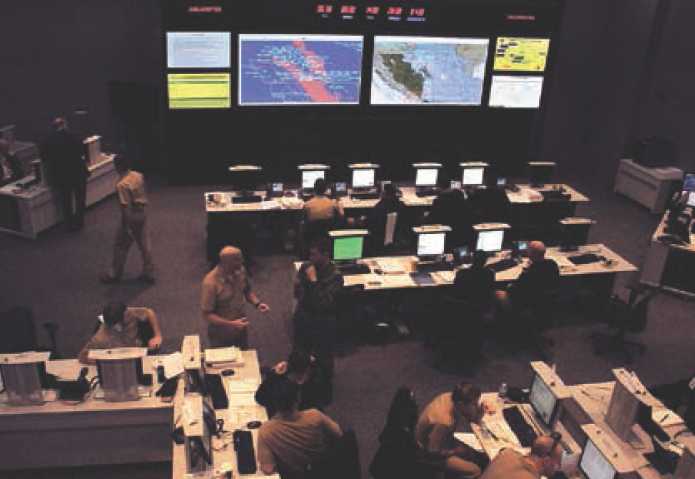
Maritime Tactical Command and Control (MTC2)
Description
Maritime Tactical Command and Control is the next generation maritime command and control (C2) software-only solution and the follow-on to the Global Command and Control System-Maritime (GCCS-M) program of record. It provides tactical C2 capabilities and maritime unique operational level of war capabilities not supported by the joint C2 effort. MTC2 will leverage the Integrated Shipboard Network System (ISNS), Consolidated Afloat Networks Enterprise Services (CANES), Afloat Core Services (ACS), Next-Generation Enterprise Network (NGEN), and the Navy Tactical Cloud (NTC). MTC2 will retain capability of GCCS-M 4.1 system while ultimately providing a suite of C2 maritime applications as part of an "application store" concept that enables enhanced situational awareness, planning, execution, monitoring, and assessment of unit mission tasking and requirements. MTC2 will greatly expand the scope of C2 functions across all Navy echelons, from the MOC level to maritime tactical units, afloat and ashore.
Status
MTC2 completed an analysis of alternatives in the third quarter of FY 2013, with the recommendation to satisfy maritime C2 requirements, as defined in the MTC2 Initial Capabilities Document, with the addition of leveraging NTC as an expanded data source. In FY 2014, MTC2 was directed to realign the development and implementation strategy to field in alignment with CANES, Distributed Common Ground System-Navy Inc.2, and Naval Integrated Tactical Environmental System Next (NITES NEXT). An initial build decision is anticipated in FY 2017.
Developers
Space and Naval Warfare
Systems Center Pacific San Diego, California
* * * * * * * * * * * *
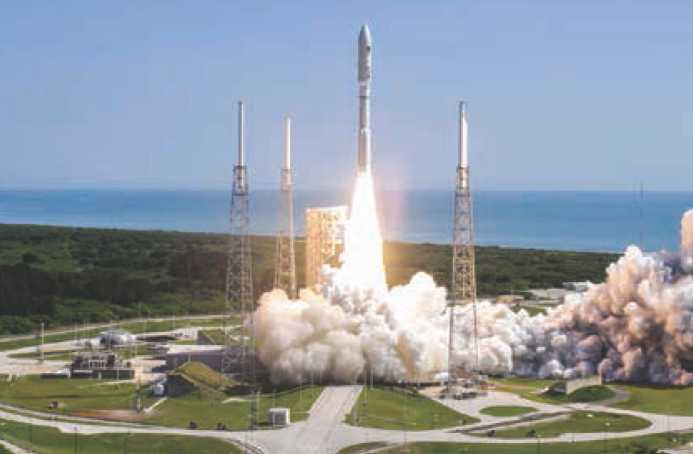
Mobile User Objective System (MUOS)
Description
The Mobile User Objective System is a next-generation narrowband tactical communications system that improves communications for U.S. forces on the move. The Navy is responsible for providing narrowband satellite communication for the Department of Defense (DoD). Each Service is responsible for procurement of MUOS-capable terminals. In addition to providing reliable communication for all branches of the U.S. military, Navy-delivered space-based narrowband capability provided by MUOS also supports reliable worldwide coverage for national emergency assistance, disaster response, and humanitarian relief when these missions are properly equipped and operated within the bounds of information-assurance policies.
MUOS satellites have a legacy ultra-high-frequency (UHF) payload that provides replacement capability similar to legacy UHF satellites, as well as a new MUOS wideband code division multiple access payload that will provide a significant improvement to the number of simultaneous voice and data services required to meet growing warfighter needs.
The MUOS constellation will consist of five geo-synchronous satellites, one of which is an on-orbit spare. The system also includes four ground stations strategically located and interconnected around the globe to provide worldwide coverage and the ability to connect users to DSN (Defense Switch Network), NIPRNET (Non-secure Internet Protocol), and SIPRNET (Secret Internet Protocol Router Network) services. The ground system transports data, manages the worldwide network, and controls the satellites. The MUOS design leverages commercial technology, providing worldwide netted, point-to-point, and broadcast services of voice, video, and data. Target users are unified commands and joint task force components, DoD and non-DoD agency mobile users that require communications on the move, and allied and coalition legacy users. Legacy narrowband communication system users have to be stationary with an antenna up and pointed toward a satellite. MUOS will provide more than ten times the worldwide capacity and allow the warfighter to move around the battlespace while communicating.
Status
MUOS was designated a DoD major acquisition program in September 2004. Key decision point Milestone C occurred in August 2006, and build approval was granted in February 2008. The first satellite was launched in February 2012 and was accepted for initial operational use supporting legacy terminal users in November 2012. All satellites have been launched with four of five in their final orbital slots. MUOS completed the multi-service operational test and evaluation-2 in April 2016 and has entered an early use period. It provides military users simultaneous voice, video, and data capability by leveraging third-generation mobile communications technology. The MUOS constellation is expected to achieve full operational capability in FY 2019, extending narrowband availability beyond 2028.
Developers
Boeing El Segundo, California
General Dynamics Scottsdale, Arizona
Lockheed Martin Sunnyvale, California
* * * * * * * * * * * *
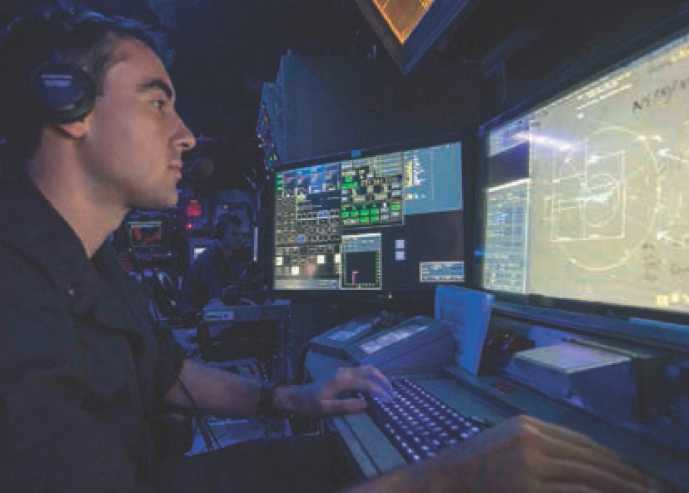
Navy Air Operations Command and Control (NAOC2)
Description
Navy Air Operations Command and Control program provides task force commanders the ability to plan, disseminate, monitor, and execute theater air battles. NAOC2 capability is provided by the Theater Battle Management Core Systems (TBMCS). TBMCS is an Air Force Acquisition Category III program of record with joint interest. TBMCS is integrated and fielded to enable the air planner to produce the joint air tasking order and air space control order, which give afloat battle staffs and maritime operations centers the capability to lead, monitor, and direct the activities of assigned or attached forces during large-scale combined joint service operations with a joint force air and space component commander (JFACC).
Status
TBMCS 1.1.3 is in the operations and sustainment phase. Software and security upgrades are fielded as they become available. The NAOC2 program is integrated and tested within the Navy operational environment for fielding to force-level ships (e.g., aircraft carriers, amphibious assault ships, and command ships), maritime operations centers, and selected training sites. The Air Force's Command and Control Air and Space Operations Suite and Command Control and Information Services programs of record will replace TBMCS. The Air Force will develop these programs in a service-oriented architecture environment, and the Navy will migrate into these programs, which will reside in the Consolidated Afloat Networks and Enterprise Services environment.
Developers
Lockheed Martin Colorado Springs, Colorado
Space and Naval Warfare Systems Center Pacific San Diego, California
* * * * * * * * * * * *
Navy Multi-band Terminal (NMT)
Description
The Navy Multi-band Terminal will be the Navy's primary means of transporting a variety of protected and wideband command, control, and communications (C3) application data (e.g., secure voice, imagery, data, and fleet broadcast systems). It is replacing the USC-38/Follow-on Terminal (FOT) and the WSC-6 super-high-frequency satellite communications (SHF SATCOM) terminals on Navy ships, submarines, and shore stations. It provides access to new MILSATCOM-protected and wideband services provided by the Advanced Extremely High Frequency (EHF) and Wideband Global SATCOM (WGS) satellites. It also increases the number of user accesses and offers increased protected and wideband throughput. NMT enhances space resiliency with improved protected SATCOM capabilities and an anti-jam path through the addition of an SHF wideband anti-jam modem to the program. It is a key element of the Navy's mitigation of warfighting C3 concerns and is an enabler of the ballistic missile defense mission.
The NMT is more reliable with a 22 percent greater designed reliability than predecessor systems. A completely redesigned user interface makes operator-use easier with 85 percent fewer steps in operator terminal interactions. The terminal lowers fleet operating cost by reducing number of parts and terminal footprint on board ships. NMT-equipped units will be able to access military EHF and SHF SATCOM satellites, including protected SATCOM services available on Advanced EHF, Milstar, EHF payloads on board ultra-high-frequency follow-on satellites, Interim and Enhanced Polar EHF payloads. It provides wideband service using the Wideband Global Service and Defense Satellite Communications System satellites. Three international partners—Canada, the Netherlands, and the United Kingdom—are procuring a variant of the NMT. In addition, the Department of Defense Teleport and Enhanced Polar SATCOM system programs have procured NMTs to provide fleet units with shore reach-back capabilities.
Status
On November 8, 2012, NMT entered full-rate production status. As of July 2016, 223 of an objective 250 terminals had been placed under contract. Installations began in February 2012 with 132 ship, submarine, and shore installations completed as of July 2016.
Developers
Raytheon Marlborough, Massachusetts
* * * * * * * * * * * *
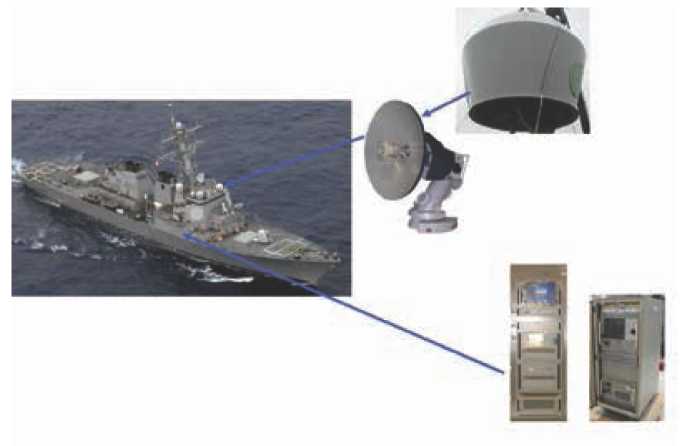


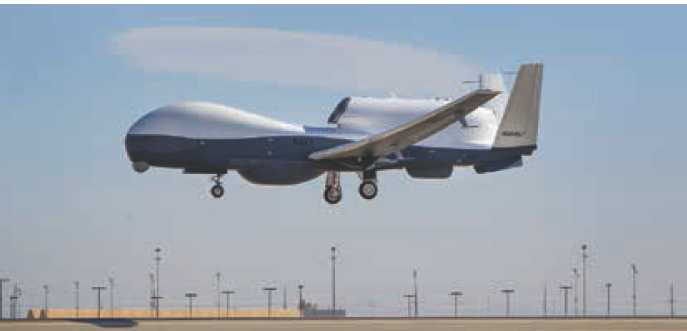
Network Tactical Common Data Link (NTCDL)
Description
Navy Common Data Link systems on force-level ships (e.g., aircraft carriers and amphibious assault ships) include the Network Tactical Common Data Link and its predecessor, the Communications Data Link System (CDLS), with Hawklink on unit-level ships (e.g., cruisers and destroyers) and other configurations on Littoral Combat Ships. NTCDL provides the ability to exchange command and control information and transmit/receive realtime intelligence, surveillance, and reconnaissance (ISR) information (voice, data, imagery, and full motion video) simultaneously from multiple sources (air, surface, sub-surface, and man-portable) across dissimilar joint, service, coalition, and civil networks. NTCDL provides warfighters the capability to support multiple, simultaneous, networked operations with in-service common data link (CDL)-equipped aircraft (e.g., P-3 Orion, P-8 Poseidon, and MH-60R Seahawk) in addition to next-generation manned and unmanned platforms (e.g., F-35 Joint Strike Fighter, MQ-4 Triton, MQ-25A Stingray, Small Tactical Unmanned Aircraft Systems, and MQ-8 Fire Scout). NTCDL is a tiered capability providing modular, scalable, multiple-link networked communications. NTCDL benefits the Fleet by providing horizon extension for line-of-sight sensor systems for use in time-critical strike missions, supports maritime superiority requirements through relay capability, and enhances tasking collection processing exploitation dissemination (TCPED) via its ISR networking capability. NTCDL will support multi-simultaneous CDL missions; provide capability for ship-ship, ship-air and air-air communication; facilitate download of ISR information to multiple surface commands (ship/shore); support unmanned aerial vehicles; and support TCPED architecture. NTCDL also supports humanitarian-assistance/disaster-relief efforts through its ability to share ISR data across dissimilar joint, service, coalition, and civil organizations.
Status
In December 2010, the Chief of Naval Operations directed a solution to address the Navy's requirement for multi-simultaneous CDL mission support within the future years defense program. The task was to replace the existing single, point-to-point shipboard CDLS with a multi-point networking system to support ISR transport. Initial investment in 2013 stood up the NTCDL program of record and funded the requirement for NTCDL on board aircraft carriers, with initial operational capability planned for 2019. Future investments will fund requirement for large-deck amphibious ships and develop multi-link NTCDL to meet requirements for use on aircraft, smaller ships, submarines, and shore-based handheld users and mobile platforms.
Developers
BAE Systems Arlington, Virginia
Cubic San Diego, California
Harris Corporation Melbourne, Florida
L3 Communications New York, New York
* * * * * * * * * * * *
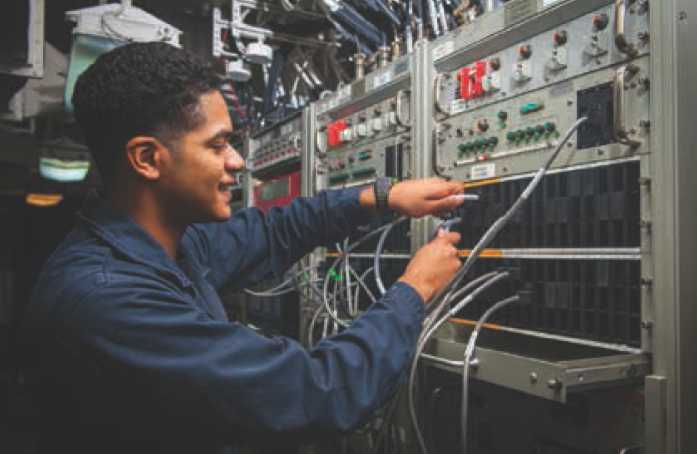
Next-Generation Enterprise Network (NGEN)
Description
NGEN is the service contract to operate the Navy-Marine Corps Intranet (NMCI) under a government-owned/contractor-operated model for Navy. NMCI is DoD's largest single network, delivering some 300,000 seats to more than 700,000 Navy users. NGEN includes the existing NMCI network and services; improves operational control, governance, security posture, and integrated operations capabilities; and supports alignment with DoD's joint information environment (JIE). This construct provides enhanced network command and control (C2), improved cybersecurity, and more flexibility. The NGEN program supports user access to protected voice, video, and data services over continental United States (CONUS) Navy ashore unclassified and classified networks. This provides the secure net-centric data and information technology services to the Navy and Marine Corps.
Status
The NGEN contract ends in June 2018. The Department of the Navy is working on the follow-on ashore IT enterprise contract, NGEN Re-compete. Under the new contract the Navy's outside of the U.S. enterprise will be merged with CONUS to standardize the ashore enterprise globally.
Developers
HP Enterprise Services Plato, Texas
* * * * * * * * * * * *
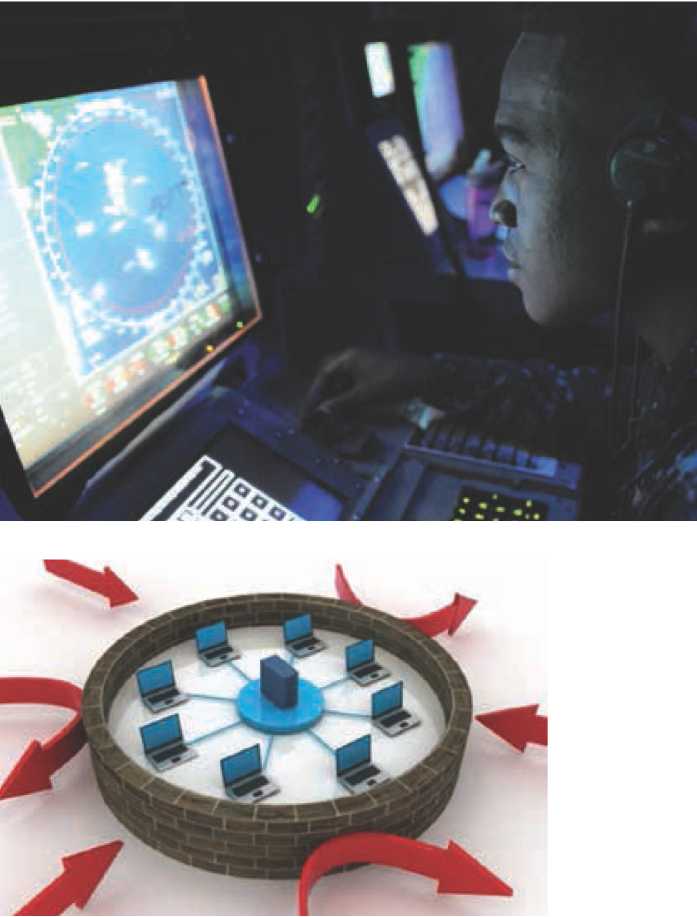
OCONUS Navy Enterprise Network (ONE-NET)
Description
The outside of the continental United States (OCONUS) Navy Enterprise Network (ONE-NET) provides the manpower and administration services to operate the Base Level Information Infrastructure (BLII) architecture, a fully integrated and interoperable network that consists of standard hardware, software, and information-assurance suites governed by operational and administrative policies and procedures. ONE-NET is the OCONUS equivalent to the Navy's CONUS-based enterprise services and is the medium that enables the rapid and reliable transfer of official classified and unclassified messages, collaboration, e-mail, and data. ONE-NET manpower provides information technology (IT) operations including e-mail, print, storage, directory, and Internet services, as well as help desk and enterprise management for approximately 28,000 seats, delivering vast performance and security improvements compared to legacy networks. ONE-NET manages the enterprise through three Theater Network Operation and Security Centers (TNOSCs) at Yokosuka, Japan; Naples, Italy; and Bahrain; in addition to 11 Local Network Support Centers (LNSCs) within their respective regions.
Status
The program provides IT services to approximately 28,000 BLII/ ONE-NET seats, supporting approximately 51,000 forward-deployed OCONUS Navy users. Fleet Cyber Command operates the three TNOSCs and 11 LNSCs servicing ONE-NET customers. The network is operated and maintained by a blended workforce of active duty, civilian, and contractor personnel. This program is expected to transition into the Next-Generation Enterprise Network follow-on contract by the end of FY 2018. This merger will realize efficiencies and standardization associated with a centrally managed program.
Developers
Computer Sciences Corporation Falls Church, Virginia
* * * * * * * * * * * *
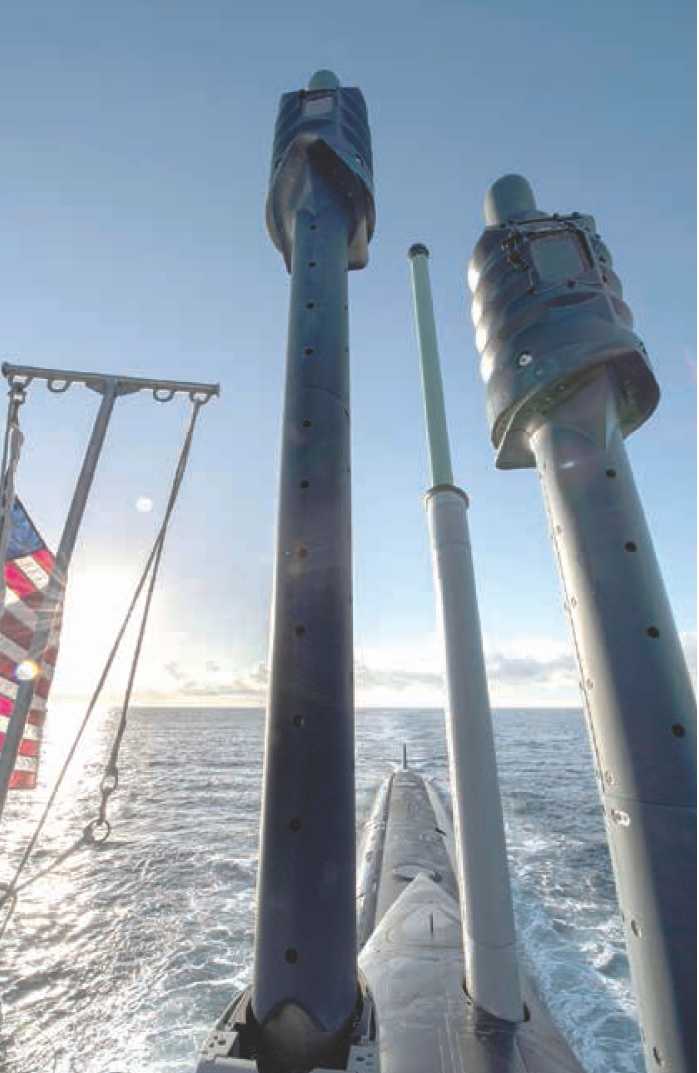
Submarine Communications Equipment
Description
The goal of the Submarine Communications Equipment program is to create a common, automated, open-system architecture radio room for all submarine classes. The program provides for the procurement and installation of systems incorporating the technical advances of network centric warfare to allow the submarine force to communicate as part of the strike group. It addresses the unique demands of submarine communications, obsolescence issues, and higher data rate requirements and includes two elements: common submarine radio room (CSRR) and submarine antennas.
CSRR is a network-centric communications gateway that supports interoperable communications and information warfare between on-board subsystems, external platforms, and land-based communications facilities and is interoperable with Department of Defense (DoD) infrastructure. CSRR comprises an open-architecture hardware and software approach for integrating government-off-the-shelf, commercial-off-the-shelf, and non-developmental item hardware and application-specific software into a common, centrally managed architecture. CSRR leverages existing Navy and DoD C4I (command, control, communications, computers, and intelligence) capability-based acquisition programs. CSRR allows common systems, software, and equipment to be installed on all submarine classes, use of common logistics products across all submarine classes, and the uniform training of personnel across all submarine classes, resulting in new capability at a reduced cost.
The submarine antennas programs support the development and sustainment of antennas designed to withstand the underwater environment. These antennas cover the frequency spectrum from very-flow-frequency to optical. Programs in the development phase include OE-538 Increment II Multi-function Mast, and Submarine High-Data-Rate (SubHDR) antenna. The improvements to the OE-538 Multi-Function Mast antenna support Mobile User Objective System, Link-16, Global Positioning System Anti-Jam, and Iridium capabilities. The SubHDR antenna is receiving improved radome and shock hardening.
Status
CSRR Increment I Version 3 began fielding in FY 2011 and is scheduled to complete in FY 2019. OE-538 Increment II achieved Milestone C decision in July 2015. SubHDR radome replacement began fielding in FY 2014.
Developers
Lockheed Martin Eagan, Minnesota
Lockheed Martin Sippican Marion, Massachusetts
Naval Undersea Warfare Center Newport, Rhode Island
Space and Naval Warfare Systems Center San Diego, California
* * * * * * * * * * * *

Super-High-Frequency Satellite Communications (SHF SATCOMS)
Description
The Super-High-Frequency Satellite Communications program includes: the WSC-6(V) 5, 7, and 9 terminals; the X-Band Kit Upgrade to the Extremely-High-Frequency Follow-On Terminal installed on submarines; and the enhanced bandwidth efficient modem installed on surface ships. The SHF SATCOM WSC-6 terminal is the primary SATCOM terminal in the Fleet, providing the bandwidth for voice, video, data, and imagery requirements for the warfighter, including NIPRNET (Non-secure Internet Protocol), SIPRNET (Secret Internet Protocol Router Network), JWICS (Joint Worldwide Intelligence Communications System), JCA (Joint Concentrator Architecture), video teleconferencing, and telephones. These SHF system terminals have been in the Fleet since the early 1990s and are in sustainment.
The Navy Multiband Terminal (NMT) WSC-9 is replacing the WSC-6 terminals. As of August 2016, 56 of 128 terminals have been replaced and an additional 55 terminals will be installed by 2024. Two of the terminals will not be replaced because their platforms will decommission prior to FY 2024. The remaining 15 terminals (LCS 02-16) have not yet been added to the NMT inventory objective for replacement.
Status
Program is in sustainment.
Developers
WSC-6(V) 5, 7: Raytheon Marlborough, Massachusetts
WSC-6(V) 9: Harris Melbourne, Florida
X-Band Kit Upgrade: Raytheon Marlborough, Massachusetts
* * * * * * * * * * * *
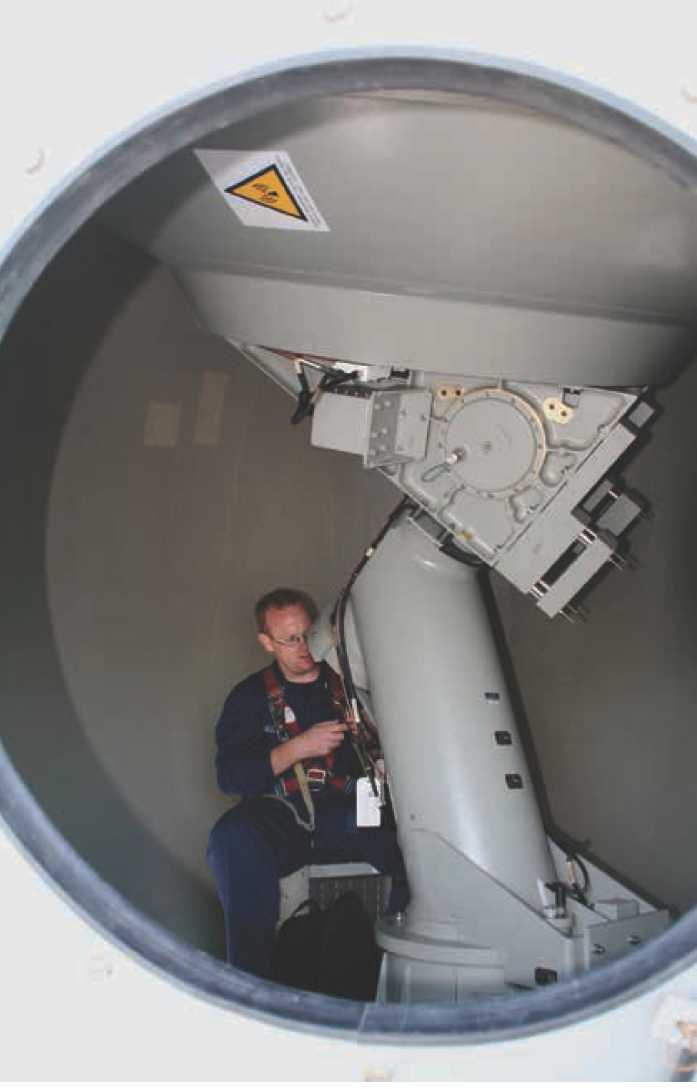

Tactical Messaging Description
Command and Control Official Information Exchange (C2OIX) provides the Navy with organizational messaging services and interfaces with the worldwide Department of Defense consumers, such as tactical deployed users, designated federal government organizations, and allies. C2OIX Afloat consists of the Navy Modular Automated Communications System (NAVMACS), a shipboard message processing system that guards broadcast channels and provides the only General Service Top Secret level communications path on and off the ship. C2OIX Shore provides the shore-messaging infrastructure via C2OIX Version 3.x at the Naval Computer and Telecommunications Area Master Stations (NCTAMS).
Status
The C2OIX project combined the Tactical Messaging (ACAT IVT) and the Defense Message System (DMS) (ACAT IVM) into a single service life extension project supporting all Navy messaging requirements, providing organizational C2 messages to shore, afloat, and mobile Navy users. Afloat component NAVMACS II is in the operations and sustainment phase to technically refresh all shipboard systems that lack support and adherence to in-place cyber security requirements. Shore components are in the operations and sustainment phase, and C2OIX is fielded on three enclaves (NIPR, SIPR and TS) at the NCTAMS, Atlantic and Pacific.
Developers
General Dynamics Taunton, Massachusetts
Scientific Research Corporation Charleston, South Carolina
* * * * * * * * * * * *

Tactical Mobile (TacMobile)
Description
The Navy Tactical Mobile program provides systems to support maritime commanders with the capability to plan, direct, and control the tactical operations of maritime patrol and reconnaissance forces (MPRF), joint and naval expeditionary forces, and other assigned units within their respective areas of responsibility. The TacMobile systems that support these missions are the tactical operations centers (TOCs) and mobile tactical operations centers (MTOCS). TOCs and MTOCs provide MPRF and aircraft (MPRA) operational support ashore at main operating bases, primary deployment sites and forward-operating bases that are similar to support provided on board an aircraft carrier to embarked tactical air wings. Support includes persistent situational operational and tactical awareness, MPRA pre-mission coordination and planning, mission and target briefings, tactical in-light support, post-mission analysis of collected sensor data, data dissemination, and feedback to aircraft sensor operators and supported commanders. Services provided include: analysis and correlation of diverse sensor information; data management support; command decision aids; data communication; mission planning, evaluation, and dissemination of surveillance data; and threat alerts to operational users ashore and afloat. As advances in sensor technology are fielded on MPRF/MPRA, TOC and MTOC sensor analysis equipment will evolve to support the new sensor capabilities.
Status
TacMobile Increment 2.1 full-rate production and fielding were authorized in November 2012 to field new capabilities incorporating P-8A Poseidon multi-mission maritime aircraft mission support, applications and systems interfaces as well as critical communications upgrades needed for TOCs and MTOCs to support P-8A intelligence surveillance and reconnaissance operations. Increment 2.1 achieved initial operational capability in October 2013 and reached full operational capability in FY 2016. Development is ongoing, and fielding is commencing to support P-8A Increment 2 engineering change proposals and MQ-4C Triton unmanned aircraft system to achieve more efficient information flow across the Navy's sensor grid through implementation of tactical service-oriented architecture enabled by the global information grid. Joint Capabilities Integration and Development System documentation will identify requirements for Increment 3 to support P-8A and MQ-4C multi-intelligence-upgrade.
Developers
Northrop Grumman Hollywood, Maryland
Science Applications
International Corporation Charleston, South Carolina
Space and Naval Warfare
Systems Center Atlantic Charleston, South Carolina
* * * * * * * * * * * *
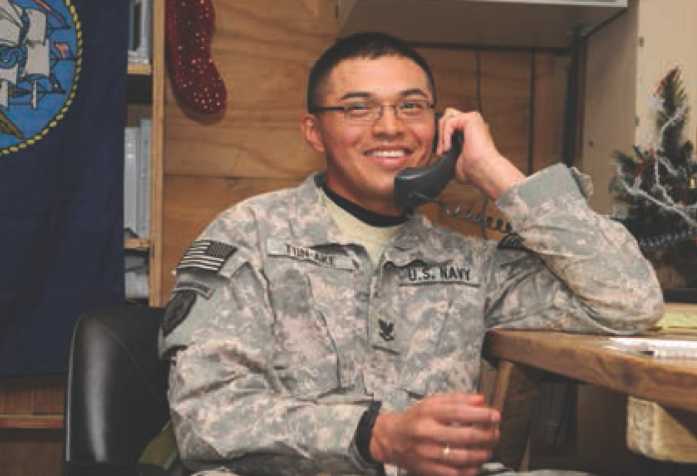
Telephony
Description
The Department of Defense (DoD), Chief Information Officer (CIO) Memorandum of November 5, 2015 "DoD CIO Capability Priorities for Fiscal Years 2018-2022" lists as a priority the modernization of network infrastructure to be regionally based, centrally managed, and cyber secure. This includes migrating existing infrastructure from time division multiplexing (TDM) to internet protocol (IP) based communications to enable unified capabilities. Telephony procures and integrates commercial-off-the-shelf (COTS) hardware and software to meet the DoD-CIO TDM-to-IP mandate for the Navy. These IP-capable switches will service TDM systems and facilitate connectivity to Public Switched Telephone Network, Navy Marine Corps Intranet, and outside the continental United States (OCONUS) Navy Enterprise Network. All efforts are performed in accordance with policy and procedures articulated in Department of Defense Instruction (DoDI) 8100.03, Chairman of the Joint Chiefs of Staff Instruction
(CJCSI) 6212.01 and CJCSI 6215.01D and DoD Unified Capabilities Requirement 2013. Specific Telephony capabilities include: Voice over Internet Protocol; Voice over Secure Internet Protocol; Video Teleconferencing over Secure Internet Protocol; Telephony unified Messaging System; Regional Telephony Management System; Navy Video Conferencing System and NVCS Coalition; IP Trunking; Aegis Ashore; Telephony systems infrastructure (e.g. cable plant); C2 voice communications to the Navy warfighter, including multi-level precedence and preemption; Telecommunications engineering support for Base Communications Office locations; and C2 shore-to-ship dial tone "Plain Old Telephone Service" and pier side lines via tactical networks and infrastructure. Telephony system installations and/or upgrades are being implemented at facilities in accordance with requirements as identified by Navy Information Warfare Forces, Office of the Chief of Naval Operations, and Missile Defense Agency (e.g., fleet network operations centers, fleet telecommunications sites, and Aegis Ashore sites).
Status
Telephony is modernizing the CONUS/OCONUS infrastructure from legacy TDM to IP capability to support unified capabilities requirements. As Telephony capabilities migrate to IP-based transport, telephony services will become increasingly dependent on Navy Enterprise Services.
Developers
Space and Naval Warfare Systems
Command, PEO C4I and PMW790 San Diego, California
* * * * * * * * * * * *

BATTLESPACE AWARENESS
Airborne ASW Intelligence (AAI)
Description
Airborne anti-submarine warfare (ASW) intelligence rapidly develops and fields prototype ASW acoustic intelligence (ACINT) systems that collect, process, exploit, and disseminate intelligence in order to exploit threat submarine vulnerabilities. AAI is responsible for 70 percent of the Navy's acoustic intelligence collections, 100 percent of active target strength measurement (ATSM) collections, and 100 percent of submarine electromagnetic collections. Additionally, AAI enables environmental characterization as well as rapid prototyping and deployment of advanced ASW capabilities. AAI collections provide input to the Navy's ASW tactical decision aids, oceanographic prediction models, strategic simulations, fleet ASW training, and the development of future ASW sensors. The program additionally supports emergent and special ASW operations. In-service AAI collection platforms in late 2016 include the P-3C Orion and P-8A Poseidon. AAI will also equip the MH-60R Seahawk helicopter for ACINT collections. AAI provides rapid turn-around of tactical intelligence products to Theater ASW commanders for inclusion into tactical decision aids and for all ASW engineering disciplines for performance improvements and development of next-generation ASW weapons systems.
Status
The Airborne ASW Intelligence program maintains calibration of all P-8A and P-3C systems in support of acoustic collections. The program is recapitalizing the Navy Underwater Active Multiple Ping (NUAMP) family of sonobuoys that enables calibrated active sonar measurement of threat submarines for the improvement of ASW modeling, simulations, and weapons systems. In FY 2016, the program designed, developed, and conducted engineering analysis for certification of NUAMP F4/5 sonobuoy and the Acoustic Intelligence Collection Suite (ACS) Block II to be used onboard P-8A, P-3C, and other platforms. NUAMP F1 design and development began in FY 2016 and will complete engineering analysis for certification in FY 2017. AAI will analyze the MH-60R acoustic system for platform certification. The program will continue to make improvements to the Tactical Acoustic Processing Suite used to conduct detailed analysis and mission reconstruction of collected acoustic intelligence data against real-world submarines.
Developers
EAGLE Systems Lexington Park, Maryland
ERAPSCO Columbia City, Indiana
* * * * * * * * * * * *
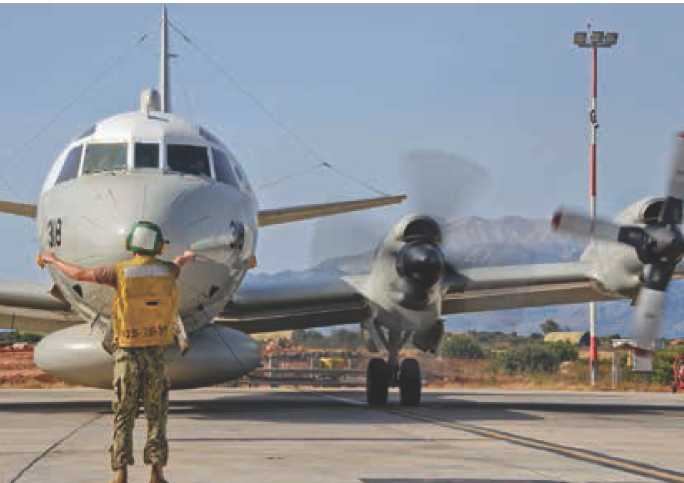
EP-3E ARIES II Spiral 3
Description
The EP-3E ARIES II aircraft is the Navy's manned airborne intelligence, surveillance, reconnaissance, and targeting (AISR&T) platform supporting naval and joint commanders. EP-3Es provide long-range, high-endurance support to carrier strike groups and amphibious readiness groups, in addition to performing independent maritime operations. The late 2016 force consists of one active-duty squadron based at Naval Air Station Whidbey Island, Washington. Although optimized for the maritime and littoral environments, capability upgrades have ensured EP-3E mission effectiveness in support of global contingency operations. The fusion of internet protocol (IP) connectivity, the incorporation of imagery intelligence capability, and completion of significant signals intelligence (SIGINT) upgrades enables continued alignment with the Intelligence Community and the early implementation of a distributed SIGINT concept of operations. Multi-INT sensors, robust communication and data links, and employment on the flexible and dependable P-3C Orion aircraft ensure effective AISR&T support to conventional and non-conventional warfare forces across the range of military operations. With the EP-3E scheduled for retirement after meeting operational requirements through FY 2020, the Navy is focused on sustainment and modernization to pace emerging threats until transitioning the capabilities across the spectrum of manned and unmanned platforms.
Status
EP-3E aircraft are being sustained through a series of special structural inspections (SSIs) and replacement of outer wing assemblies (OWAs). SSIs and OWAs provide the inspections and repairs necessary to ensure safety of light until more comprehensive maintenance can be performed. The pre-emptive modification and replacement of critical structural components allows up to 7,000 additional light hours. These programs ensure sustainment of the EP-3E fleet until the capability is recapitalized across the spectrum of manned and unmanned platforms.
The EP-3E Joint Airborne SIGINT Architecture Modification Common Configuration (JCC) program accelerates the introduction of advanced capabilities to the AISR&T Fleet. The resultant program aligns mission systems to meet the challenges of rapidly emerging threat technology and addresses obsolescence issues. Spiral developments have modernized the aircraft systems. The aircraft is also equipped with forward-looking infrared and remote reach-back capabilities. Recapitalization capabilities migration will allow continued development of the EP-3E and vital testing of equipment designed for use in the next generation of intelligence, surveillance, reconnaissance, and targeting platforms. The final EP-3E will complete the latest JCC upgrade, JCC Spiral 3, in third quarter FY 2017. JCC Spiral 3 enables the EP-3E to pace the enemy threat by providing faster, more precise geo-location capability for better precision targeting, indications and warning, and direct threat warning that can match rapidly developing threat technology.
Developers
Aeronixs Melbourne, Florida
Argon-ST / Boeing Fairfax, Virginia
L3 Communications Waco, Texas
Ticom Geomatics Austin, Texas
* * * * * * * * * * * *
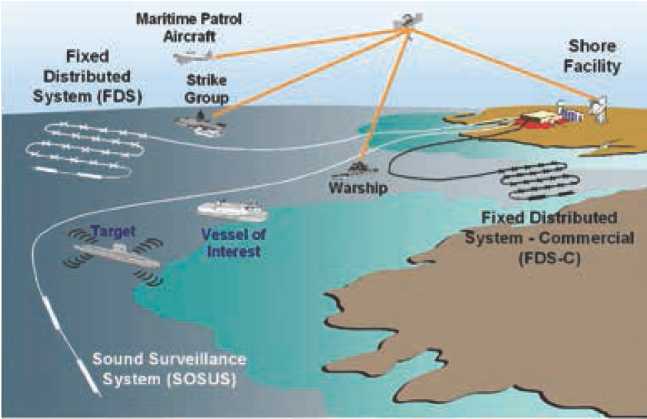
Fixed Surveillance Systems (FSS)
Description
The Fixed Surveillance Systems program consists of the Sound Surveillance System (SOSUS), the Fixed Distributed System (FDS), and the FDS-Commercial (FDS-C), a commercial off-the-shelf version of FDS. FSS provides threat location information to tactical forces and contributes to an accurate operational maritime picture for the joint force commander. FSS comprises a series of arrays deployed on the ocean floor in deep-ocean areas and strategic locations. Due to its long in-situ lifetime, it provides indications and warning of hostile maritime activity before conflicts begin. The system consists of two segments: the integrated common processor (ICP), which handles the processing, display, and communication functions; and the underwater segment, which consists of SOSUS, a long array of hydrophones, and FDS or FDS-C. FSS leverages advances made in the commercial industry to provide a more cost-effective FDS caliber system to meet the Fleet's ongoing needs for long-term undersea surveillance.
Status
ICP technical refreshes are installed as required to provide increased operator efficiency, functionality, and savings in logistics support and software maintenance.
Developers
Multiple sources.
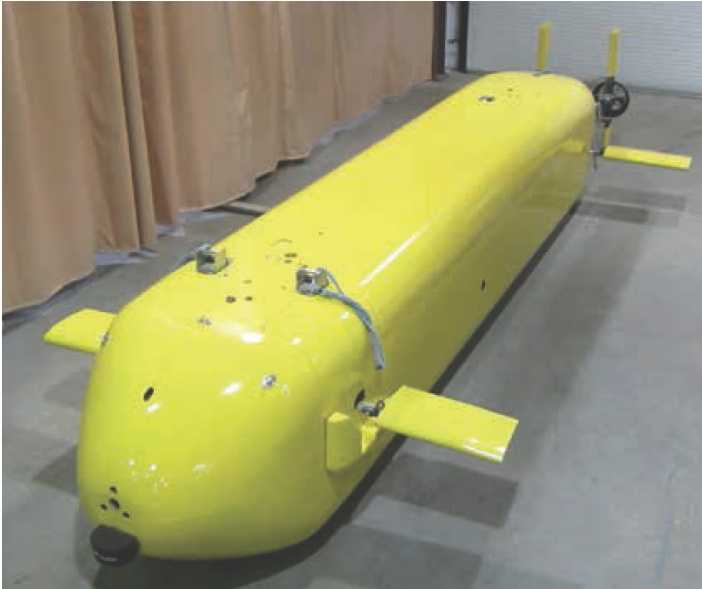
Large Displacement Unmanned Undersea Vehicle (LDUUV)
Description
The Large Displacement Unmanned Undersea Vehicle will provide a robust, long-endurance, persistent, multi-mission, unmanned undersea vehicle capability for the Navy. Like all unmanned undersea systems, LDUUV will expand the undersea forces' operating envelope. LDUUV will complement and augment manned undersea platforms by conducting "dull, dirty, dangerous, and distant" operations, freeing up manned platforms to perform higher-complexity missions. Subsurface and surface platforms will launch and recover the LDUUV. The LDUUV strategy leverages our investments and development efforts across industry, academia and the naval research and development establishment, specifically the efforts by the Office of Naval Research (ONR) LDUUV Innovative Naval Prototype program that started in FY 2011.
Status
The LDUUV completed Milestone A in the fall 2015, after the service capability development document and concept of operations were approved. In 2016, ONR redirected program efforts from award of a contract to industry for engineering development models to a government-led systems integration of prototypes. The prototypes will be delivered in two phases, with industry contributing key enabling technologies.
Developers
To be determined.
* * * * * * * * * * * *
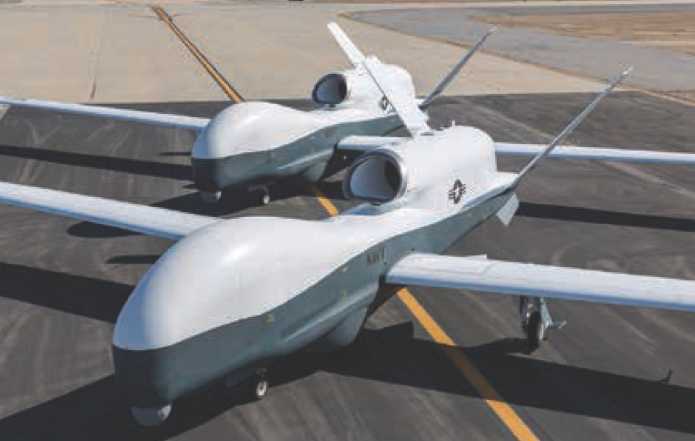
MQ-4C Triton Unmanned Aircraft System (UAS)
Description
The MQ-4C Triton UAS is a key element in the recapitalization of the Navy's maritime patrol and reconnaissance force (MPRF) airborne intelligence, surveillance, and reconnaissance (ISR) capability. Triton will be a force multiplier for joint force and fleet commanders, enhancing their situational awareness and shortening the sensor-to-shooter kill chain by providing a multiple-sensor, persistent maritime ISR capability. Triton's persistent-sensor dwell and ability to network its data, deliver a capability that will enable the MPRF family of systems to meet the Navy's maritime ISR requirements. A single Triton orbit provides continuous surveillance capability at a maximum mission radius of 2,000 nautical miles for a minimum of 24 hours. At full operational capability, the system will provide up to five simultaneous orbits worldwide.
Status
The MQ-4C Triton UAS achieved Milestone B in April 2008 and critical design review completed February 2011. Triton's first flight occurred on May 23, 2013, and initial envelope-expansion lights completed in March 2014. Sensor integration began in December 2014 at Naval Air Station Patuxent River, Maryland. The operational assessment completed November 2015. Milestone C is expected in 2016 along with entry into the production and deployment phase. A baseline Triton early operational capability (EOC) is planned for FY 2018 to be replaced by a Multi-INT Triton EOC in FY 2020. Initial operation test and evaluation begins in FY 2020, and initial operational capability is planned for FY 2021.
Developers
Exelis Baltimore, Maryland
L3COM Salt Lake, Utah
Northrop Grumman Bethpage, New York
Rolls Royce Indianapolis, Indiana
* * * * * * * * * * * *

MQ-8B/C Fire Scout Vertical Takeoff and Landing Tactical UAV (VTUAV) System
Description
The MQ-8B/C Fire Scout VTUAV System is a component of the Navy's airborne intelligence, surveillance, and reconnaissance (ISR) family of systems. The MQ-8 provides day and night real-time ISR target acquisition—using the Brite Star II turret electro-optical/infrared/laser designator-range finder payload and maritime search radar—along with other modular mission-specific payloads for voice communications relay and battlefield management support to the tactical commander. Fielded in two variants (B and C), Fire Scout can operate at a maximum range of up to 150 nautical miles with an endurance of some 12 hours, depending on payload, environment, and air vehicle variant. The VTUAV System comprises one or more air vehicles, a mission control station, UAV common automatic recovery system, tactical common data link, and tactical control system software interface for operator control of the air vehicle. Dual-qualified (MH-60R/S helicopter and MQ-8 VTUAV) members of an aviation detachment from the expeditionary rotary-wing communities operate and maintain the system. The system will conduct launch, recovery, and mission command and-control functions from the Littoral Combat Ship (LCS) or any suitably equipped air-capable ship; it can also be flown from sites ashore to support land-based expeditionary operations. Fire Scout will complement the LCS surface warfare and mine countermeasures mission modules of the LCS or other surface platforms. Additionally, the air vehicle's open architecture will accommodate modular payloads and facilitate integrating future capabilities to support other warfare areas as technologies mature.
Status
The Navy terminated production of the MQ-8B in FY 2011 in favor of a more capable airframe. The decision to terminate MQ-8B production was in response to a joint emergent operational need and payload, range, and endurance upgrades to the Bell 407 (MQ-8C) platform to replace the Schweizer 333-based model (MQ-8B). Flight-testing the MQ-8C began in October 2013 in preparation for its fleet introduction. Additionally, integration and developmental testing of radar and an advanced precision-kill systems continue. Through FY 2016 Fire Scout logged more than 15,000 total light hours, including ten deployments on board Oliver Hazard Perry (FFG 7)-class frigates and two on Littoral Combat Ships.
Developers
Bell Helicopter Ozark, Alabama
Northrop Grumman San Diego, California
Raytheon Falls Church, Virginia
Sikorsky Aircraft Corporation Stratford, Connecticut
* * * * * * * * * * * *
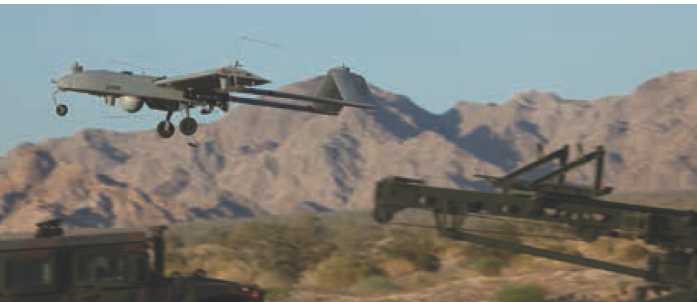
RQ-7B Shadow Unmanned Air System (STUAS)
Description
The RQ-7B Shadow provides intelligence, surveillance, and reconnaissance (ISR) for Marine Corps forces. By partnering with the Army, the Marine Corps realizes fiscal and programmatic efficiencies. Shadow provides day/night full motion video, laser designation, and radio relay to USMC and other ground combat forces, and is fielded to four Marine unmanned aerial vehicle (VMU) squadrons, each of which has three systems.
Status
The RQ-7B is a Group 3 UAS Army ACAT 1C program. It is in its sustainment phase and is completing the Tactical Common Data Link upgrade. This modification not only incorporates the encrypted data link, but it also upgrades many other parts of the system for improved efficiency and increased capability. Two of the VMU squadrons have received the updated systems and a third VMU begins transition in FY 2018. In 2016, Shadow systems surpassed 1 million light hours in combined Army and Marine Corps service.
Developers
Textron Systems Unmanned Systems Hunt Valley, Maryland
* * * * * * * * * * * *

RQ-21 Blackjack Small Tactical Unmanned Air System (STUAS)
Description
The Blackjack system is an asset organic to Navy Special Warfare, Navy Expeditionary Combat Command, and Whidbey Island (LSD 41)-class ships to provide tactical intelligence, surveillance, and reconnaissance capability. Blackjack vehicles are equipped with electro-optic/infrared sensors, laser range finders and illuminators, automatic Identification system (AIS), and a communications relay. A system consists of five air vehicles, one (ship) or two (shore ground) control stations, launch and recovery system, spare parts, and government furnished equipment. The Blackjack is a 75-pound/16-foot wingspan vehicle (135 pounds fully loaded) capable of 15 hours endurance at 55 knots at altitudes higher than 15,000 feet.